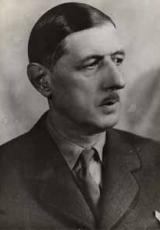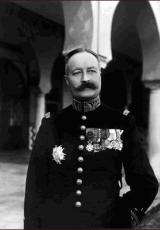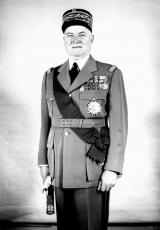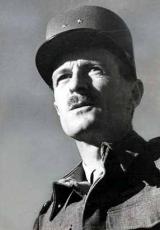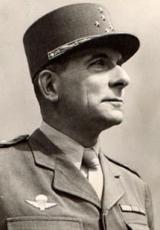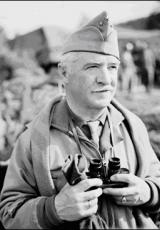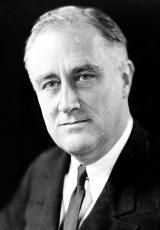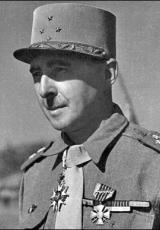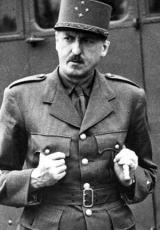Rebuilding the French Army (1943-1945)

The military capability, the political instrument and operational control
By Tristan Lecoq
Inspector-General of National Education
Associate lecturer in contemporary history
at Paris-Sorbonne University
Rebuilding the French army, from the beginning of 1943 to victory in 1945, meant addressing three questions. To rebuild an army to liberate the country: this was the inter-Allied, military dimension of Liberation; to rebuild the Army of the Republic: this was the issue of a military ”capability”, under the command of the political authorities; to rebuild the Army of France meant rebuilding an instrument of a power which itself needed reconstructing.
The army is above all a political instrument, which reports to a political authority and is at the service of State policy. It is at the heart of sovereignty and therefore the means of exercising that sovereignty. ”Defence! It is the State's primary raison d'être. It cannot neglect it without destroying itself,” General de Gaulle would say, on 14 June 1952, in Bayeux1.
From this standpoint, what was the situation in November 1942, following the Allied landings in North Africa? A French State entirely occupied from 11 to 27 November, without the Empire, without the Navy, then a militia government in the pay of the occupier. A Free France, combatant from July 1942, but which received mixed acceptance and recognition from the Allies and the USSR. An Empire rallied to Free France, then to the French Committee for National Liberation, from July 1940 to spring 1943, in the midst of conflict and disputes among the French.
A divided political authority that was insecure overseas. Several armies in very different states. Contenders in Algeria who, from November 1942 to June 1943, all sought the support of a military force: Darlan, Giraud, de Gaulle.
So the crux of the matter was the relationship between political and military power, which was only reconciled, with difficulty, in June 1943. It was also a question of the relationship between a French army and a military coalition, which was only resolved - with difficulty, belatedly and incompletely - after the liberation of Paris, when the Provisional Government of the French Republic was recognised by the United States, on 23 October 1944. From then on, the place and role of the French Army, which needed rebuilding, and was rebuilt between 1943 and 1945, were the subject of bitter discussions among the French, between the French and the Allies, and amongst the Allies themselves2. De Gaulle and Giraud. De Gaulle and the Allies. Paris, Strasbourg, the Rhine and Germany.
Beyond the political question: what role should the French Army have in the liberation of France? Military: what role should the French Army play in the Allied operations? The equation to be solved had to do with the autonomy or dependence of a French army vis-à-vis the Allies, to whom it owed, to a large extent, its revival and operational capabilities.
To rebuild the army, therefore, meant casting a new military capability. To liberate France and march on the Rhine was to use the army as a political instrument, even if it was part of a coalition.
The issue of the operational control of the French troops by the Allied command bridged these two sides of the same complex political, military and warring relationship: it was a question of the military dependence, interdependence and independence of the French Army in the fighting, between 1943 and 1945.
1. Rebuilding the French Army: the issue of military capability
The land army which was reborn was the Army of Combatant France, the Army of Africa and a brand-new new army, all at once.
Two conceptions of the army quickly gained currency, from early 1943 onwards. For General Henri Giraud, there was ”one goal alone: victory!”3. The French Army had to be rebuilt. Nothing else mattered. For Charles de Gaulle, the refusal of defeat, French unity in resistance, by liberation and for victory, and the assertion of French sovereignty, were all part and parcel of the same thing; from the outset, de Gaulle could conceive only of a rebuilt French army under his authority.
The matter was resolved by subordinating the military to the political, once the French Committee for National Liberation (CFLN) was established in June 1943, General de Gaulle had garnered support the support of the French Resistance through its National Council, and General Giraud had been restricted, more or less willingly, to military affairs alone. However essential they were, they could only be decided by a political authority. The question was raised at the time of the landings in Corsica, in September 1943. The response came on 6 November, with the political taking precedence over the military within the CFLN.
The reality at the beginning of 1943, however, was of a war waged by the Anglo-American and Soviet Allies. It was in this context that the Americans played the Giraud card: Weygand, without Vichy. Because it was General Weygand's intention to put a French Army back into combat, but not France, as General de Gaulle intended. From this standpoint, the Casablanca Conference logically also discussed Allied support for the military modernisation of the French Army, unified in August 19434.
At the United States' request5.
The plan was for seven infantry divisions and four armoured divisions to be constituted. In early 1944, five infantry and three armoured divisions were formed: the 1st Provisional Infantry Division (formerly the 1st Free French Division), 2nd Moroccan Infantry Division, 3rd Algerian Infantry Division, 4th Moroccan Mountain Division and 9th Colonial Infantry Division, and the 1st, 2nd and 5th Armoured Divisions.
These divisions gave birth to the two major units that were Army ”A”, transformed into the French Expeditionary Corps in Italy, under the command of General Alphonse Juin, and Army ”B”, commanded by General Jean de Lattre de Tassigny.
However, there were three problems: (1) the proportion of ”native” soldiers in these units, often making up more than half of troops - which did not suit the Americans; (2) the fact that the mobilisation focused, in the main, on North Africa6; and (3) the amalgamation of French North African troops with the military forces of combatant France7.
The latter question is by far the one that has been most written about. Without wishing to question or diminish its importance, it deserves to be complemented by a look at the aspects of equipment, management and organisation, to focus on the main issue of how this rebuilt French Army would be used in the operations. Apparently a military question, it was in fact political, because it concerned the degree of dependence of the French Army towards the Allies, their strategy, how their forces were equipped and structured, and the operational planning inherent to all of this.
From September 1943, the cornerstone of the US strategy on the ground was the reorganisation of the armoured divisions, the spearhead of the US Army, into Combat Commands, comprising both combat arms (infantry and armour) and support arms (artillery, engineers, signals), These combined-arm forces were interoperable, including among Allies, since all the Allied military forces in the western theatre were structured in the same way. This meant that, depending on the needs of an operation, the Combat Commands could switch from the operational control of one major unit to another.
From 1942, the organisation of the infantry divisions rested on extensive motorisation, powerful artillery and a regiment-based, ternary structure8.
The corollary to the flexibility, firepower and mobility of these units was their formal, logistical and operational integration within an integrated whole, and all decisions concerning planning, deployment and operating conditions were taken by the Allied - i.e. British and American - commanders alone.
By 1943, then, it was clear that the French troops would be equipped, organised and trained as part of US planning and arrangements. The French regiments, with their long and fine military traditions, may have lived on, but it was a new army that was founded, in the context of the new conditions of combat on the Western Front. In May 1945, reinforced by troops from the French Forces of the Interior, 1.3 million French soldiers formed part of a French army integrated within an Allied operational strategy9.
The French government's room for political manoeuvre was in proportion to that integration.
The situation for the French air force and navy was even more clear-cut.
The air force was re-equipped by the Allies - largely the Americans - fully integrated into the Allied air formations, and subject to Allied operational planning. The same was true of the navy, which had no say in the operational planning of Allies who restricted its rearmament.
In November 1942 - with the exception of the Free French Air Forces, equipped by the British, trained by the British and, for the most part, incorporated into the Royal Air Force - the equipment available in French North Africa was out of date and many of the techniques and concepts for use were foreign to the French pilots, who had been away from modern warfare for over two years.
From January to June 1943, the American re-equipping of the French was slow. This can be explained by a number of factors: priority given to training American pilots, priority given to equipment for US forces in Great Britain and, also, a degree of doubt as to the loyalty of certain French pilots. Armed only with modern Curtiss P-40 fighters, hadn't two of them - what's worse, members of the Lafayette Fighter Group - rejoined Vichy on 11 January 1943?
The French air forces, organised into ”groups” on the Allied model, were incorporated into the Allied formations and brought under the major operational commands: Bomber, Fighter, Reconnaissance and Transport. The same applied to the Normandie-Niemen Regiment, which fought alongside the Soviets on the Eastern Front. However, more often than not, air cover of the First Army, in the German Campaign, was provided by the French Air Force: a French Tactical Air Command. Under Allied operational control, of course10.
How to rebuild - from scattered, disparate, often out-of-date elements - a French Navy, in 1944? In June 1943 - not including the Free French Naval Forces (FNFL), which became the Naval Forces in Great Britain (FNGB) and were incorporated into the Royal Navy - the total naval forces of the French Empire barely reached 250 000 tonnes. Less than half of the French Navy of 1939. And what a state they were in! Moreover, how to rebuild a single Navy, when the Navy that remained loyal to Marshal Pétain had, more visibly and more politically than the other armed forces, given its support to the Vichy regime, a dishonest compromise with the Occupier, a fine line which had almost seen the balance tipped in favour of a war fought alongside the Germans?11
Here, too, things were straightforward. A headquarters in Algiers, completely subordinate to the Americans. Modernisation at the discretion and according to the preferences of the Americans. The result: in June 1944, 350 000 tonnes of warships of mixed worth.
Naval rearmament was carried out under political control, in proportion to the importance attached to the navy and naval matters by Franklin D. Roosevelt and Winston Churchill, both former navy ministers12. In particular, no aircraft carriers and no naval air force, even though aircraft carriers had been the main ship in battle fleets since 1941 and the mark of a country's power! The new units were light units, for subordinate missions, in a war in which the maritime component was crucial to the United States and Great Britain.
Total subordination to the orders of the Allied command13.
It was in this context that the soldiers of the French Army in Tunisia and Italy escaped the French quarrels, demonstrating their operational qualities: those of a tough infantry skilled at manoeuvres, an effective artillery and a well-trained, well-commanded force; in other words, those of Frenchmen proving they could still be good fighters. Yet under the orders of the Allies.
In Tunisia, from November 1942 to May 1943, the fighting was waged by Weygand's Army. An Army equipped, trained and run just like in June 1940. The 19th Army Corps conducted a delaying action to enable the British to reach the north, the Americans the centre and the British and Free French the south of the theatre of operations. Against this backdrop, the requirement to conform to the demands of the US operational command, in February 1943, was seen by French military leaders as the price to pay for the resources necessary to air and land rearmament.
The joint offensive from Algeria and Libya took time, in proportion to a form of American inexperience which was quickly compensated for on the ground. Tunis fell on 7 May 1943. 250 000 German and Italian soldiers fought fiercely before being taken prisoner. Stalingrad in Tunisia…
The US commanders learnt one lesson from the Tunisian campaign: that there needed to be the firmest possible unity of command and operational control of the forces. General Dwight Eisenhower would be the architect.
The Italian campaign got under way in markedly different political circumstances. The CFLN had been in place since June 1943. The landings in Sicily took place in July 1943. In September, Italy changed sides. In December, French units joined the fighting. Rome was taken on 4 June. The Italian operations up until May 1945 focused on a number of German units, before the Allied command took the decision to engage the ultimate test, in France or in the Balkans. Meanwhile, relations between the American and British commands had become strained over the issue of the strategy in the Mediterranean14. The French position counted little in these discussions, which were not only military.
The entire French Expeditionary Corps was ready in February 194415: 112 000 men, 52% of Maghrebin origin. In June, the French mountain troops outflanked the German defences. It was General Juin who had succeeded in convincing the Allied command that they must cease the frontal assaults on Monte Cassino and adopt a tactic of combat from on high, followed by penetrations, in order to outflank the enemy.
Nevertheless, in Tunisia as in Italy, the French Army may have had a role in the war, but that role was a militarily, materially and operationally subordinate one, in relation to the Allies and, ultimately, the Americans. Were the French steeling themselves for the campaign to come, which had far more at stake in the context of a total war, far greater numbers of troops and further reinforced operational control?
2. The campaigns of the Liberation: the Army as a political instrument
Paris and Strasbourg were liberated by Leclerc and a remarkable unit of the Allied armies: the 2nd Armoured Division; the Rhine and the Danube, by de Lattre and the Army of Africa, as part of the overall operation by the Allied forces; the forgotten campaigns, on the margins of the victory, were the Atlantic pockets, the fighting in the Alps and the paddy fields of Indochina.
Formed in Temara, Morocco, and trained in Aintree, England, the 2nd Armoured Division landed in France in August 1944. Heir of the ”Leclerc Column” and ”Force L”, equipped, trained and led by the Americans, its history, composition and spirit made it both the most Gaullist and the most political of the major French units of the Second World War.
In it, the soldiers of Free France fought alongside cuirassiers, chasseurs d'Afrique, spahis16 and naval fusiliers - and it was Spanish Republicans of the 9th Company 1st Battalion of the Régiment de Marche du Tchad (Chad Infantry Regiment) who would ensure the security of General de Gaulle on the parade of 26 August. It fought under the flags of the Spanish and French Republics, therefore, and was commanded by a Picardian aristocrat who was an officer by education, a Frenchman by tradition and a rebel by vocation17.
What was at stake was the liberation of French territory, the seizing of political power and the military victory.
Organised into three heavy and one light combat commands, perfectly integrated into General Patton's army and American operational methods, the 2nd Armoured Division fought in Normandy and very quickly showed itself to be an exceptional unit, formed of exceptional soldiers and with an exceptional leader. It was perhaps mainly on the basis of this military recognition that the US commanders, Generals Eisenhower, Bradley and Patton - not without some hesitation - allowed the 2nd Armoured Division to reorientate the Allied objectives to the liberation of Paris - even though the city was no longer of any strategic interest, the Battle of Normandy was over, and the German Army was retreating eastwards.
On close analysis, General de Gaulle's reasons for using a French unit were more political than military, in the eyes of the Allies at least. Fully integrated into the US forces in material, logistical and operational terms, Leclerc freed himself from the American yoke on a political level. On 24 August 1944, he was outside the hierarchy. Fully dependent, fully interdependent, fully independent18.
The battle for the liberation of Paris was not a costly one, fought as it was against an irresolute enemy who sought an honourable way out. It was the backdrop to what were, for the most part, strained relations between the French Government and its Army, the remnants of Vichy, the Americans and the various resistance organisations (Front National, communists, internal Resistance, and National Council of the Resistance). Thus it was very much the result of a political enterprise, spearheaded by the 2nd Armoured Division and supported by the US 4th Infantry Division. Nevertheless, if it was wanted by de Gaulle and accomplished by Leclerc, it was the Allied commanders, not least General Eisenhower, who made it possible19.
Continuing towards eastern France, still among the ranks of the American forces and under their operational control, the 2nd Armoured Division reached Dompaire on 13 September, the Col du Dabo pass on 19 November, and Strasbourg on 23 November, thus honouring the ”Oath of Kufra” (not to lay down their arms until the French flag flew over Strasbourg Cathedral).
The final allegro vivace took Leclerc's soldiers as far as Berchtesgaden, in May 194520.
How different from this remarkable unit was General de Lattre's First Army! The direct heir of the Army of Africa and its regiments and traditions, France's 1st Army had at its head a leader who had rejoined combatant France following the occupation of the Free Zone, on 11 November 1942. It was similarly equipped, organised and trained by the Americans, and its objectives and operations were fully integrated into the overall planning for the Allied theatres of operations.
General de Gaulle recognised as much in his memoirs, writing: ”The British and Americans never consented to treating us as true Allies. They never consulted us, government to government, on any of their arrangements. [...] [T]hey sought to use the French forces for goals which they themselves had set, as if those forces belonged to them, claiming that they contributed to arming them.”21
While it was true that General de Gaulle had pushed for French landings in Provence, whereas the British, and Winston Churchill in particular, preferred the Balkans, it was very much an Allied - i.e. American - decision. Even so, French military involvement in the landings of August 1944 made them the most French of all Allied operations in the war - an operation planned by the command of the US Seventh Army, in which Army B was the spearhead.
In view of the stretched formation of the German 19th Army, without air support, which on 18 August had been ordered by Adolf Hitler to retreat, the Allied operations in Provence went not only according to plan, but appreciably ahead of schedule: Marseille fell 16 days earlier than planned, and Toulon seven days earlier, thanks to a superb manoeuvre by de Lattre's troops22.
Army B, renamed the First Army on 19 September 1944, then headed up the Rhône Valley into eastern France. Here it would gain a degree of tactical autonomy, like the major British, Canadian and American units, while remaining under the tight operational control of the Allied command.
To cross the Rhine and invade Germany: these were the otherwise difficult objectives that General de Gaulle assigned to de Lattre, summarising them in his inimitable fashion, with the words: ”All that remained was the crucial bit: to cross the Rhine.”23
The last six months of the war were, for both sides, the bloodiest, as exemplified by the bitter fighting of winter 1944-4524. Operations like the attack on the Colmar Pocket, from 23 January to 10 February 1945, ordered by de Lattre, resembled suicide missions. In the course of these operations, the 2nd Armoured Division, detached to the First Army, also suffered heavy losses by being sent into action in inappropriate conditions. It is understandable why General Leclerc preferred to fight alongside the Americans25.
It should also be emphasised that the French Army faced two simultaneous issues: the integration of troops from the French Forces of the Interior (FFI) and the ”whitening” of the French units of the First Army with the return home of soldiers from sub-Saharan Africa. Those from French North Africa remained.
The disarmament of all non-military groups had been decided by General de Gaulle on 28 August 1944, for political and military reasons. It would not be a people's army, but an Army of the Republic.
Of a total of nearly 300 000 members of the FFI, 190 000 were enlisted, 137 000 of them in the First Army, in autumn and winter of 1944. The Francs-Tireurs et Partisans (FTP) found themselves in the 151st Infantry Regiment (previously commanded by de Lattre!), while Colonel Berger (alias André Malraux) was put in command of the Independent Alsace-Lorraine Brigade. They joined the 250 000 troops of this major unit, making up for the loss of the sub-Saharan African soldiers, whose departure had left a feeling of abandonment, as well as physical and psychological anguish.
On the orders of General Devers, of the US Sixth Army Group, which also comprised General Patch's Seventh Army, de Lattre fought in eastern France. There, in January 1945, he received the order from General de Gaulle to maintain some French troops in Strasbourg, liberated by the 2nd Armoured Division in November 1944, at a difficult point in the Battle of the Bulge.
This was the second time the head of the French government had intervened in the course of Allied operations, and once again the French arguments were accepted by the Allied command, and the First Army remained in the same subordinate position, as part of an Allied strategy that was fully integrated at all levels - material, logistical and operational. De Gaulle recognised this in a matter-of-fact way: ”[F]or the operations, our field forces were placed within the Western strategic system.”26
The general's third intervention, in April-May 1945, concerned the First Army's role in the final offensive.
As de Gaulle himself put it: ”Our troops, too, had to cross the Rhine. We would do so as part of the Allied strategy, if possible. If not, we would do so off our own bat. Either way, they must seize a French zone of occupation on the eastern bank.”27
The military realities of operations that were necessarily inter-Allied, the fierce fighting of the Wehrmacht, the operational capacities of the French, and relations that were a mixture of impatience, exasperation and admiration between General de Lattre and his American superiors, would determine otherwise. Despite friction and clashes, the First Army would remain under US operational control until the end of the Allied invasion of Germany28.
Which leaves the forgotten campaigns.
In the Alps, passes were by turns liberated, lost and re-won by French troops from the FFI with inadequate equipment, training and leadership. De Gaulle pushed them towards the Col de Tende, La Brigue and Val d'Aoste: objectives linked as much to the military ridge line as to territorial claims and the post-war situation. US operational control may have been less overbearing than elsewhere, but the United States government and its generals made it clear to the French government that it had limited room for manoeuvre, even bringing up the possibility of the supply chain being broken and rearmament being interrupted.
That was not the case on the ”Atlantic Front”. General de Larminat, commander of the French forces there, dealt directly with the Allied command on the planning and execution of the operations, calling on the Allied forces wherever necessary for support. It was a French affair, and therefore secondary. Most of the fighting, up until May 1945, involved French units of the land forces, many of them originally from the FFI, air force and navy. The 1st Free French Division and combat commands of the 2nd Armoured Division, under French operational control, also intervened on this front to help wipe out the German ”pockets”, once and for all!
In Indochina, the Japanese occupation of this crucial staging-post between Malaysia and Japan, the weak operational capability of the French military forces that had rallied to the Provisional Government of the French Republic, the unlikelihood that Allied aid would be forthcoming and, above all, the coup of 9 March 1945 led, after a brief but bloody campaign in March and April, to a French military vacuum. The inter-Allied question of what would become of the colonial military might was to be dealt with by Admiral Lord Louis Mountbatten, Supreme Allied Commander of the South East Asia Command.
A French Army rebuilt at the instance and on the terms of the Allies - the British and, above all, the Americans. A French Army subject to the material and logistical availability, operational constraints and usage concepts of the Allies. A French Army under the operational control of the Allies, from the beginning to the end of Liberation.
On three occasions - Paris, Strasbourg and the Rhine - Charles de Gaulle succeeded in making his government's political authority prevail over the Allies, by employing arguments that they wanted to hear. However, from 1945, France began to reap the consequences of a military capability which allowed it neither national independence, nor strategic autonomy, nor even a role in planning the operations.
At bottom, in Paris, Strasbourg and the Rhine, Germany, Italy and Indochina, the operational control of a French Army that had regained the military respect of the Allies was subject, on a tactical level, to the national demands made by General de Gaulle. On condition that they did not undermine Allied operational planning or, above all, as the war reached an end, set a precedent for after the victory.
Liberation was a military victory of the Allied armies, with the participation of a French Army integrated in the overall operation and the internal order ensure the General de Gaulle and his government. The French Army was the Army of Liberation.
But the shadow of June 1940, of Vichy and military collaboration, of four years of Franco-French fighting, resulted in a political and military purge. The court cases of Liberation affected the Army. Not only the Pétain case, but those of admirals and generals who served Vichy and Germany. Civil war may have been avoided, but dissension among the French might nevertheless carry the day over a victory which was in many respects ambiguous and whose military dimension seems to have been quickly erased.
What a difference between how the two world wars ended! In 1918, a US Army equipped, trained and led by the French, integrated into the Allied strategy, but, at the suggestion of General Foch, allowed considerable room for manoeuvre by the Allied command in the course of operations. Having arrived in France in 1917 with the world's third largest navy but no real army or air force, the Americans left in 1918 with a complete military capability29. The French Army of 1945 was entirely dependent on the Americans, materially, logistically and operationally.
This was the backdrop to the question of the future of the French Army after victory. The construction of a military capability, the experience of its effectiveness in combat and its dependence on the Allies from 1943 to 1945, are linked. What did France need an army for? What would be its materials, its leadership, its concepts of use? What alliances would it belong to?
The war confirmed the role of armoured units organised American-style, with air cover on the Western Front. The naval air-force dimension of control of the seas was also an important consideration, as was the need to have intervention forces stationed overseas. Should the French Army be rebuilt on these bases, or should the existing armed forces be kept as they are, i.e. integrated and dependent?
The military capability, power and position of France are all directly interrelated. France was not present at Dumbarton Oaks, Yalta or Potsdam. The issue of the French zone of occupation was not resolved until July 1945, even though de Lattre returned to Stuttgart and Karlsruhe in April and countersigned for France, in Berlin, on 8 May 1945. At the same time, as the war continued in the Pacific, riots broke out in Sétif, Algeria, and crisis erupted in the Levant.
There were so many questions facing France in 1945, all of them with an obvious military dimension. So many political questions which, from the way they were - or were not - responded to, shed light on the military choices of post-war France.
The absence of a response that was up to his expectations was behind Charles de Gaulle's resignation, in January 194630. It was also behind the thorough reforms of the military which he undertook upon his return to power. Finally, it was one of the aspects of the decisions which he took, towards national independence, between 1958 and 1966.
1 Charles de Gaulle, Discours et messages Tome II Dans l'attente 1946-1958 Paris, Plon, 1970, p.527
2 Fondation Charles de Gaulle, De Gaulle chef de guerre. De l'appel de Londres à la Libération de Paris 1940-1944 Actes du colloque des 8, 19 et 20 octobre 2006 Paris, Fondations Charles de Gaulle, Plon, 2008
3 Général Henri Giraud, Un seul but, la victoire ! Alger 1942-1944 Paris, Julliard, 1949
4 André Martel (dir.), Histoire militaire de la France, Tome 4, De 1940 à nos jours, Paris, PUF, 1994, en particulier le chapitre IV La Libération et la Victoire : ”Quoi ? Les Français aussi ?” pp. 175-237
5 Marcel Vigneras, ”Rearming the French” in US Army in World War II Special Studies, Washington DC, Center of Military History United States Army 1956/1989
6 Vingt-sept classes d'âges, de 1919 à 1945, sont appelées sous les drapeaux.
7 Christine Levisse-Touzé, L'Afrique du Nord dans la guerre, 1939-1945, Paris, Albin Michel, 1998.
8 Kent Roberts Greenfield, Robert R. Palmer and Bell I. Wiley, ”The Organization of Ground Combat Troops” in US Army in World War II, Center of Military History United States Army Washington DC, 1987
9 Jacques Vernet, Le réarmement et la réorganisation de l'Armée de terre française (1943-1946), Vincennes, SHAT, 1980
10 Patrick Facon, L'Armée de l'air de la victoire, 1942-1945, Paris, Economica, 2006
11 Etudes marines n°4, ”L'histoire d'une révolution. La Marine depuis 1870”, Paris, Centre d'études supérieures de la marine, mars 2013
12 Richard Hough, Former Naval Person : Churchill and The Wars at Sea, London, Weidenfeld and Nicholson, 1985
13 Philippe Masson, La Marine française et la guerre, 1939-1945, Paris Tallandier, 2000
14 Julie Le Gac, Vaincre sans gloire. Le corps expéditionnaire français en Italie (novembre 1942-juillet 1944), Paris, Les Belles Lettres, 2013
15 Colonel (ER) Pierre Le Goyet, La campagne d'Italie. Une victoire quasi inutile, Paris Nouvelles Editions latines, 1985
16 Le quart de la 2ème DB est composé de troupes d'origine maghrébine.
17 Christine Levisse-Touzé, Du capitaine de Hauteclocque au général Leclerc, Actes du colloque des 19-21 novembre 1997, Paris, éditions Complexe, 2000 ; Olivier Forcade, ”Du capitaine de Hauteclocque au général Leclerc” in Vingtième siècle. Revue d'histoire, n° 58, Paris, 1998, pp. 144-146
18 André Martel, Leclerc. Le soldat et le politique, Paris, Albin Michel, 1998
19 Jean-François Muracciole, La libération de Paris, 19-26 août 1944, Paris, Tallandier, 2013
20 Le général Leclerc vu par ses compagnons de combat, Paris, éditions Alsatia, 1948
21 Charles de Gaulle, Mémoires de guerre. L'unité 1942-1944, Paris, Plon, 1956 p.260
22 La libération de la Provence. Les armées de la liberté, Actes du colloque international de Fréjus des 15 et 16 septembre 1994, Paris, Institut d'histoire de la défense/SIRPA, 1994
23 Charles de Gaulle, Mémoires de guerre. Le salut 1944-1946, Paris, Plon, 1959, p.155
24 Du débarquement d'août 1944 à mai 1945, les armées françaises auront fait quelque 570 000 tués et blessés ainsi que 300 000 prisonniers à l'ennemi.
26 Général Jean Compagnon, Leclerc maréchal de France, Paris, Flammarion, 1994
26 Charles de Gaulle, op. cit. p.131
27 Charles de Gaulle, op. cit. p. 158-159
28 Jean-Christophe Notin, Les vaincus seront les vainqueurs. La France en Allemagne, 1945, Paris, Perrin, 2004
29 Claude Franc, Le Haut commandement français sur le front occidental, 1914-1918, Paris, Soteca, 2012 ; François Cochet, La Grande Guerre : fin d'un monde, début d'un siècle, Paris, Perrin, 2014
30 De Gaulle et la Nation face aux problèmes de défense, Actes du colloque des 21 et 22 octobre 1982, Paris, Institut Charles de Gaulle et Plon, 1983
Tristan Lecoq
Inspector-General of National Education
Associate lecturer in contemporary history
at Paris-Sorbonne University

Henri Giraud, Franklin Roosevelt, Charles de Gaulle et Winston Churchill à la conférence d'Anfa, du 14 au 24 janvier 1943.
© collection particulière

Déplacement du général de Gaulle sur le front italien. Mai 1944.
© ECPAD, photographe SCA. Réf. : TERRE 222-4905

Sur le port d'Alger, le général d'armée Henri Giraud, commandant en chef civil et militaire, se tient devant un char Sherman M4 amériain livré à l'armée française, le 17 avril 1943.
© ECPAD, photographe inconnu. Réf. : TERRE 34-618
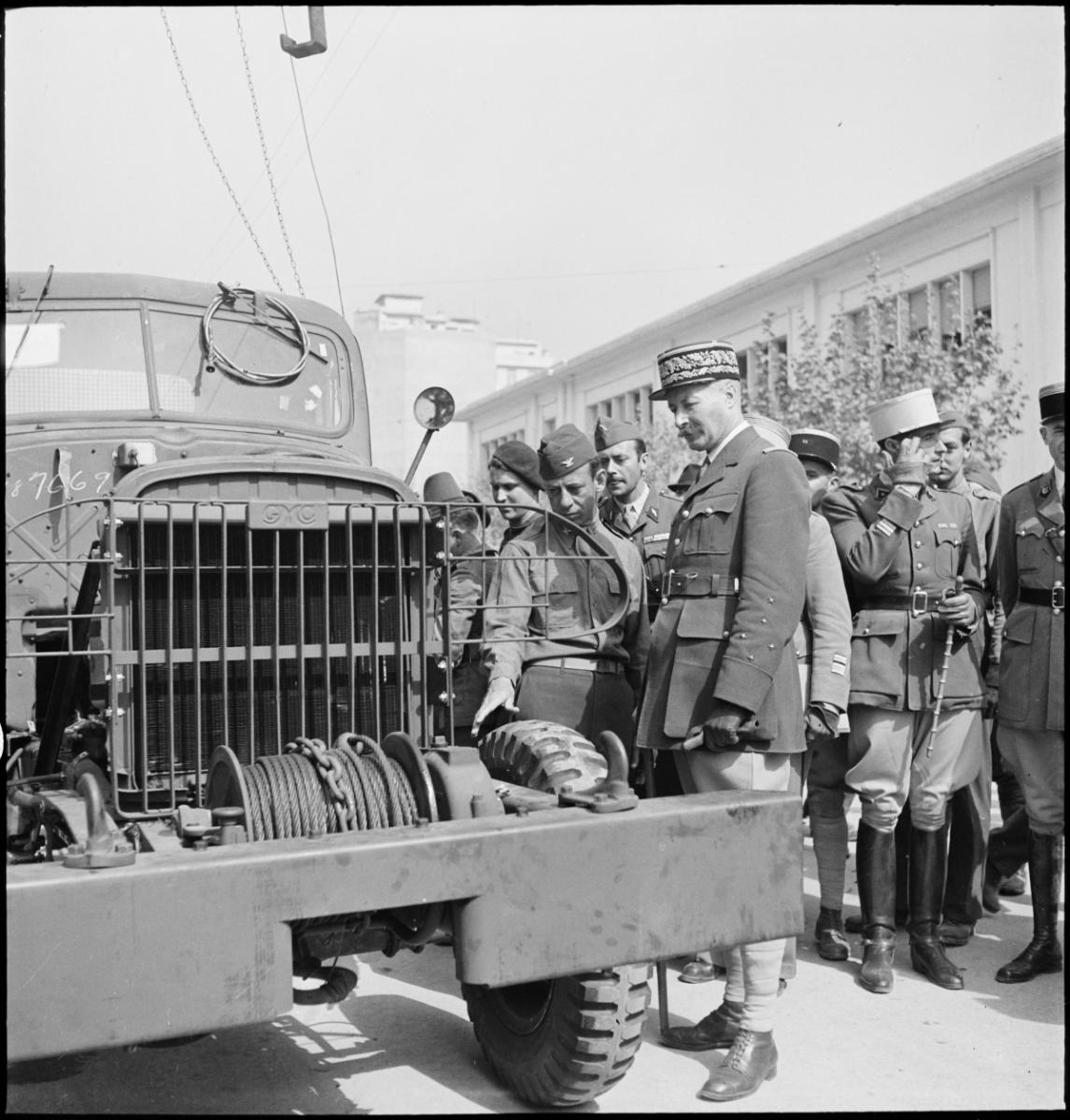
Le général Giraud en visite sur une chaîne de montage de matériel américain sur le port d'Alger, le 17 avril 1943.
© ECPAD, photographe inconnu. Réf. : TERRE 34-630
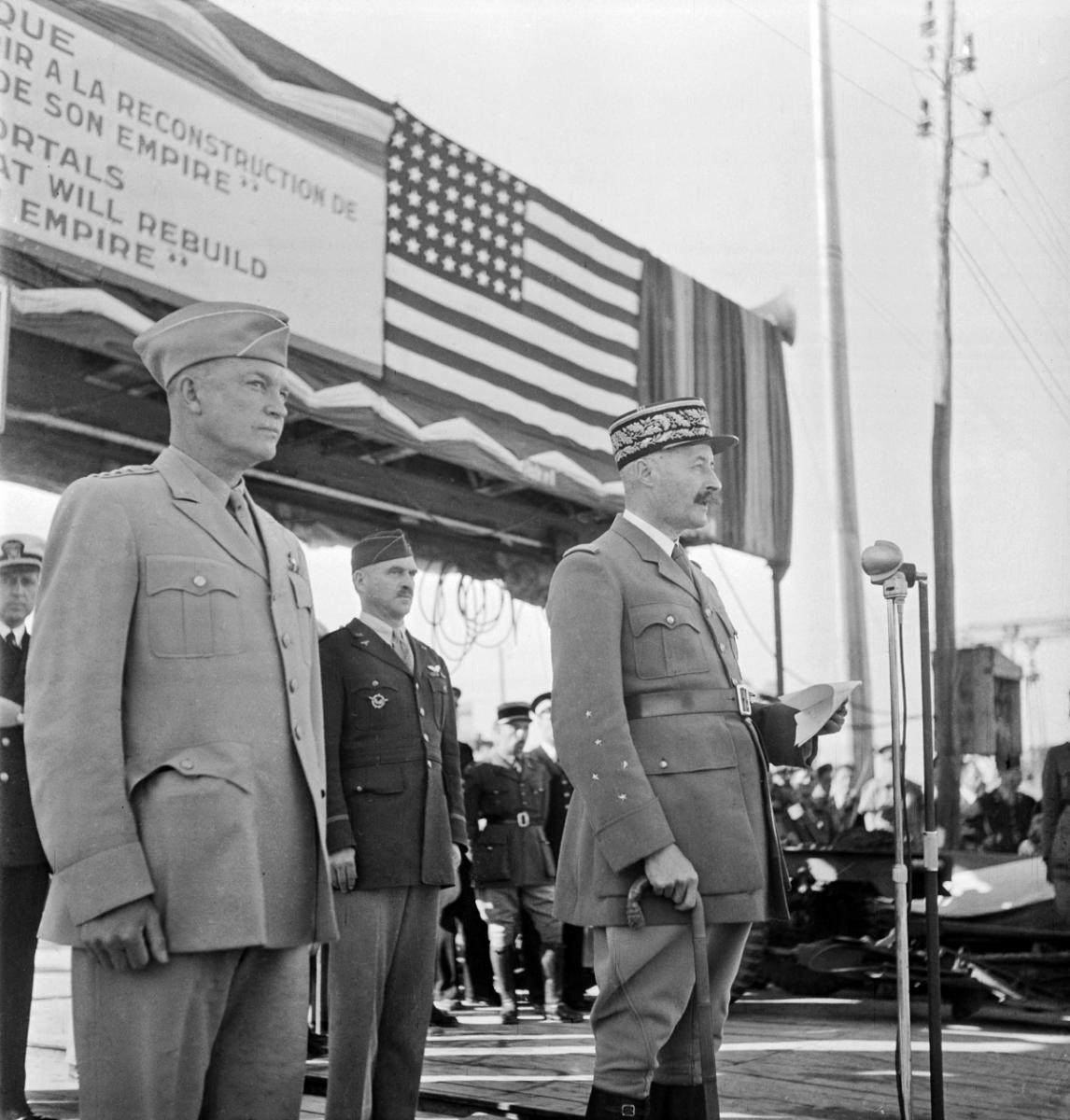
Cérémonie de remise de matériel américain aux troupes françaises en présence du général d'armée Henri Giraud et du général Dwight Eisenhower. Algérie, le 8 mai 1943.
© ECPAD, photographe SCA. Réf. : TERRE 51-983
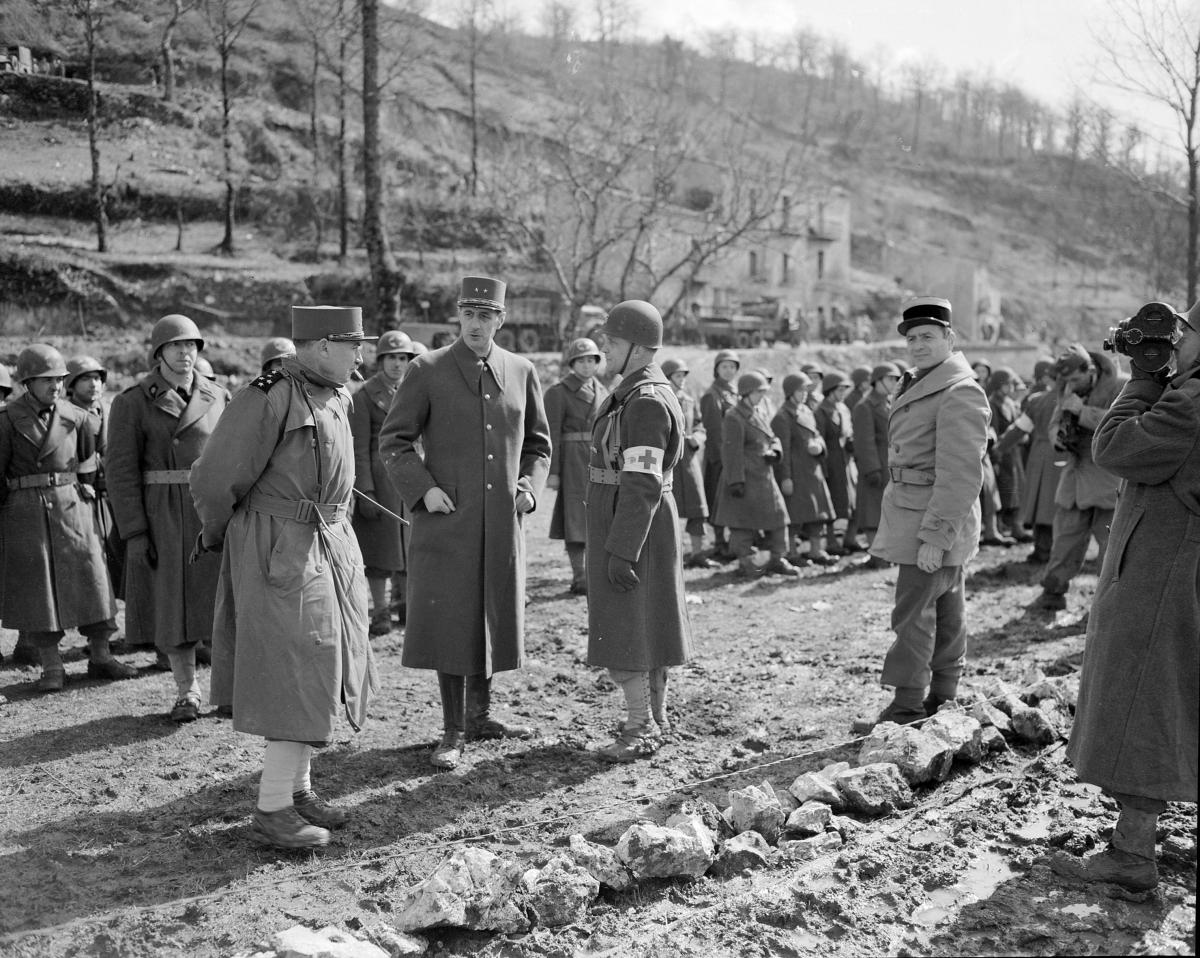
Le général de Gaulle s'entretient avec le médecin commandant le 3e bataillon médical de la 3e DIA (Division d'infanterie algérienne) en Italie. Mars 1944.
© ECPAD, photographe SCA. Réf. : TERRE 175-3758
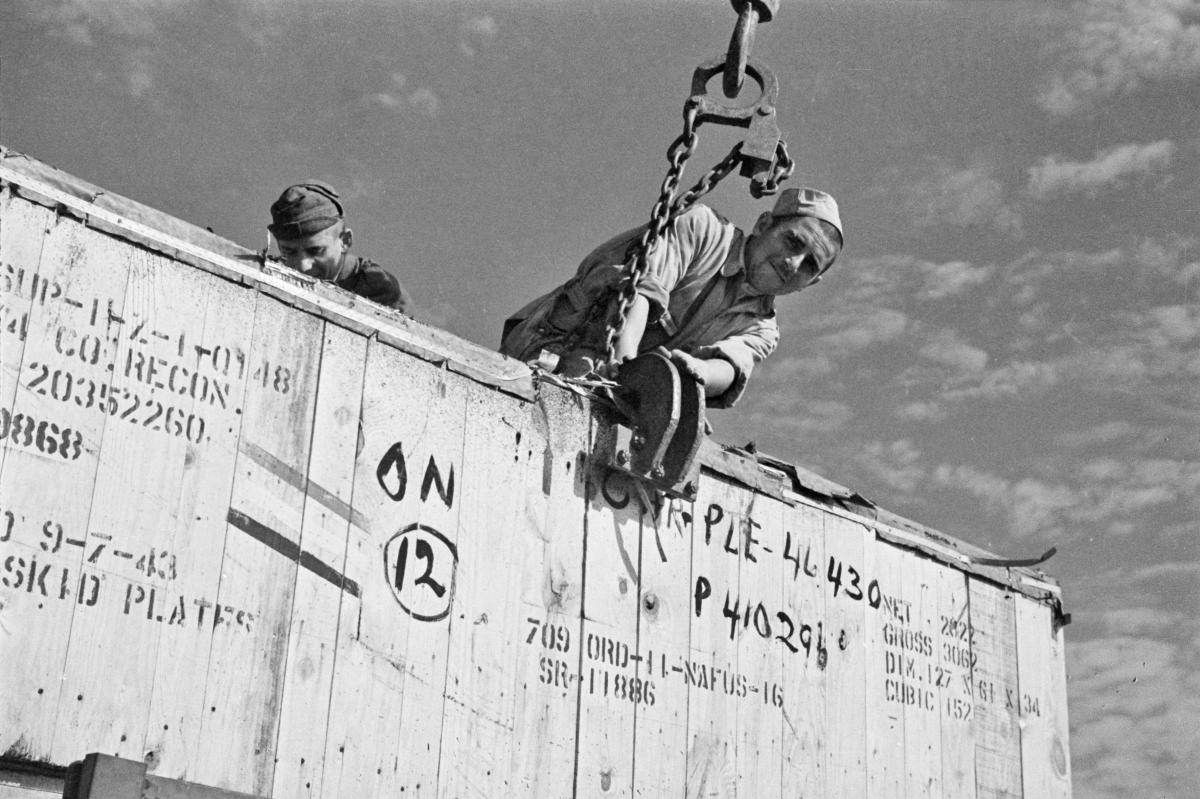
Sur le port de Casablanca (Maroc), des prisonniers italiens réquisitionnés déchargent une caisse de matériel. Octobre 1943.
© ECPAD, photographe SCA. Réf. : TERRE 112-L2250
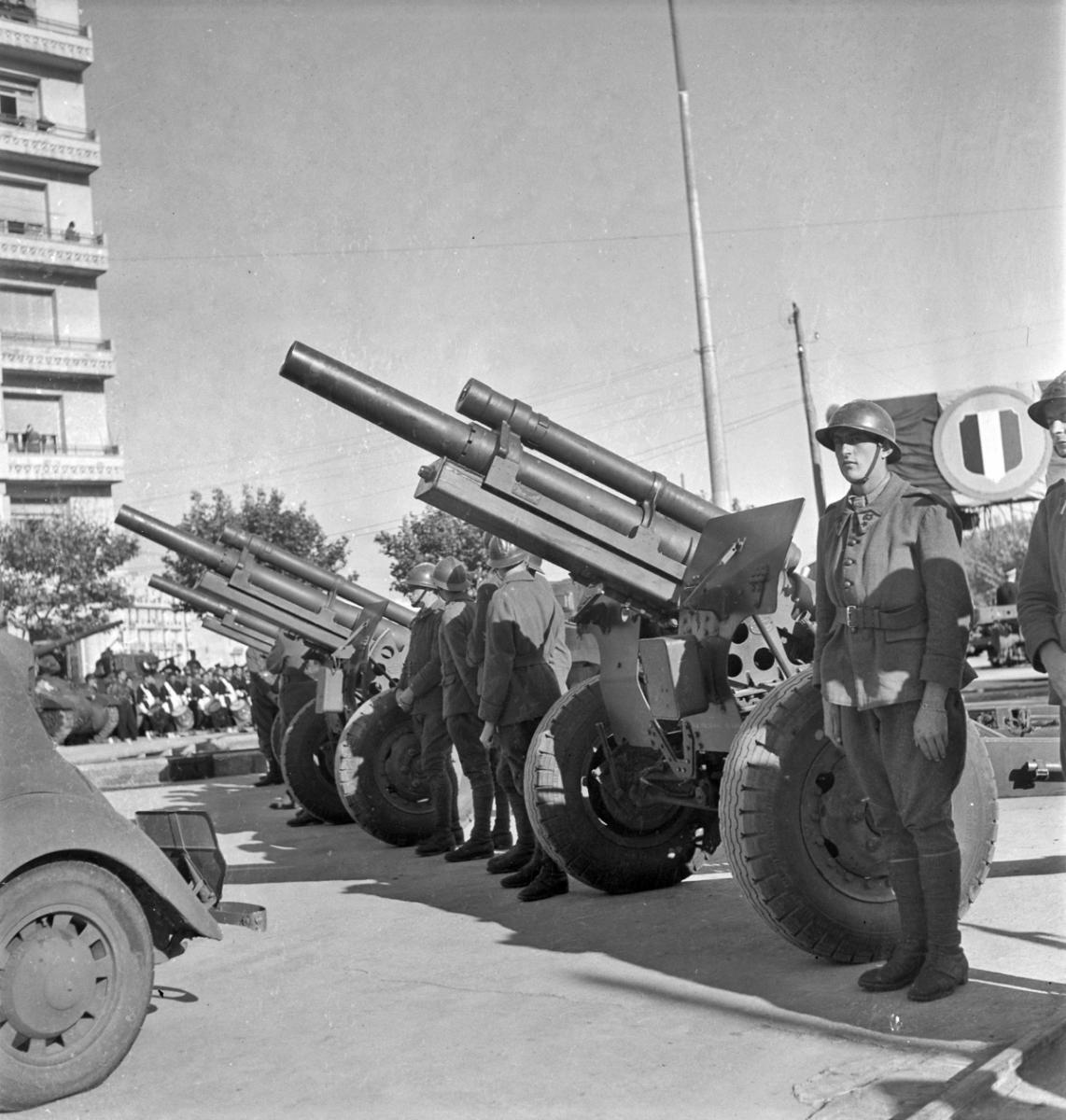
Cérémonie marquant la remise des premiers matériels américains aux troupes françaises : artilleurs du 63e RAA (Régiment d'artillerie d'Afrique) avec leurs nouvelles dotations d'obusiers de 105 mm Howitzer M2. Algérie, 8 mai 1943.
© ECPAD, photographe SCA. Réf. : TERRE 51-987
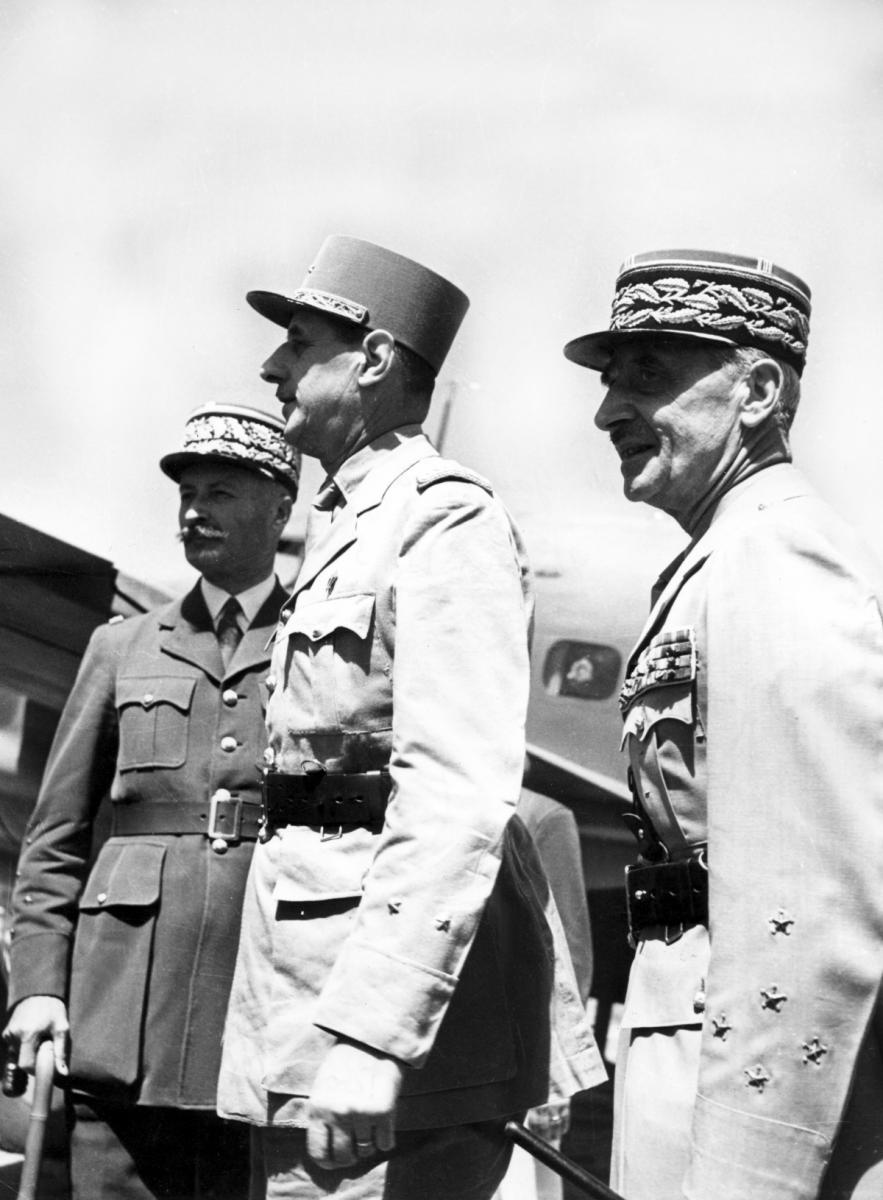
Les généraux Giraud, de Gaulle et Catroux à Boufarik (Algérie), le 30 mai 1943.
© ECPAD, photographe inconnu. Réf. TERRE 65-1193
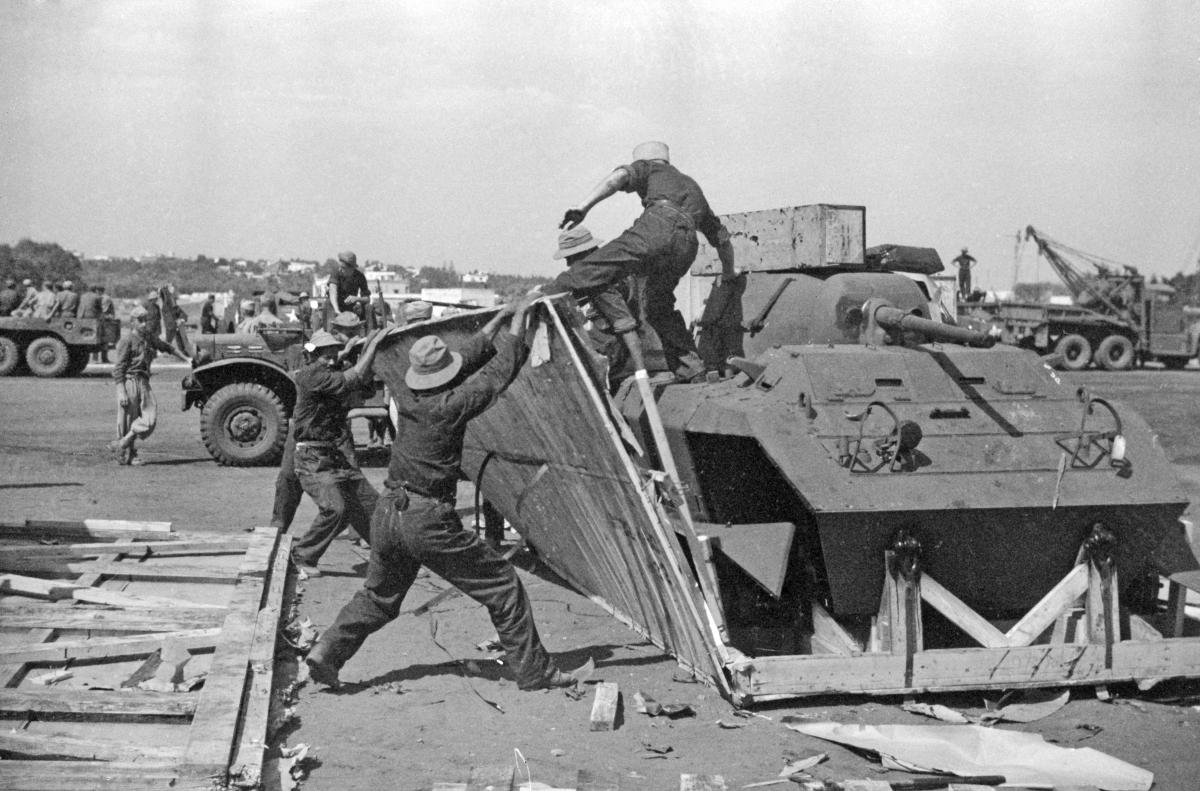
Chaîne de montage de matériels américains à Casablanca (Maroc), le 6 septembre 1943.
© ECPAD, photographe SCA. Réf. : TERRE 91-L1664
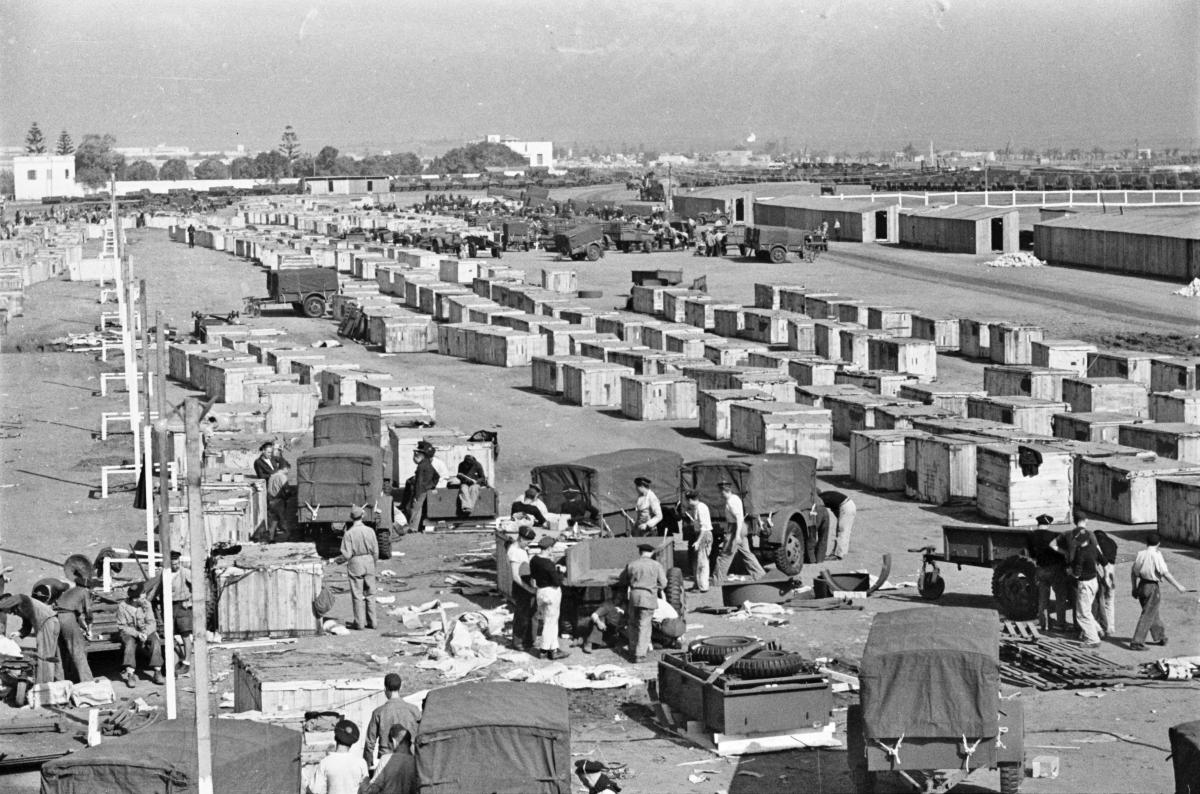
Vue d'ensemble d'une chaîne de montage des matériels livrés par les Américains à Casablanca (Maroc). Octobre 1943.
© ECPAD, photographe SCA. Réf. : TERRE 112-L2291
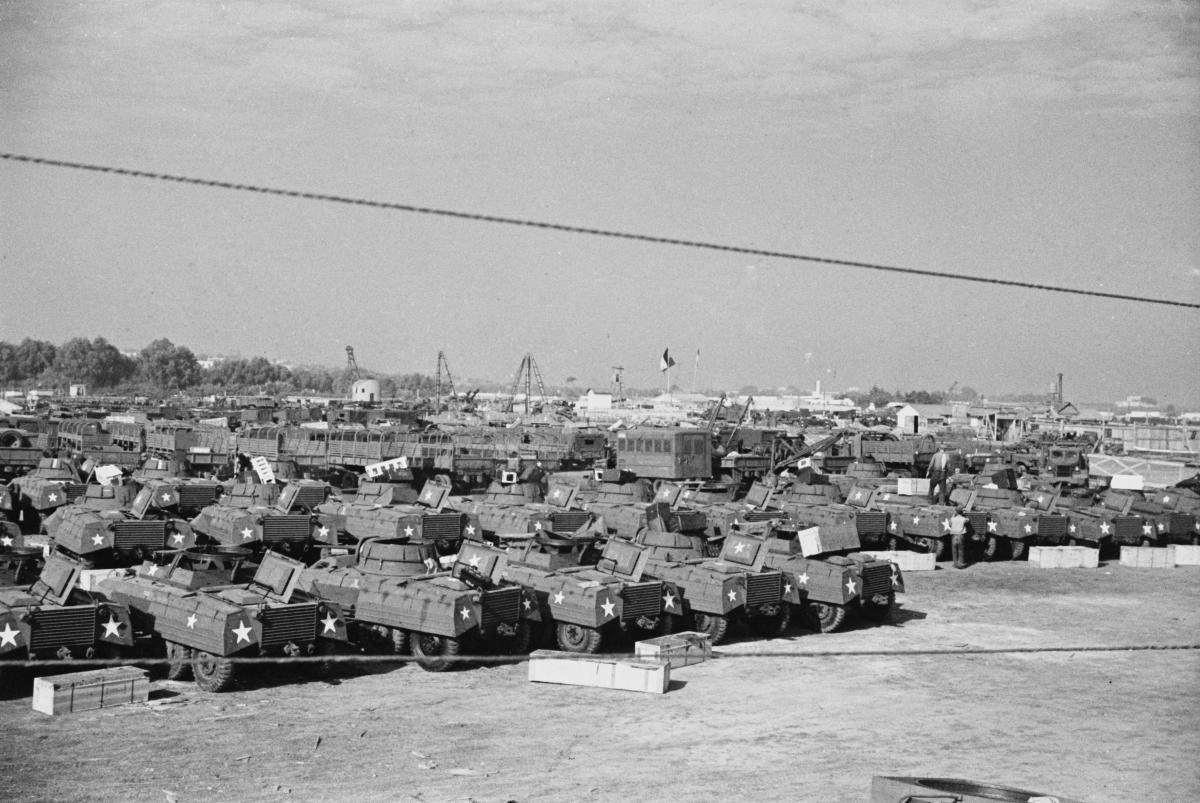
Vue d'ensemble d'une zone de stockage à Casablanca (Maroc). Octobre 1943.
© ECPAD, photographe SCA. Réf. : TERRE 112-L2299
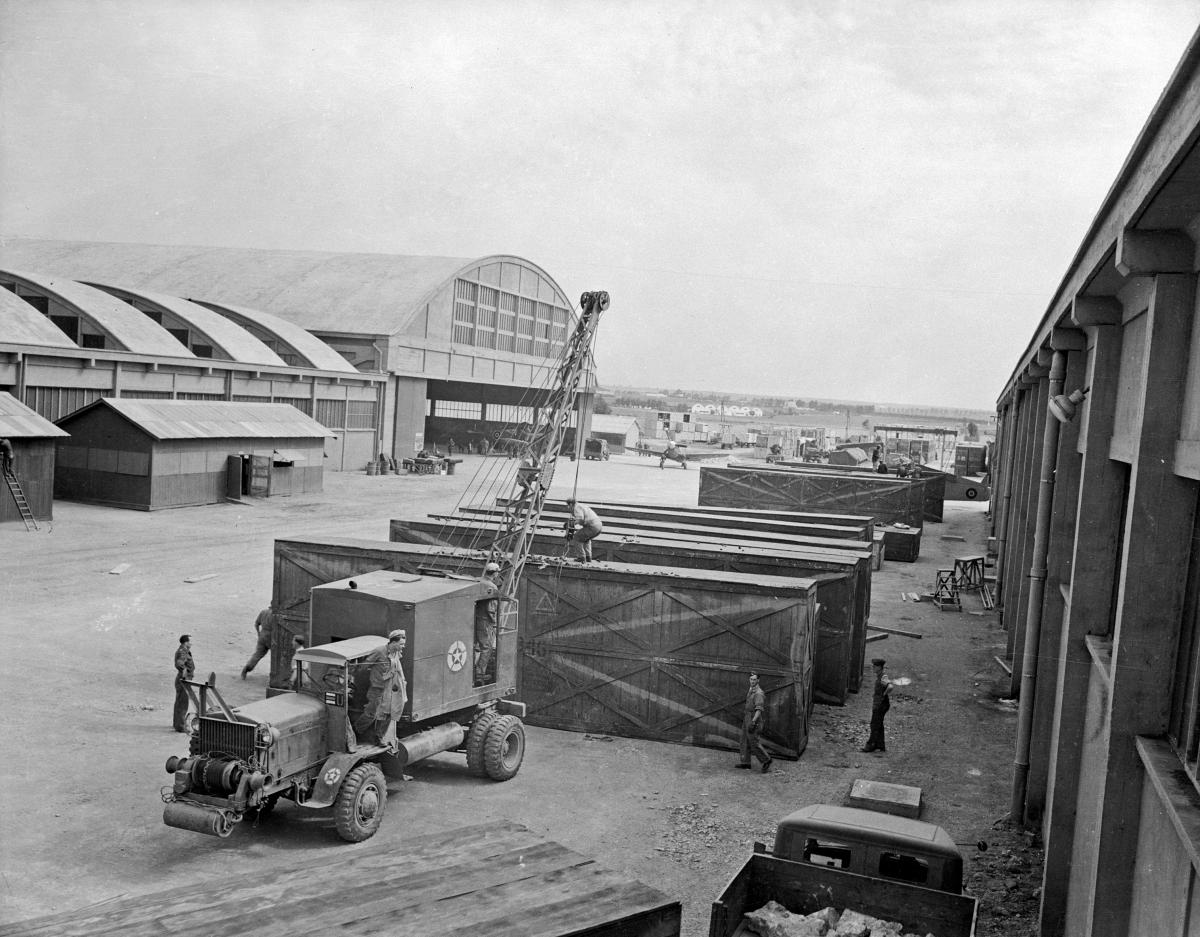
Livraison de caisses contenant des avions de chasse Curtiss P-40 en pièces détachées sur une chaîne de montage de Casablanca (Maroc). Février 1944.
© ECPAD, photographe SCA. Réf. : AIR 38-729
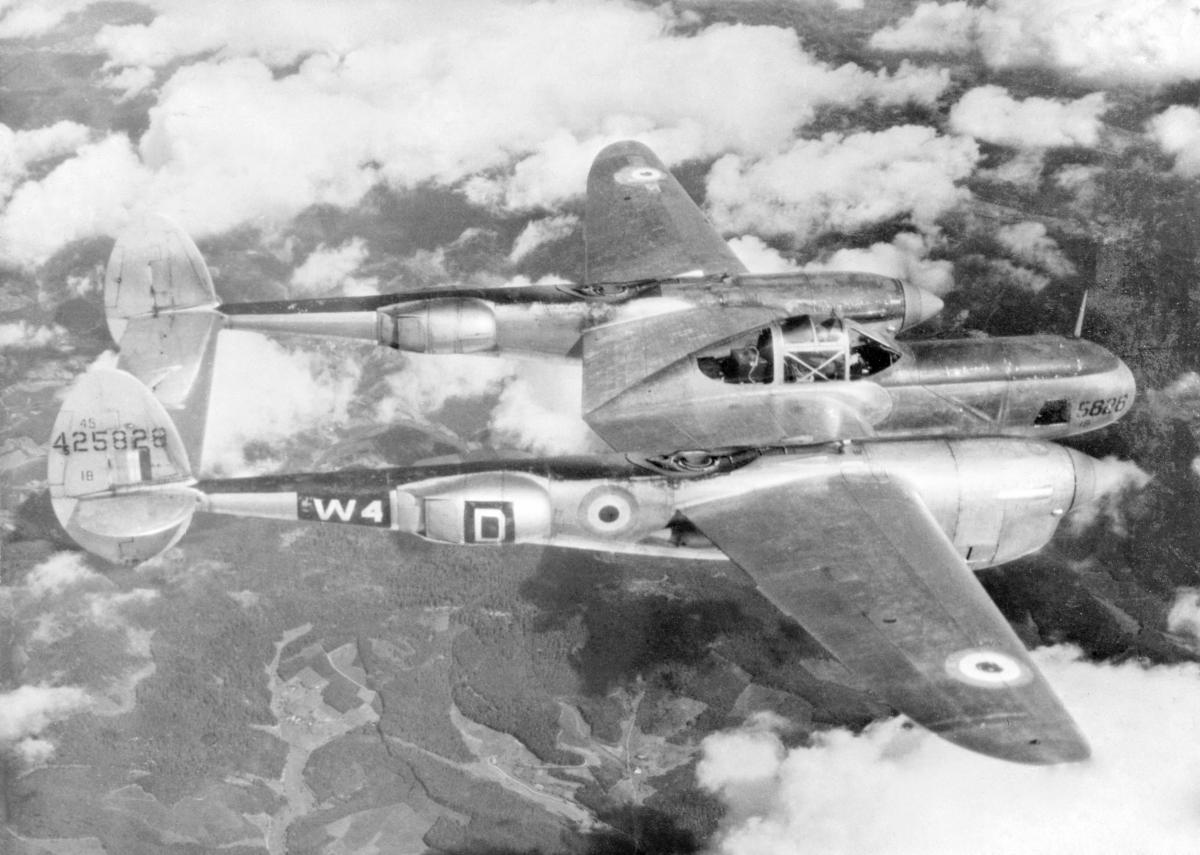
Lockheed F-5B-1-LO.Version photo du P 38-J-10-LO (type d'appareil à bord duquel Antoine de St Exupéry à disparu).
© ECPAD, photographe inconnu. Réf. : AIR 695-9769 bis
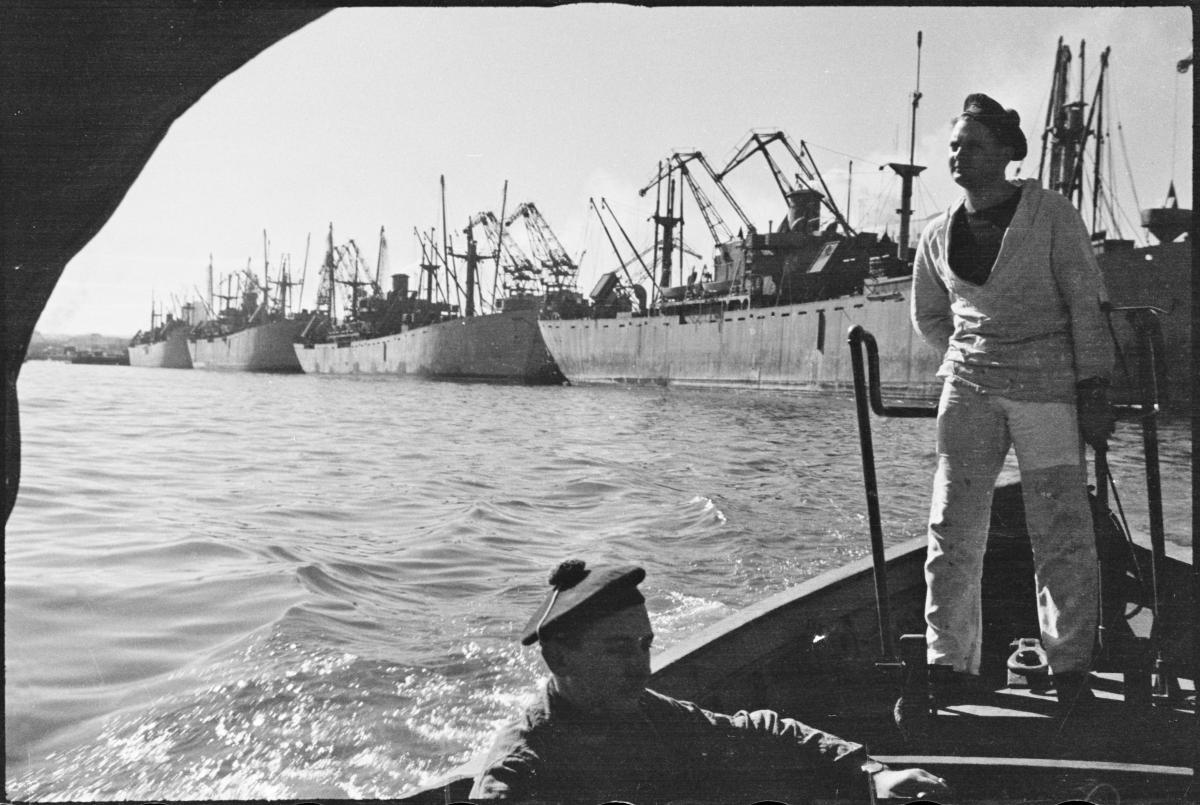
Liberty ships à quai dans le port de Casablanca (Maroc). Octobre 1943.
© ECPAD, photographe SCA. Réf. : TERRE 112-L2317
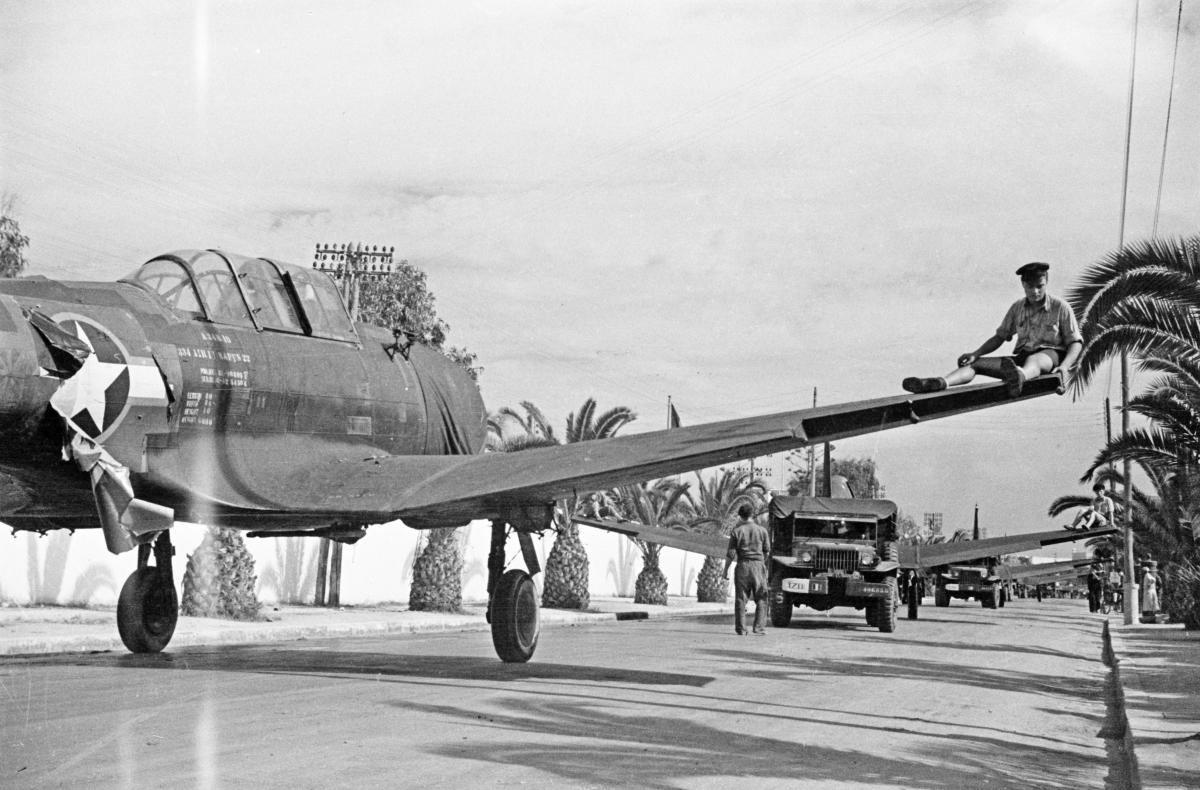
Remorquage dans les rues de Casablanca (Maroc) d'avions bombardiers Douglas SBD Dauntless sortant des chaînes de montage. Octobre 1943.
© ECPAD, photographe SCA. Réf. : AIR 112-L2268
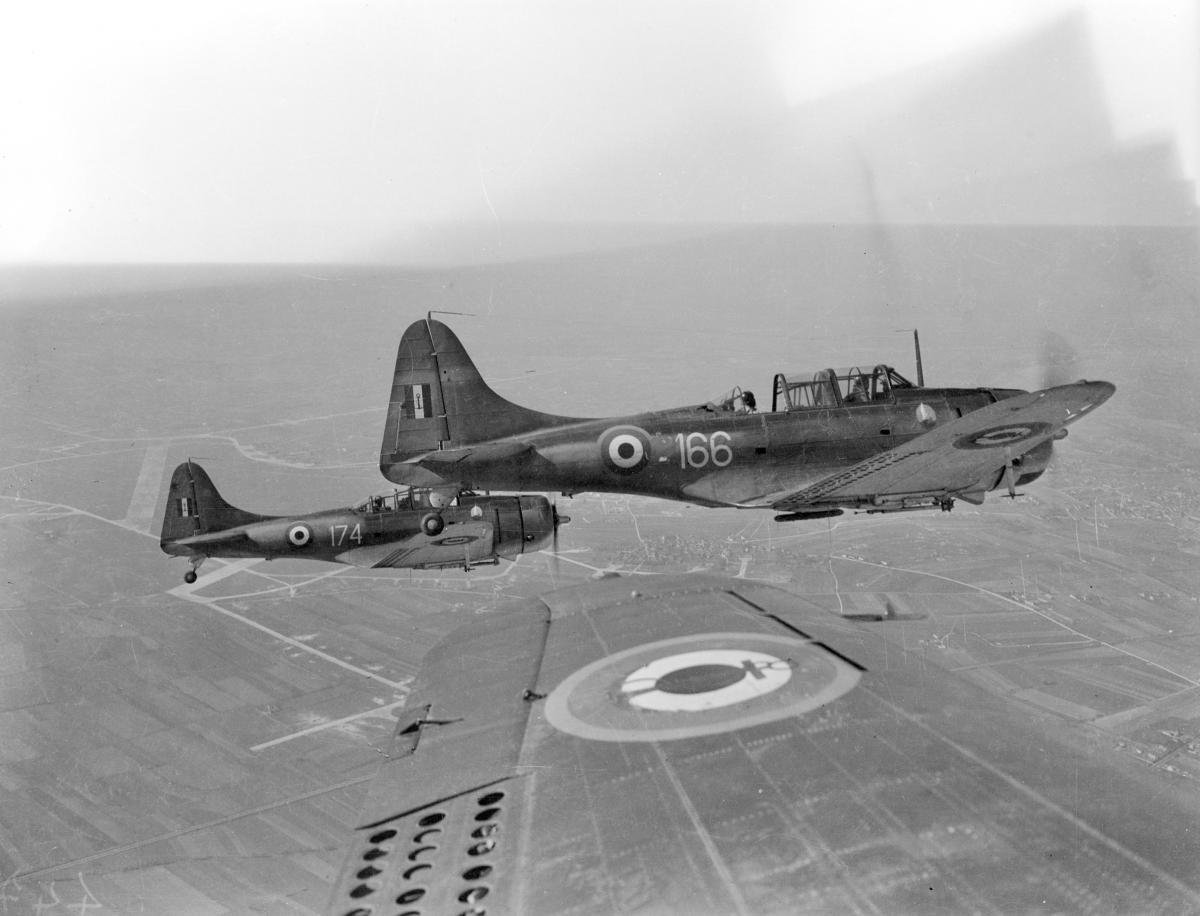
Bombardiers en piqué Douglas SBD-3 Dauntless (version A-24) en plein vol, avril 1945.
© ECPAD, photographe inconnu. Réf. : AIR 244-4408
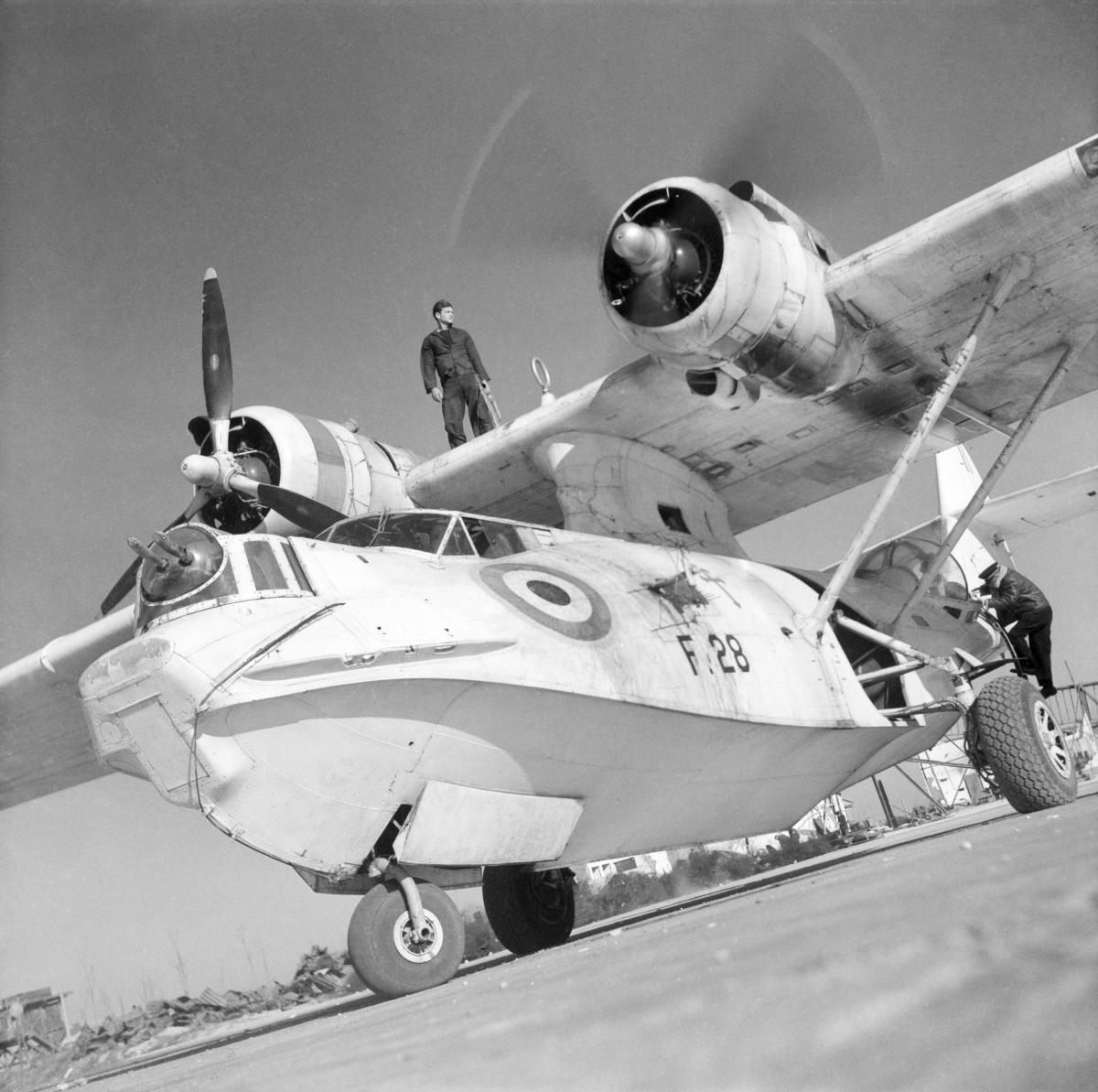
Consolidated PBY-5A catalina, avril 1945.
© ECPAD, photographe inconnu. Réf. : AIR 244-4414
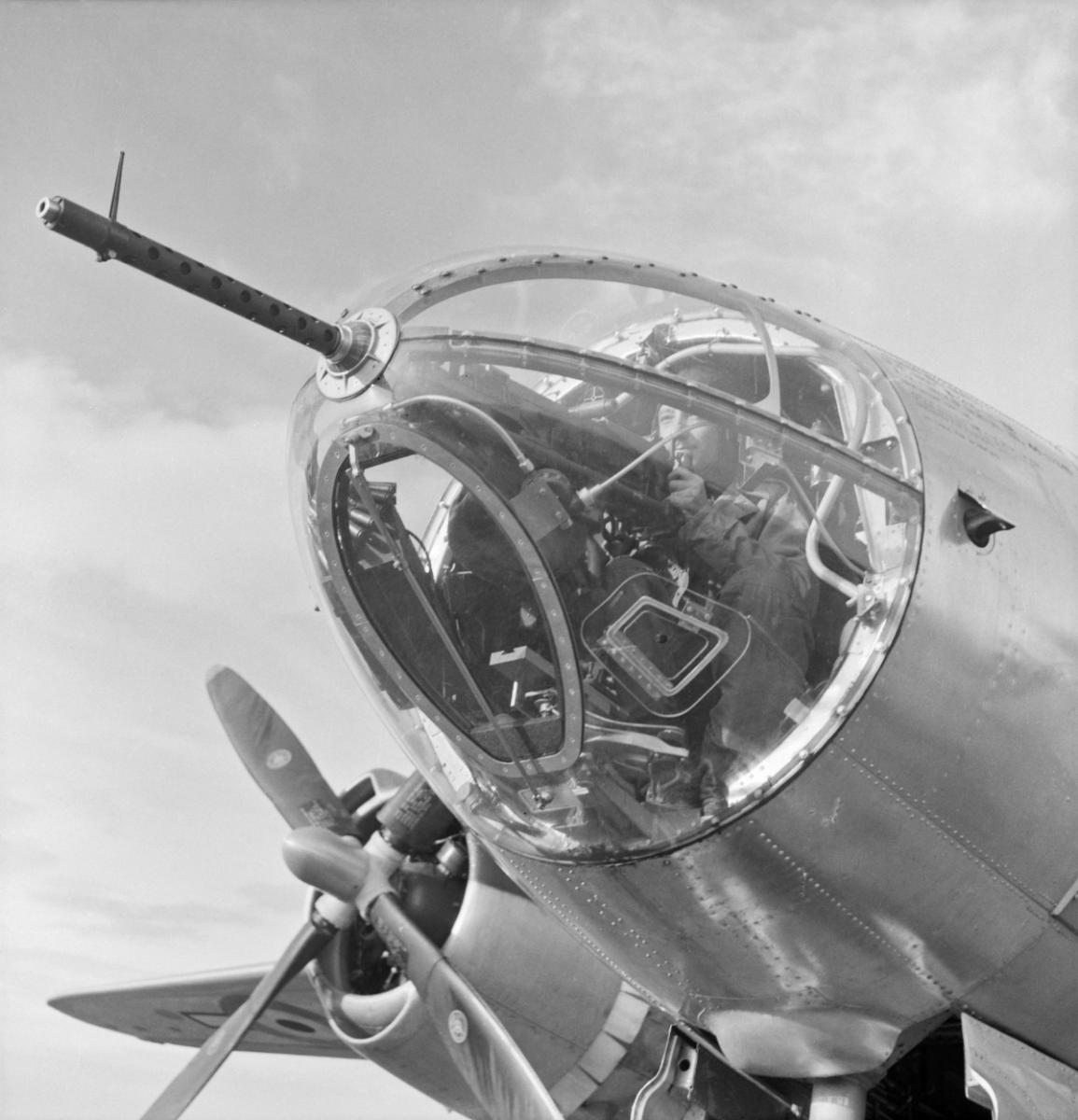
Avant de partir en mission, le mitrailleur vérifie son arme à bord d'un avion Martin B-26C Marauder, décembre 1944.
© ECPAD, photographes Collin et Pidoux. Réf. : AIR 156-3320
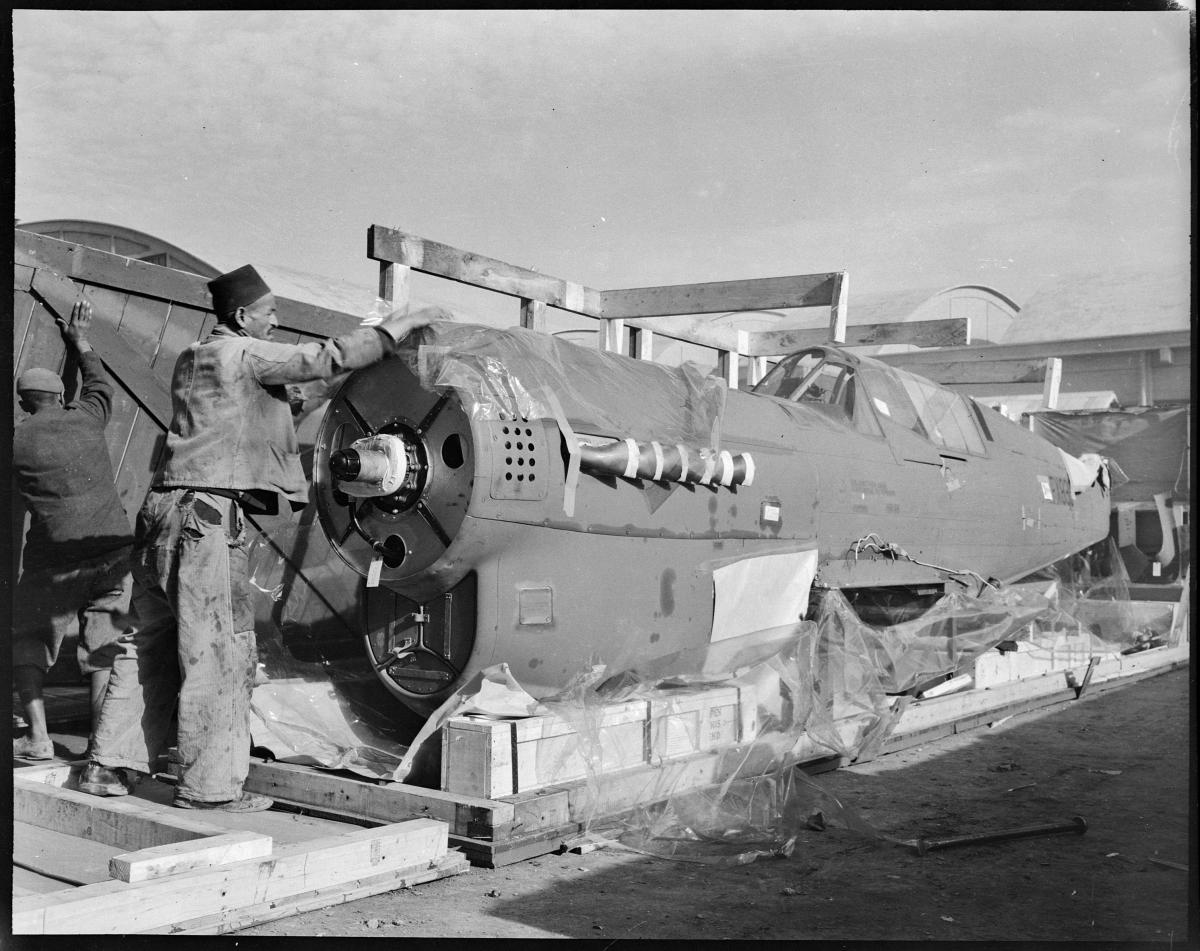
Le fuselage d'un avion de chasse Curtiss P-40 est déballé de sa caisse de transport sur une chaîne de montage de Casablanca (Maroc). Février 1944.
© ECPAD, photographe SCA. Réf. : AIR 38-733
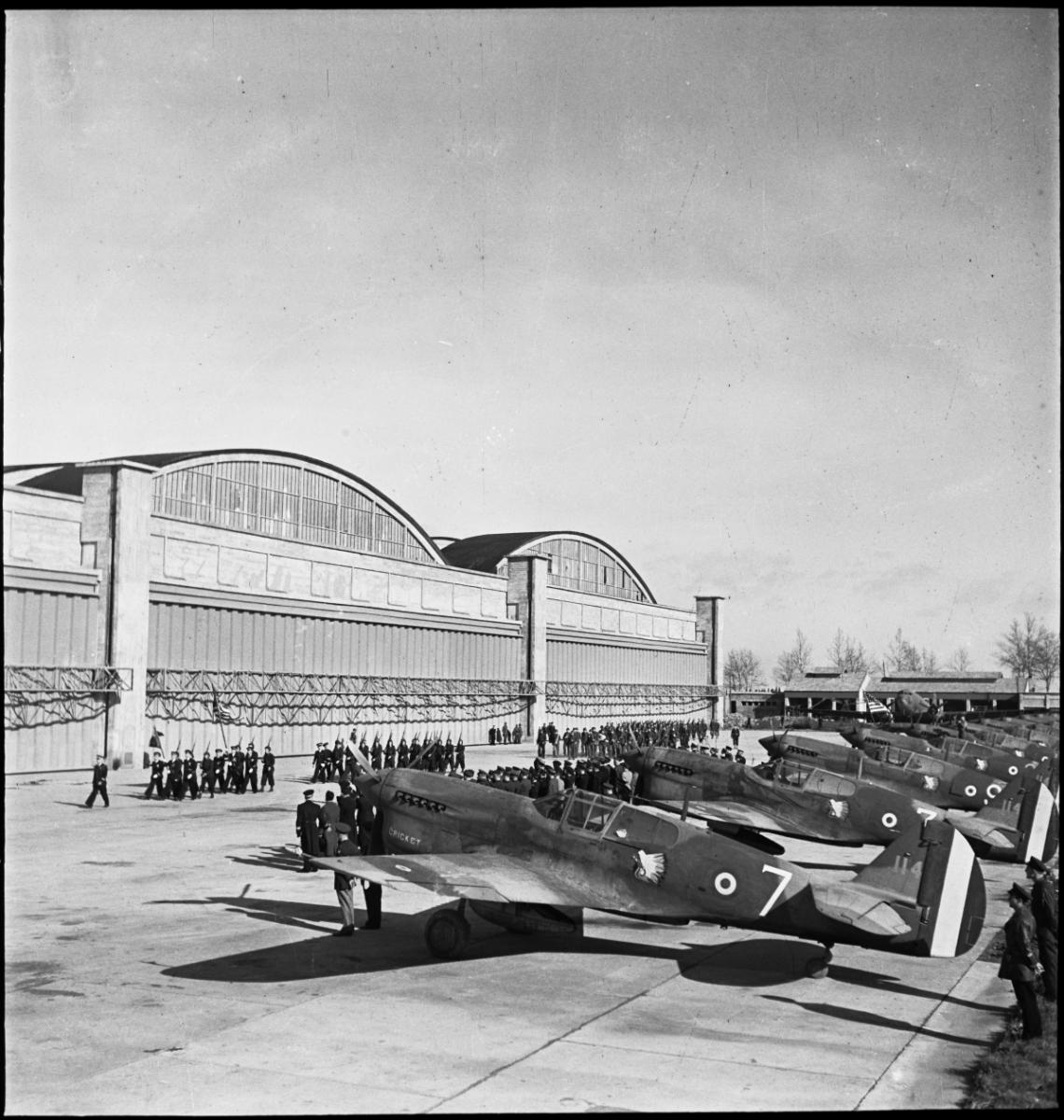
Curtiss P40F équipant le groupe Lafayette sur l'aérodrome d'Alger lors d'une cérémonie, début 1943.
© ECPAD, photographe inconnu. Réf. : TERRE 9-113
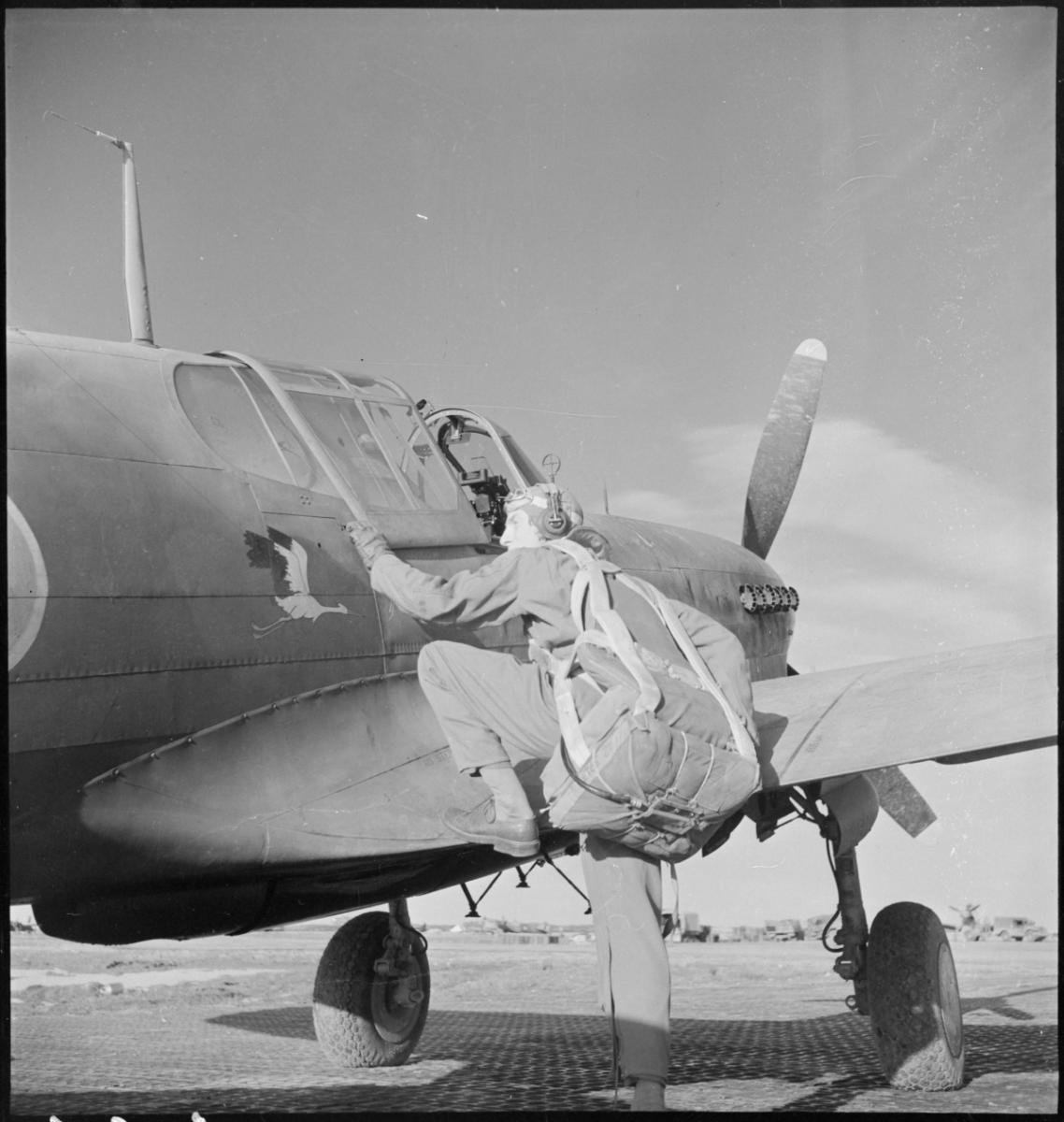
Un pilote de l'escadrille n°4 du groupe de chasse II/5 Lafayette part en mission à bord d'un Curtiss P40L.
© ECPAD, photographe inconnu. Réf. : AIR 20-466
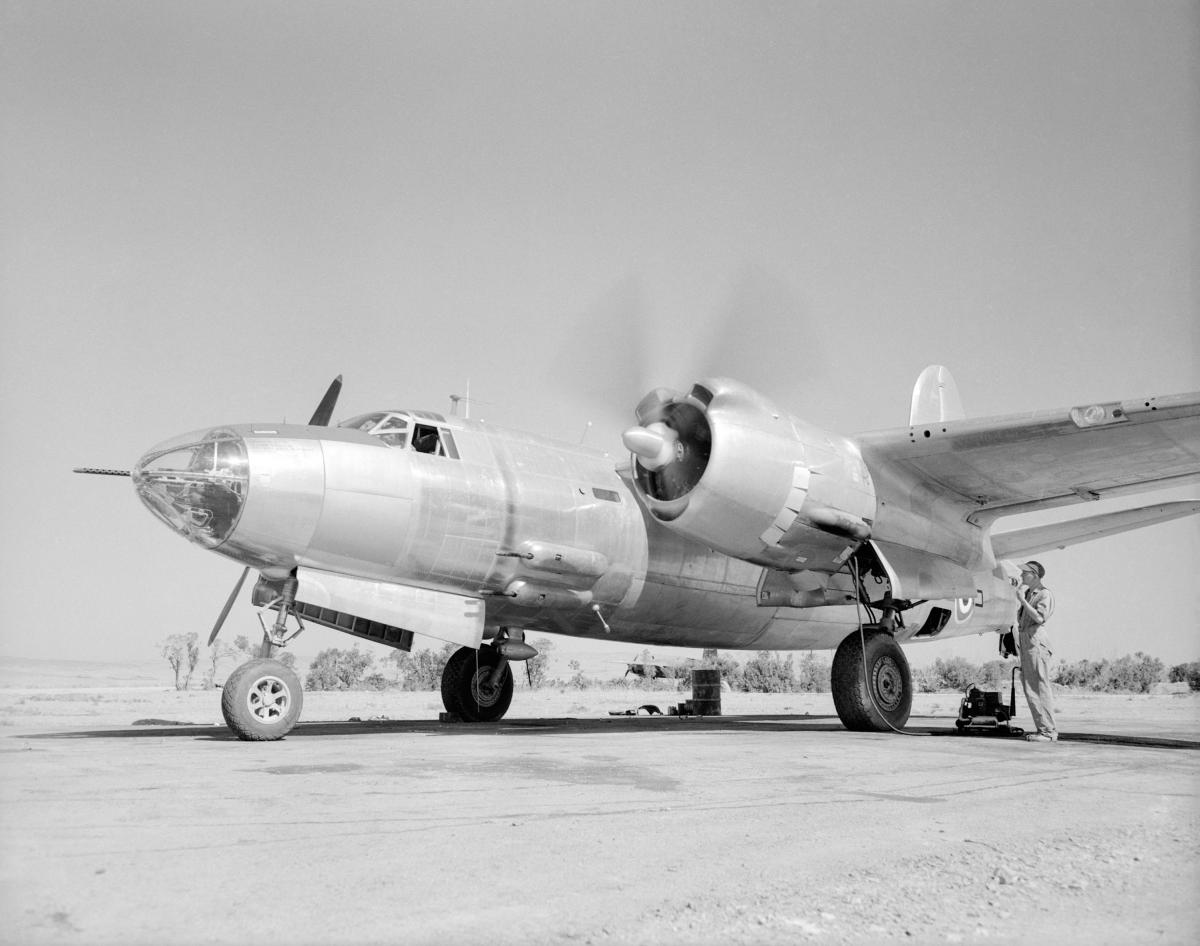
Un B-26 "Marauder" se met en position pour décoller sur la piste en Tunisie, août 1944.
© ECPAD, photographe Collin. Réf. : AIR 125-2195
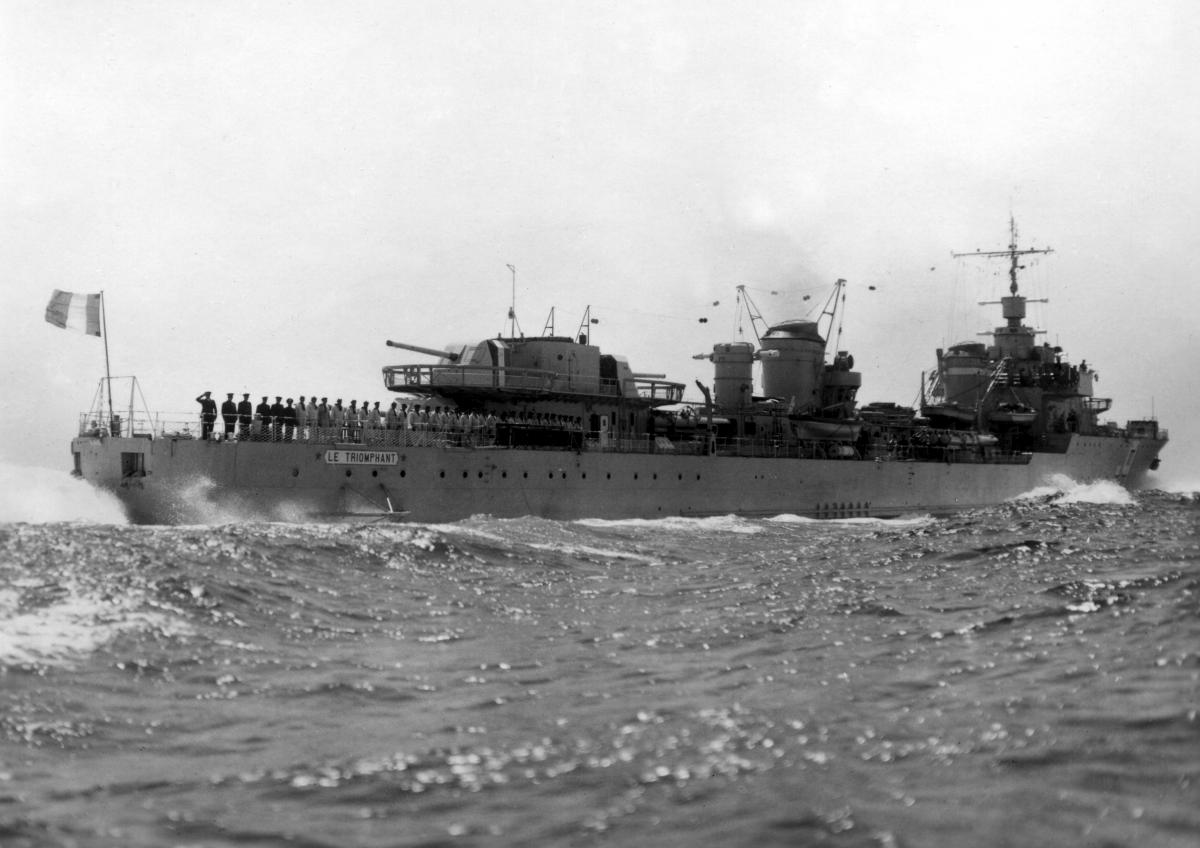
Le Triomphant, contre-torpilleur des Forces Navales Françaises Libres dans le Pacifique.
© collection particulière
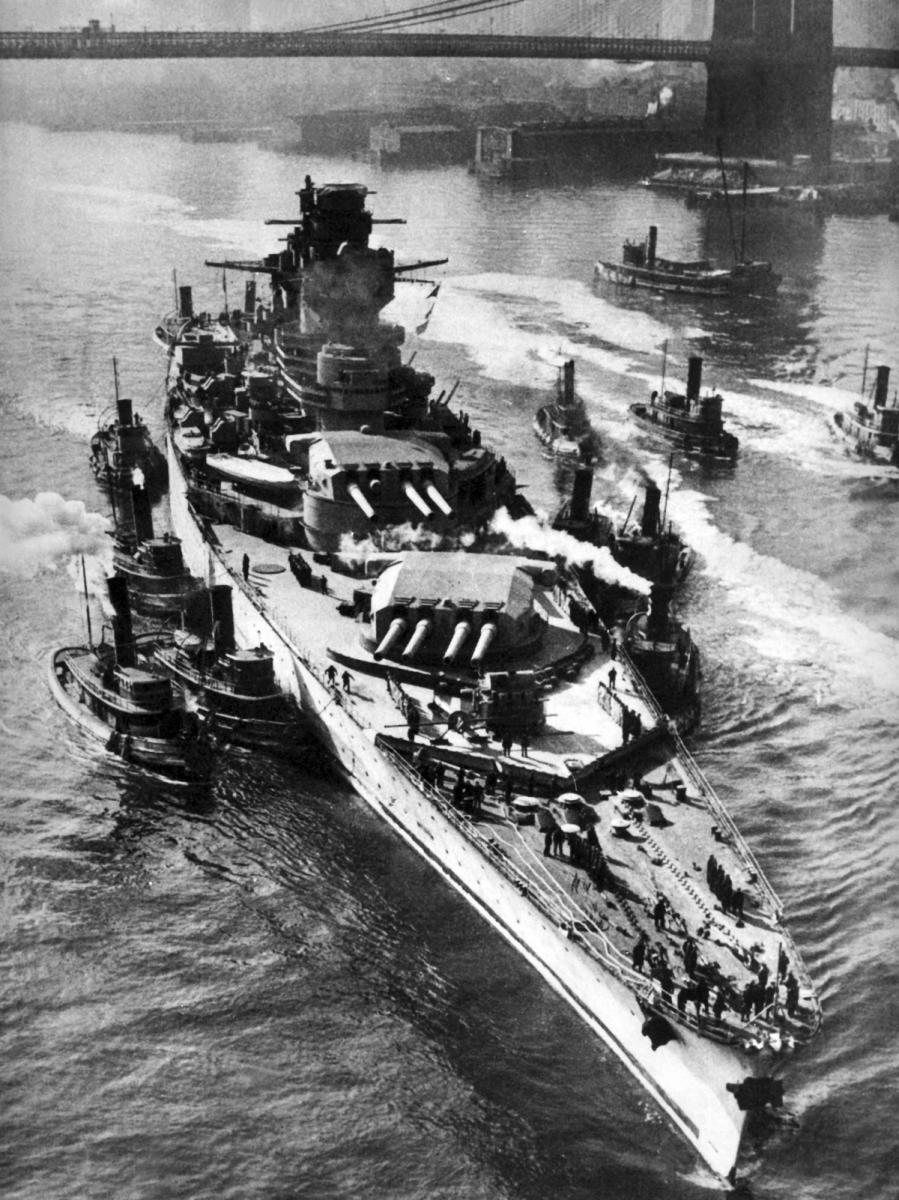
Le cuirassé le Richelieu arrive dans le prot de New York en février 1943 pour y être modernisé.
© collection particulière
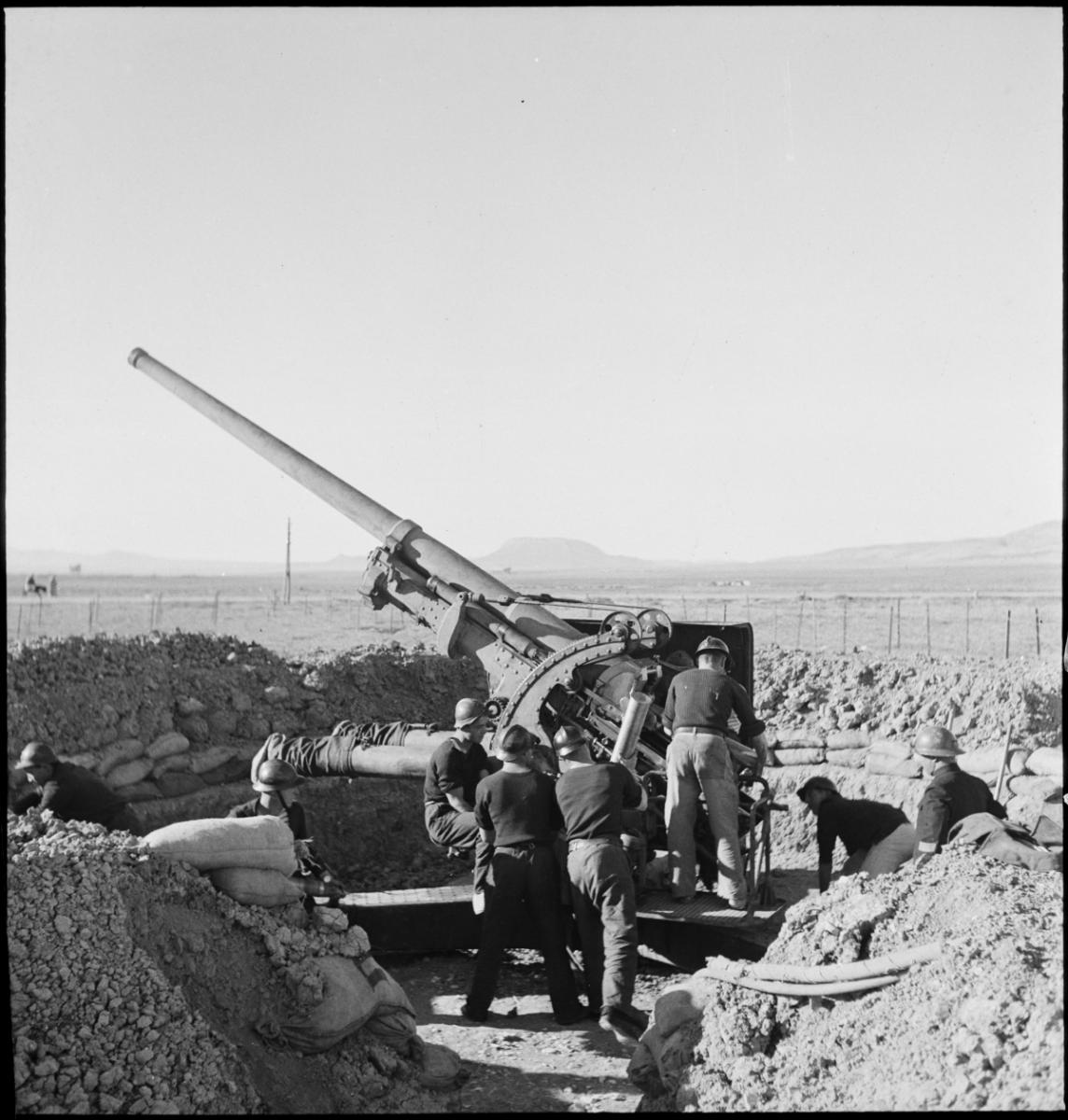
Campagne de Tunisie. Des canonniers marins de la 6e batterie mobile de 90 de marine mettent en batterie un canon de 90 mm modèle 1939 Schneider près de Tébessa (frontière algéro-tunisienne), 15 février 1943.
© ECPAD, photographe inconnu. Réf. : TERRE 15-153
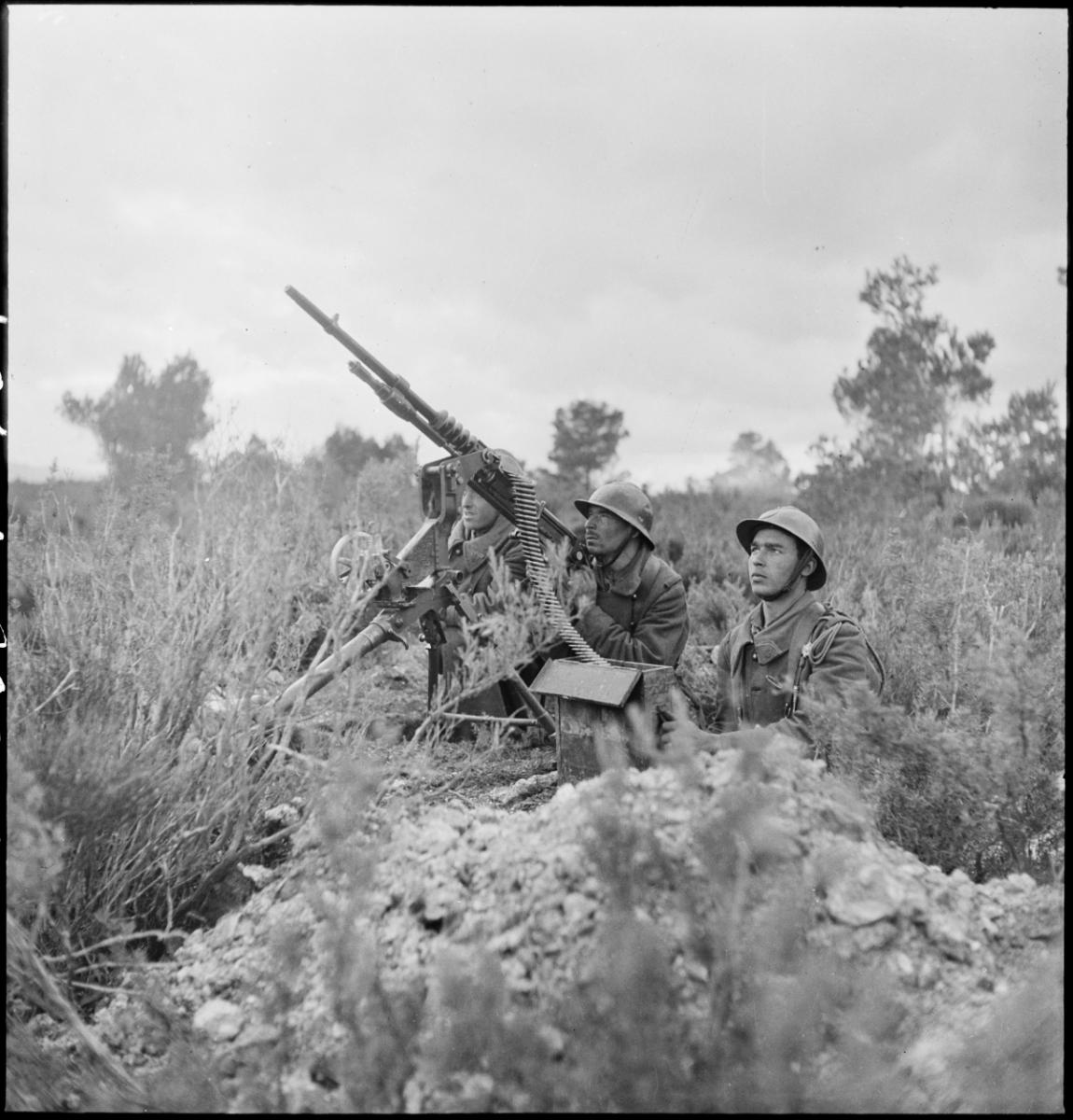
Campagne de Tunisie. Tirailleurs dans le secteur de Maktar, mars 1943.
© ECPAD, photographe inconnu. Réf. : TERRE 25-323
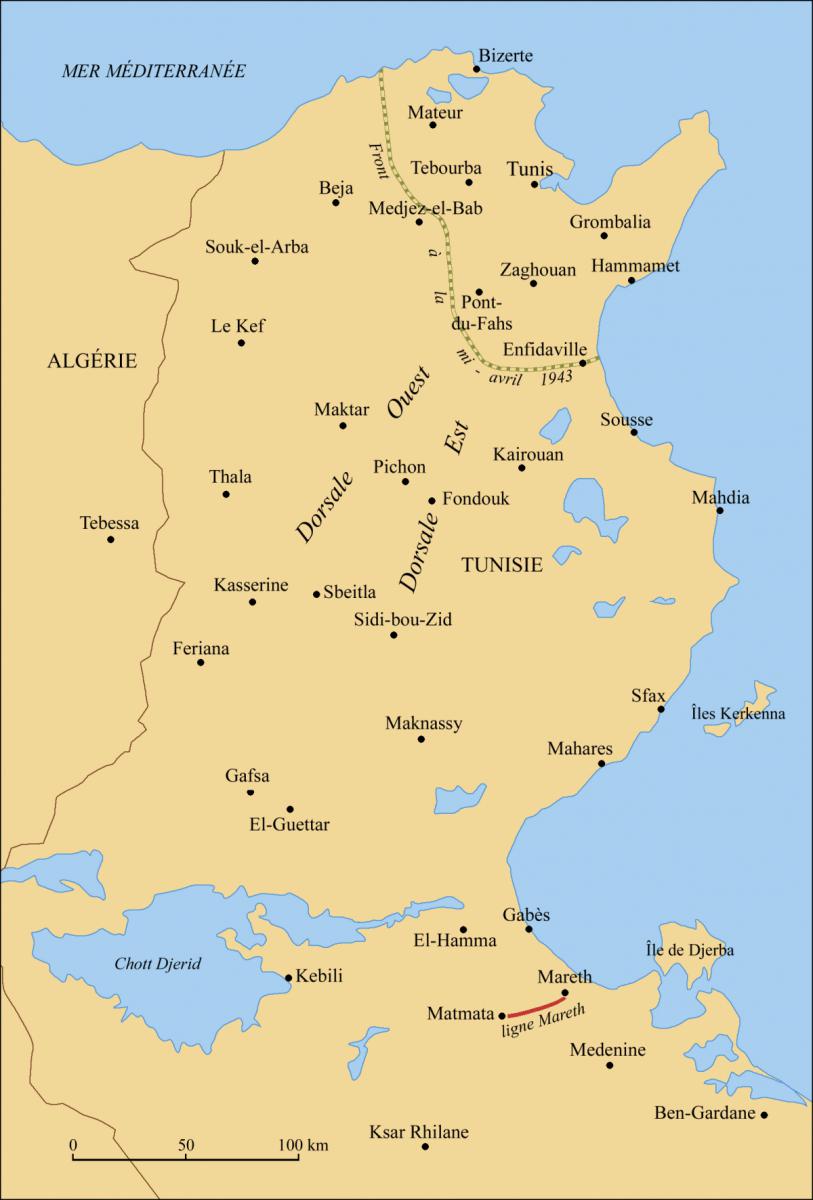
La campagne de Tunisie, 1942-1943.
© ministère de la défense
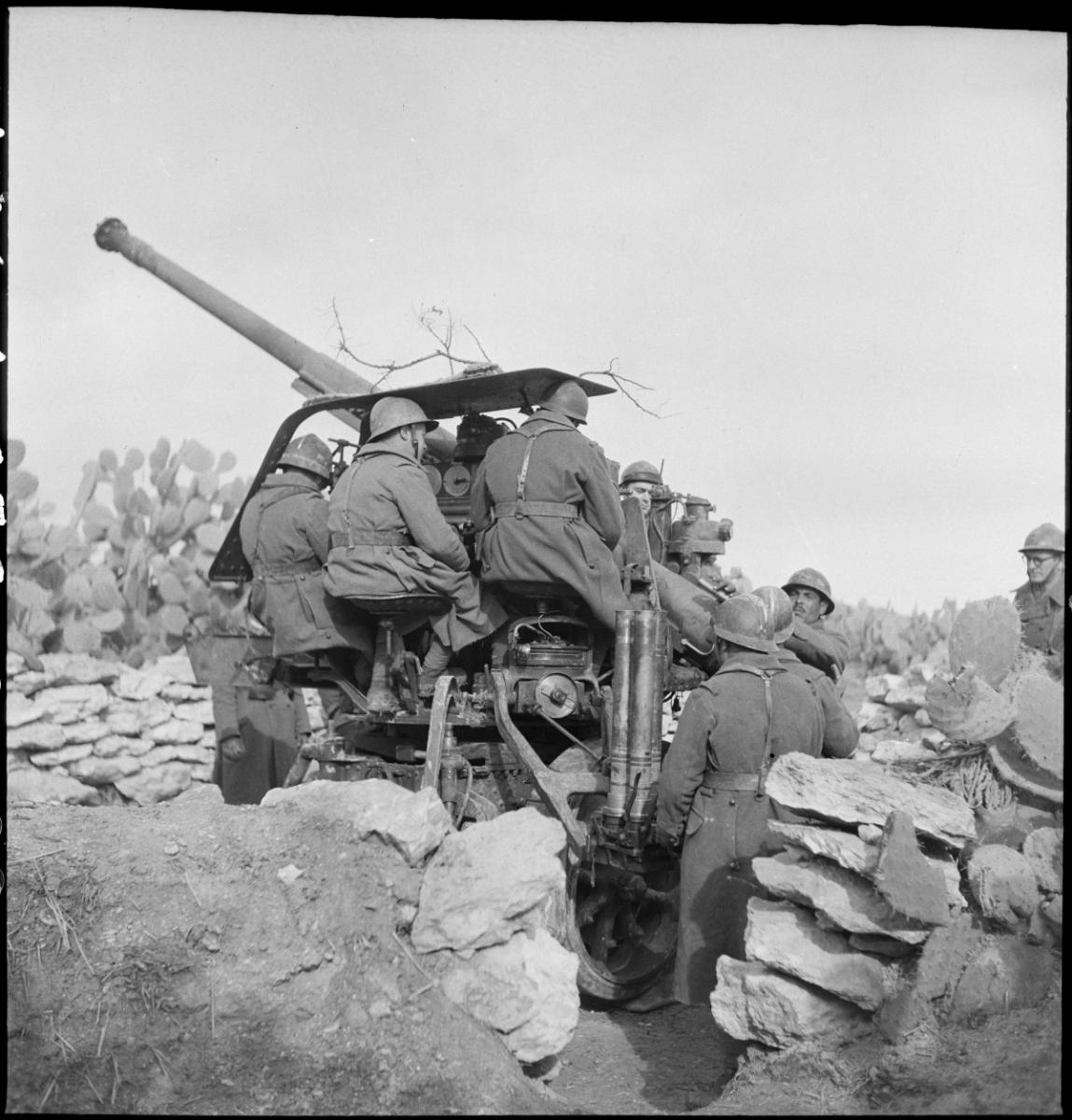
Campagne de Tunisie. Des artilleurs du 412e régiment d'artillerie antiaérienne mettent en batterie un canon de 75 mm dans le secteur de Bou Arada, mars 1943.
© ECPAD, photographe inconnu. Réf. : TERRE 25-389
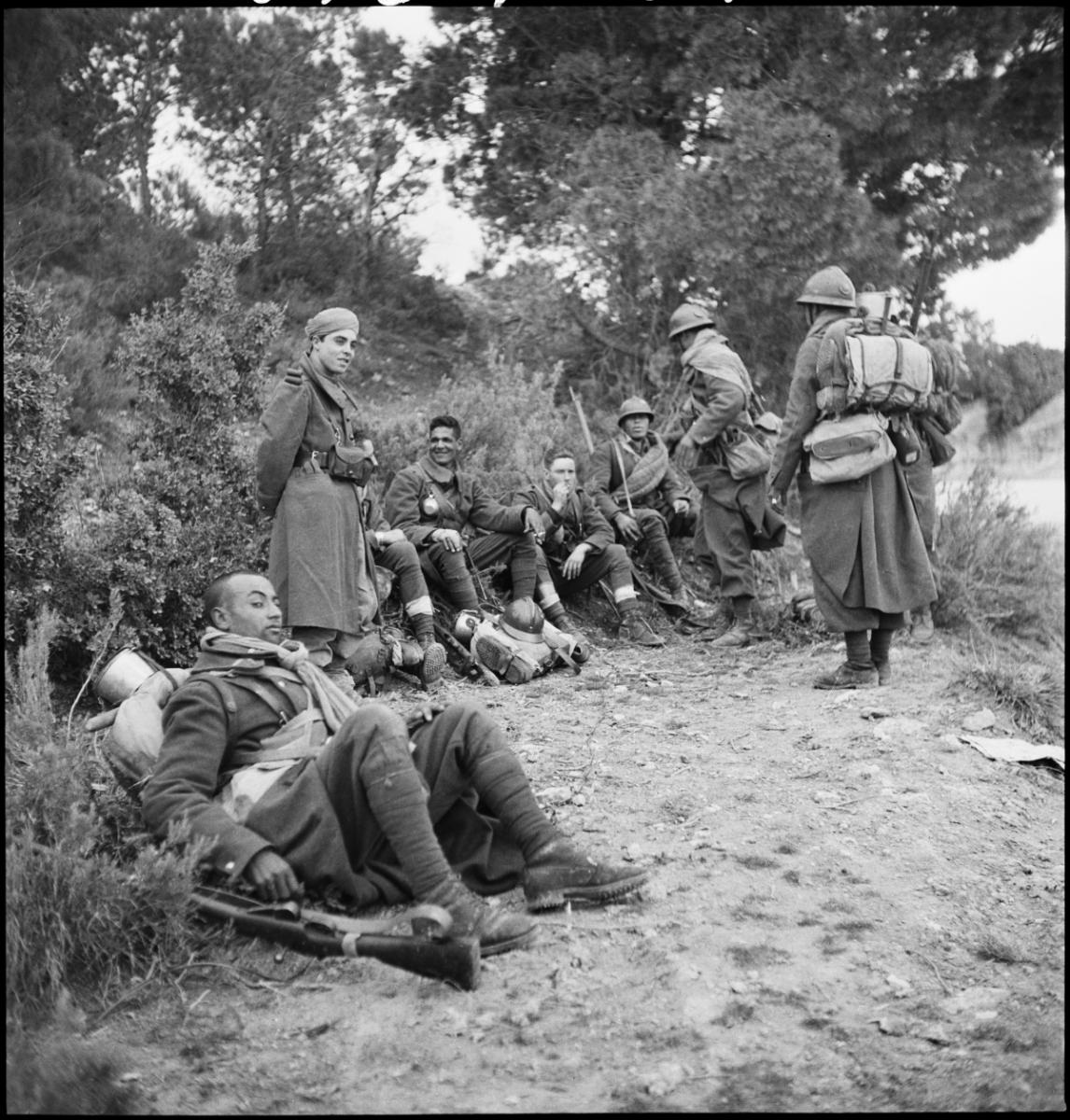
Campagne de Tunisie. Retour des lignes d'un groupe de tirailleurs dans le secteur de Maktar, mars 1943.
© ECPAD, photographe inconnu. Réf. : TERRE 25-348
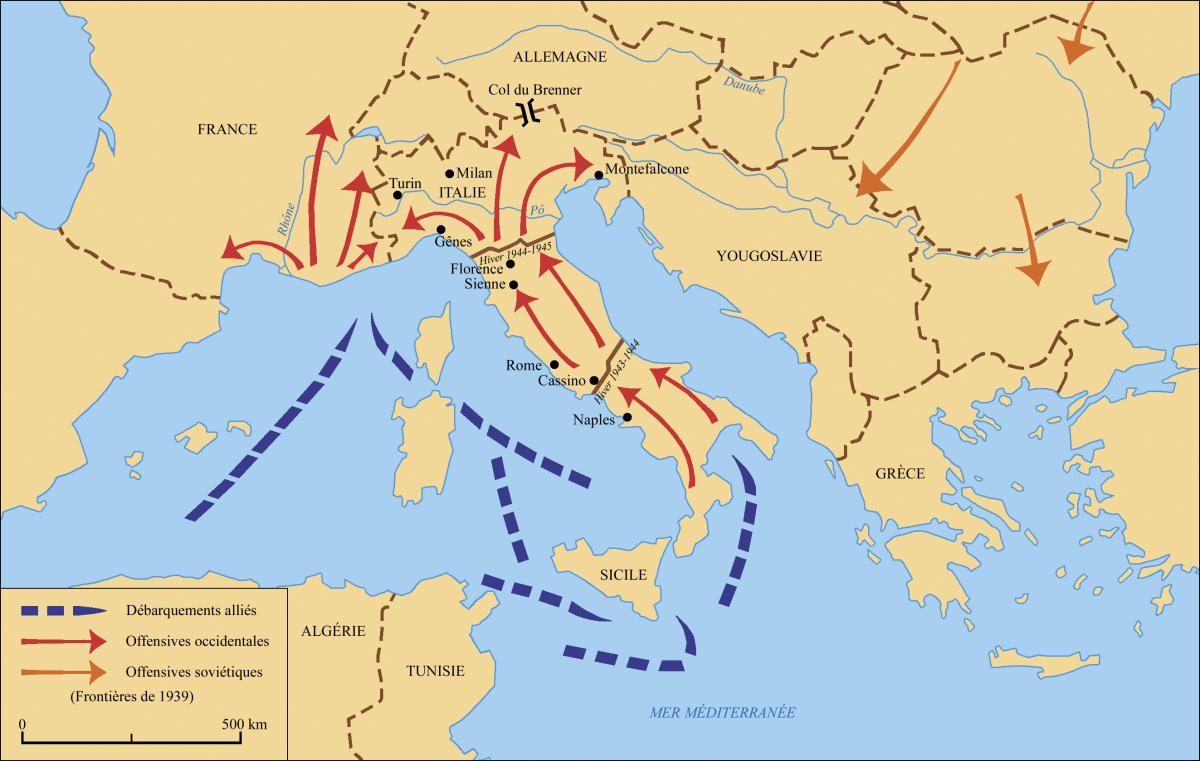
La campagne d'Italie, 1943-1945.
© ministère de la défense
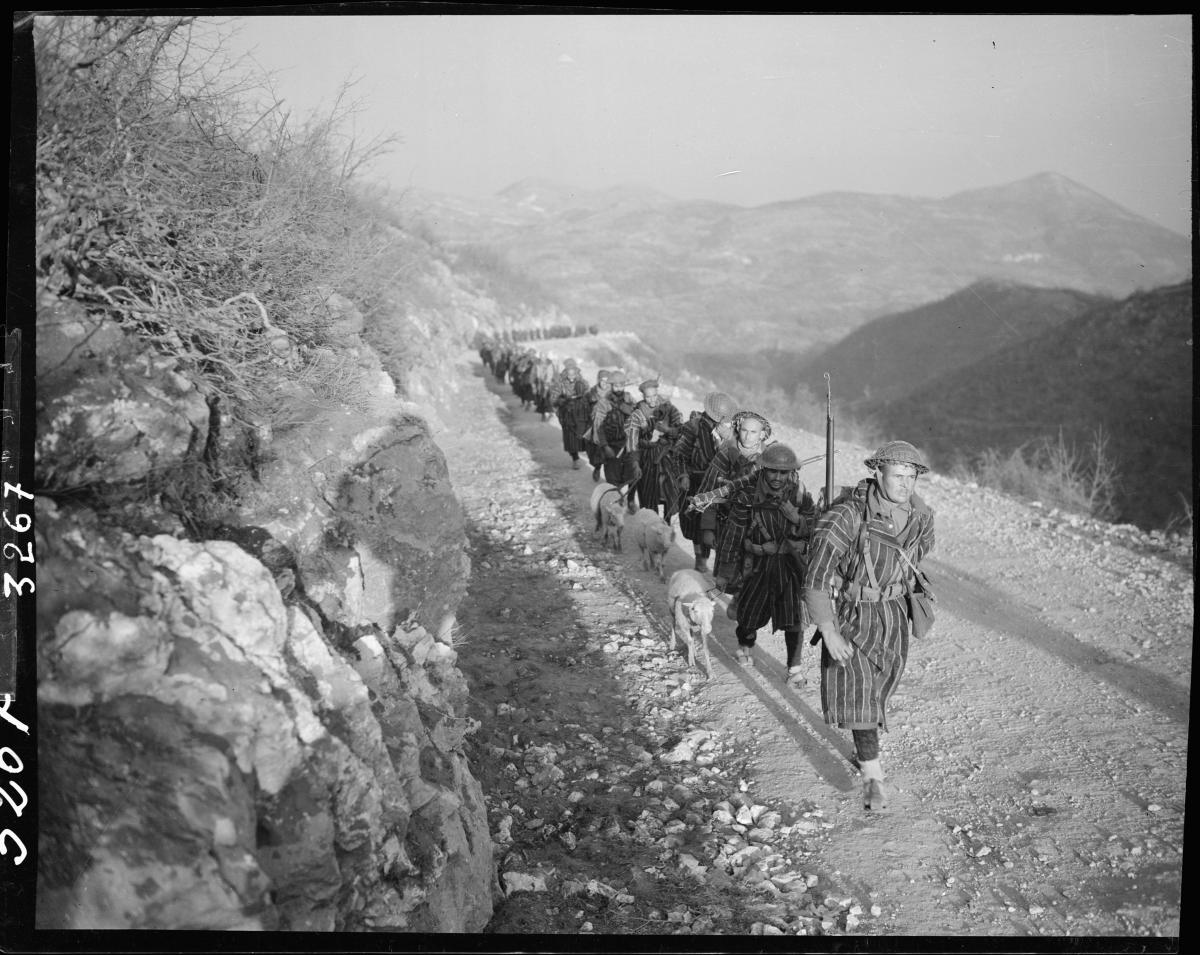
Campagne d'Italie. Colonne de goumiers, 21 janvier 1944.
© ECPAD, photographe inconnu. Réf. : TERRE 147-3267
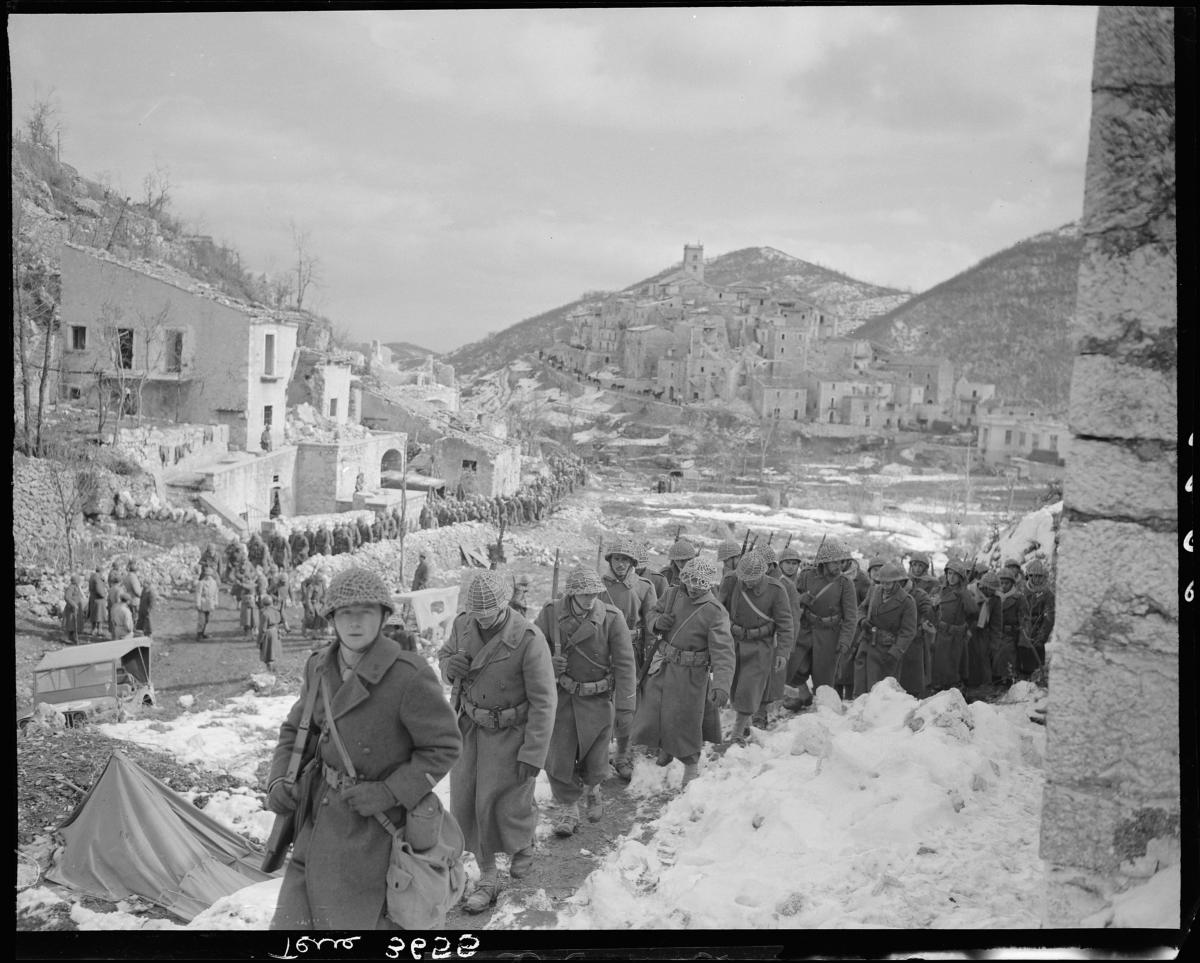
Campagne d'Italie. Tirailleurs marocains, 24 février 1944.
© ECPAD, photographe inconnu. Réf. : TERRE 169-3655
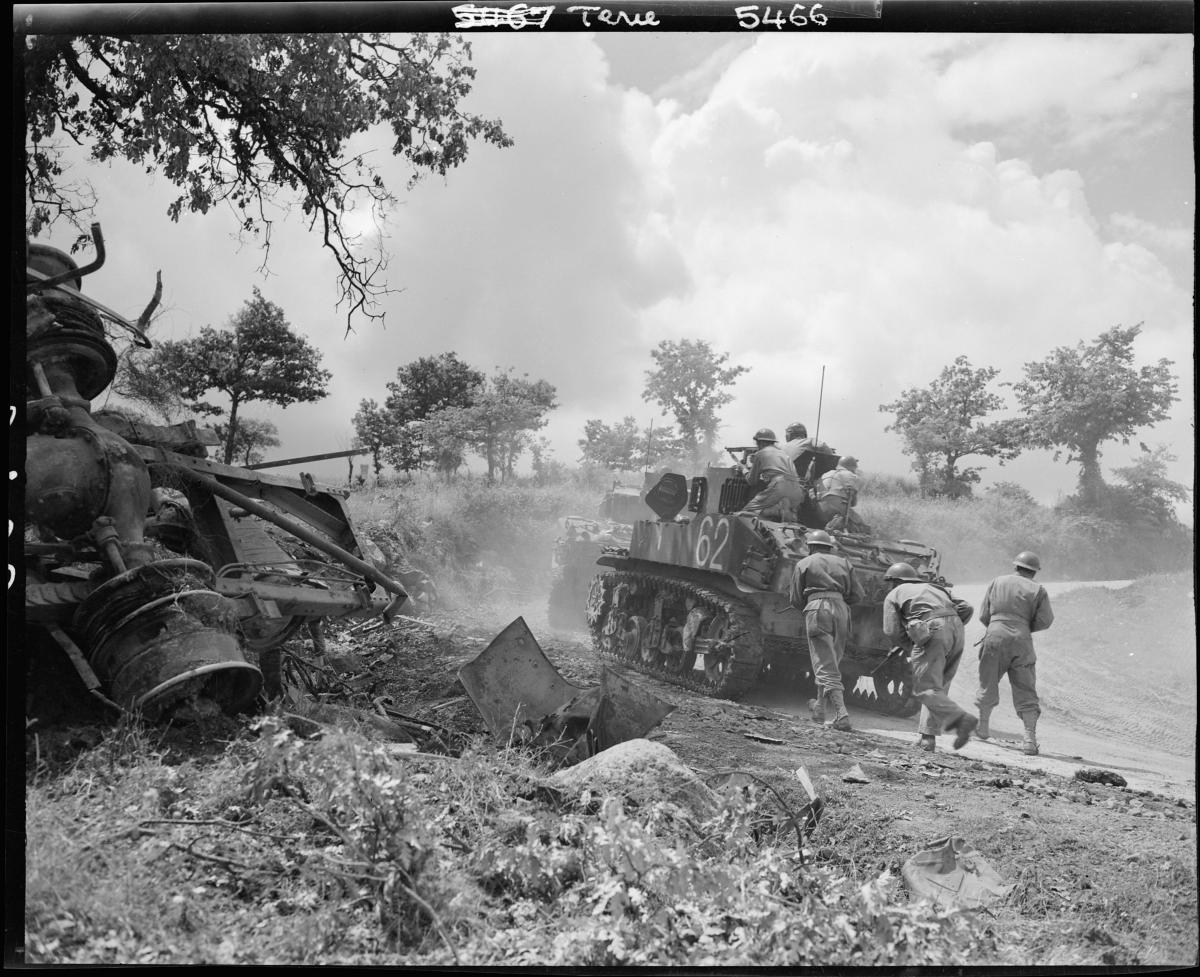
Campagne d'Italie. Progression d'un char léger de reconnaissance Stuart M5 du 3e RSM, 26 juin 1944.
© ECPAD, photographe inconnu. Réf. : TERRE 244-5466
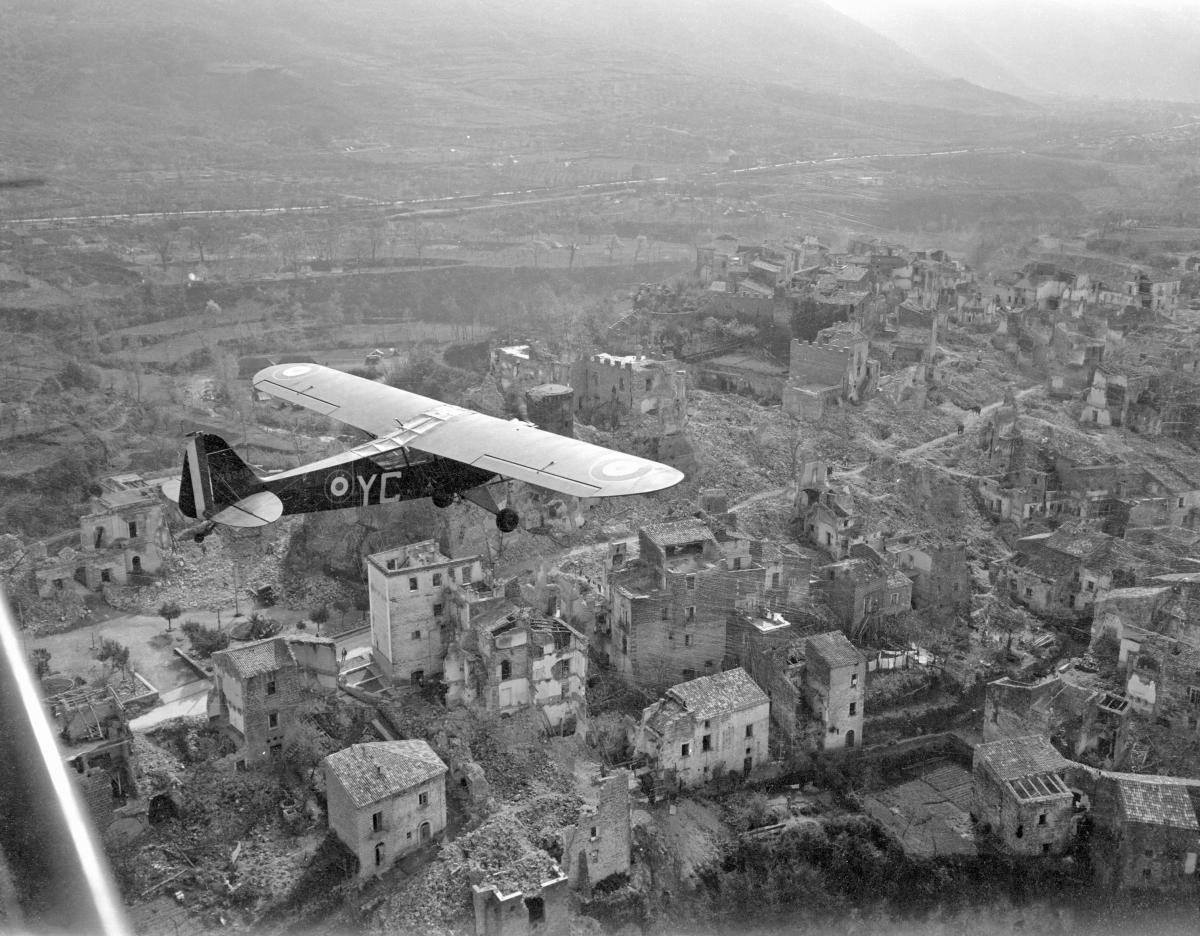
Vue aérienne de Miguano en Italie survolé par un "Piper-Cub". Printemps 1944.
© ECPAD, photographe Tourtois. Réf. : AIR 96-1839
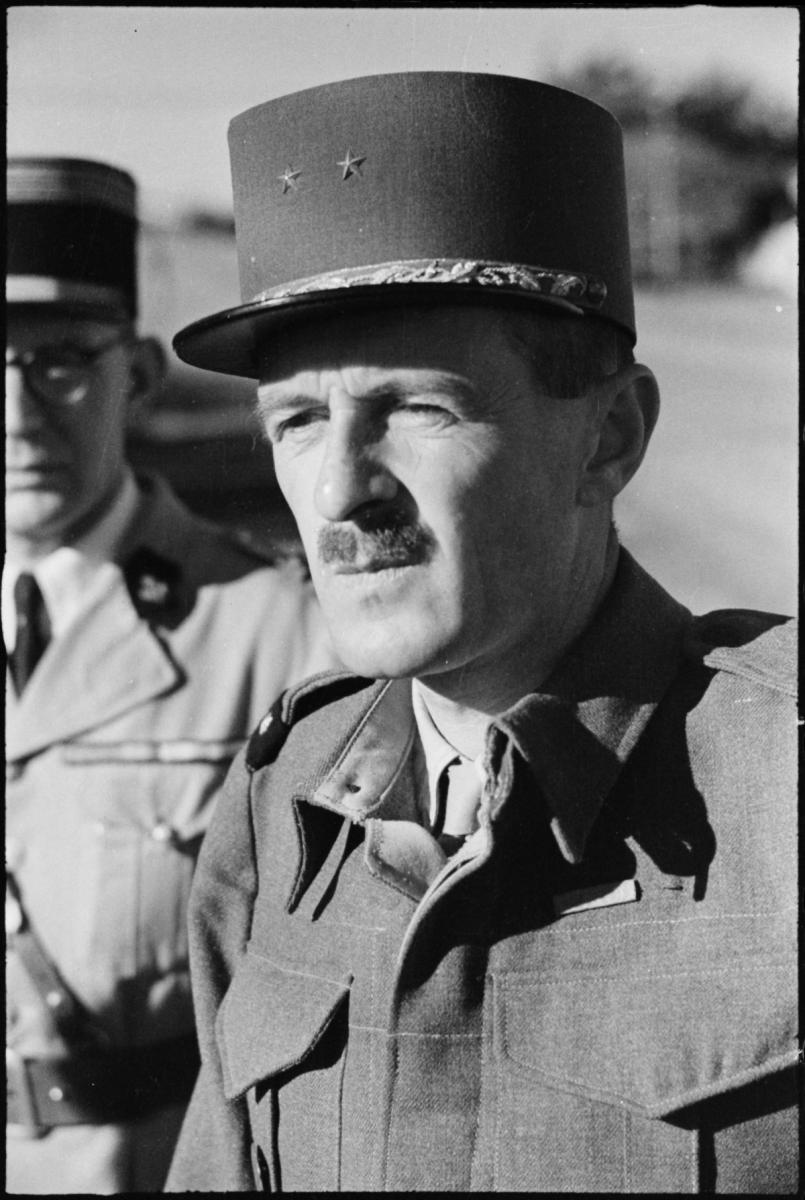
Le général Leclerc à Temara au Maroc, octobre 1943. C'est à Temara que fut formée la 2e division blindée.
© ECPAD, photographe inconnu. Réf. : TERRE 114-L2346
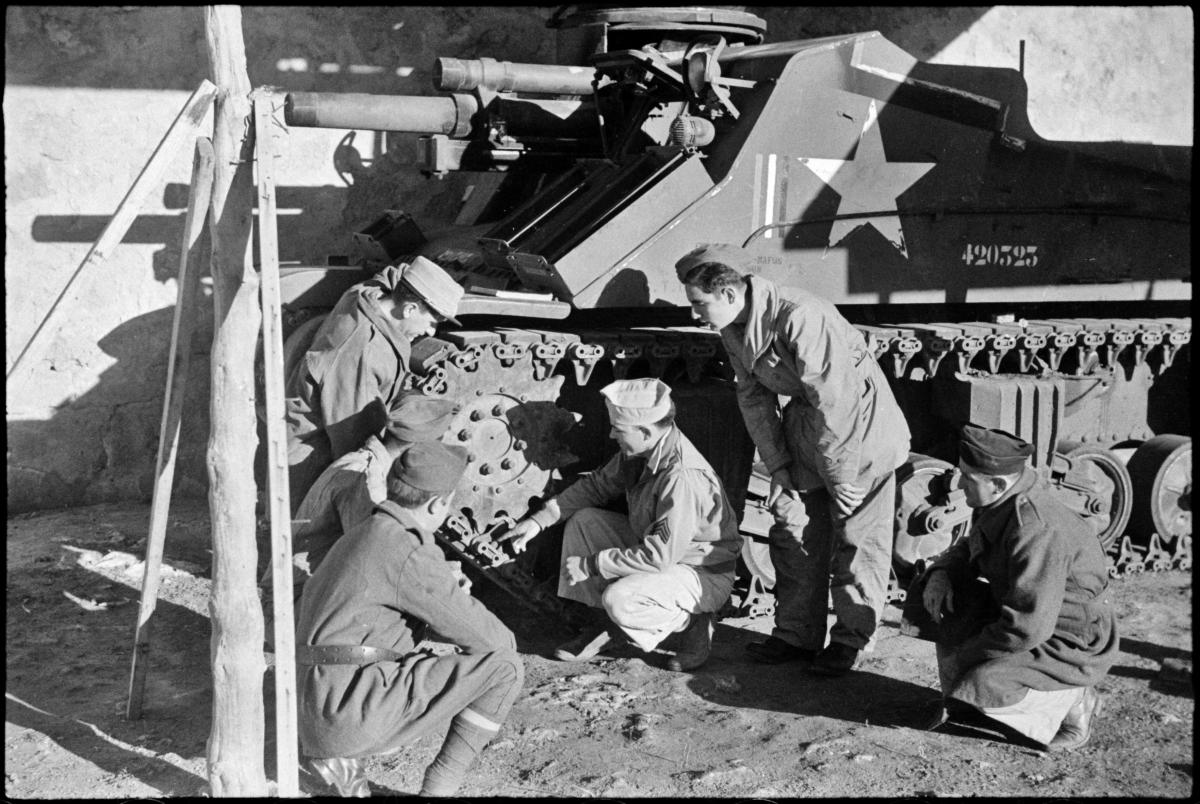
Au centre d'instruction de la 2e DB (Division blindée) de Temara au Maroc, des soldats français suivent l'instruction d'un sergent instructeur américain sur un obusier automoteur de 105 mm Howitzer Motor Carriage M7. Octobre 1943.
© ECPAD, photographe SCA. Réf. : TERRE 114-L2356
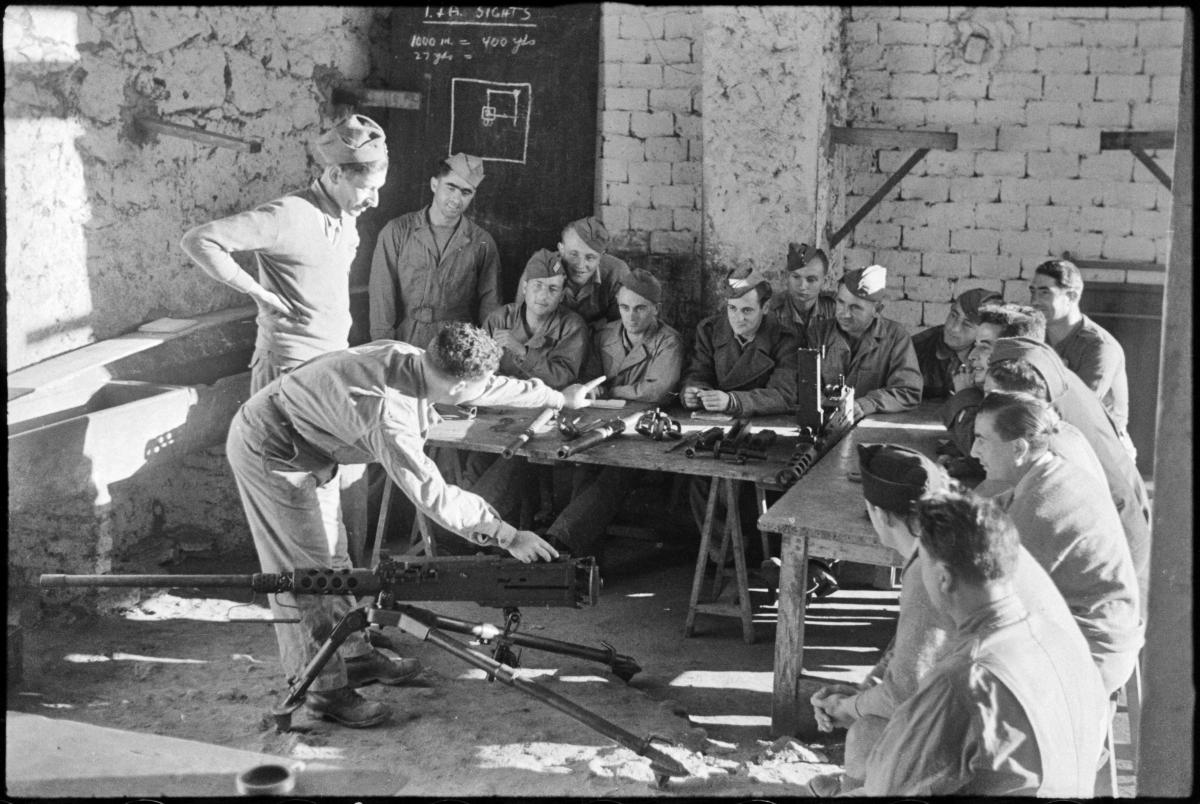
Au centre d'instruction de la 2e DB (Division blindée) de Temara au Maroc, un sous-officier instructeur américain explique le fonctionnement d'une mitrailleuse de 12,7 mm Browning M2. Octobre 1943.
© ECPAD, photographe SCA. Réf. : TERRE 114-L2354
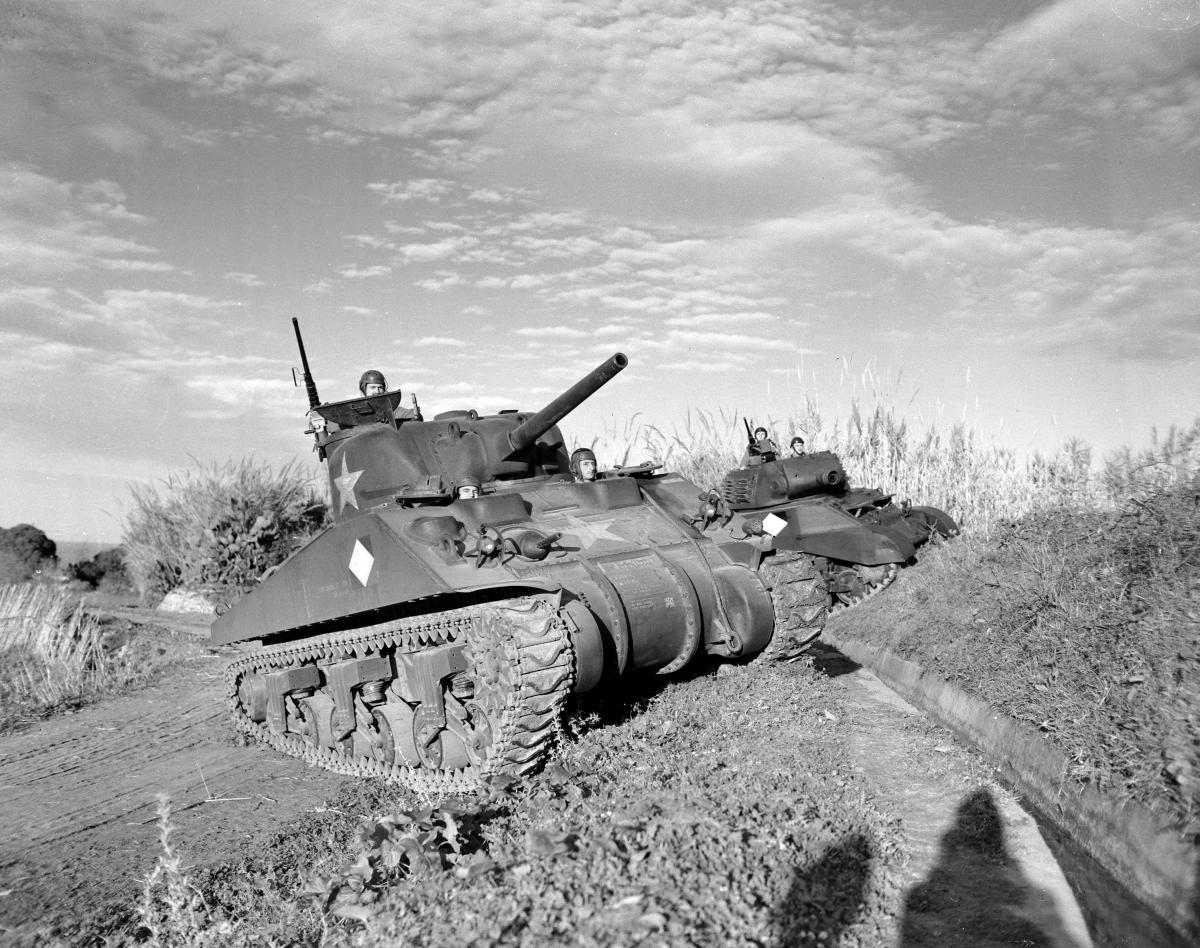
Ecole des élèves aspirants de Cherchell (Algérie) : instruction et entraînement sur un char Sherman M4 et un obusier automoteur de 75 mm Howitzer Motor Carriage M8, le 10 décembre 1943.
© ECPAD, photographe SCA. Réf. : TERRE 129-2779
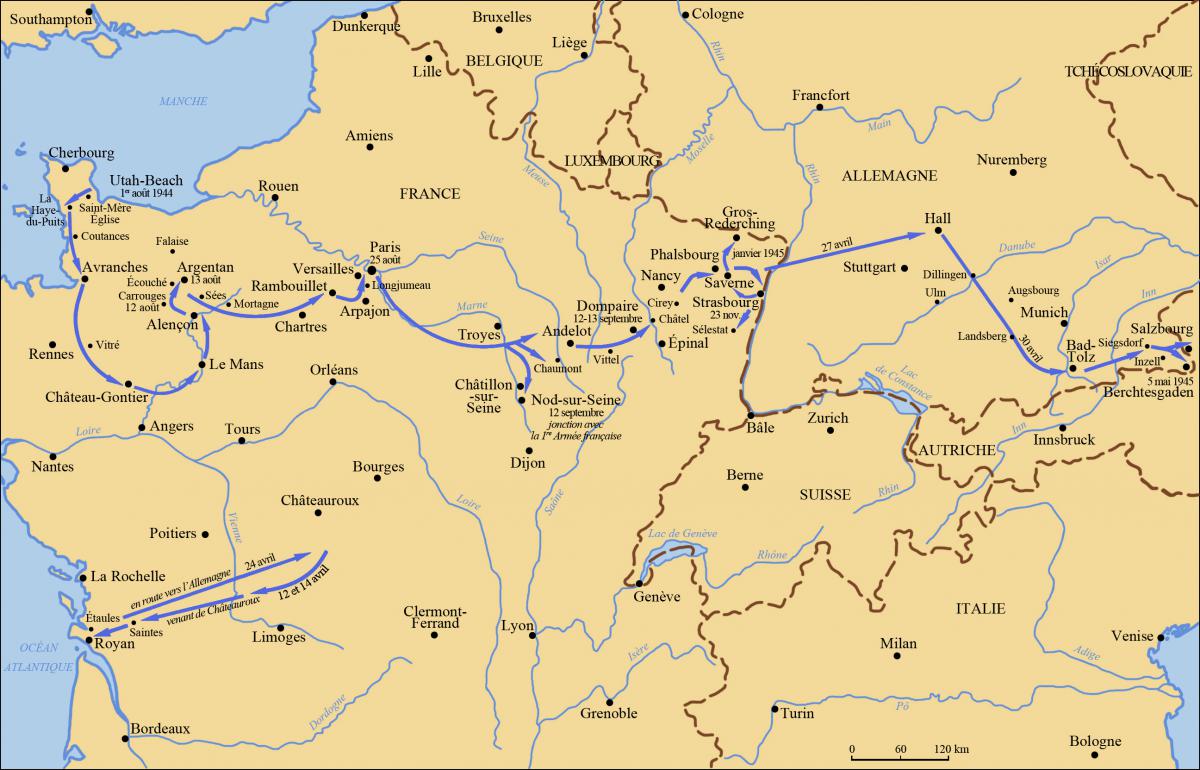
L'itinéraire de la 2e division blindée du général Leclerc, de la Normandie à l'Allemagne (août 1944 - mai 1945).
© Ministère de la défense
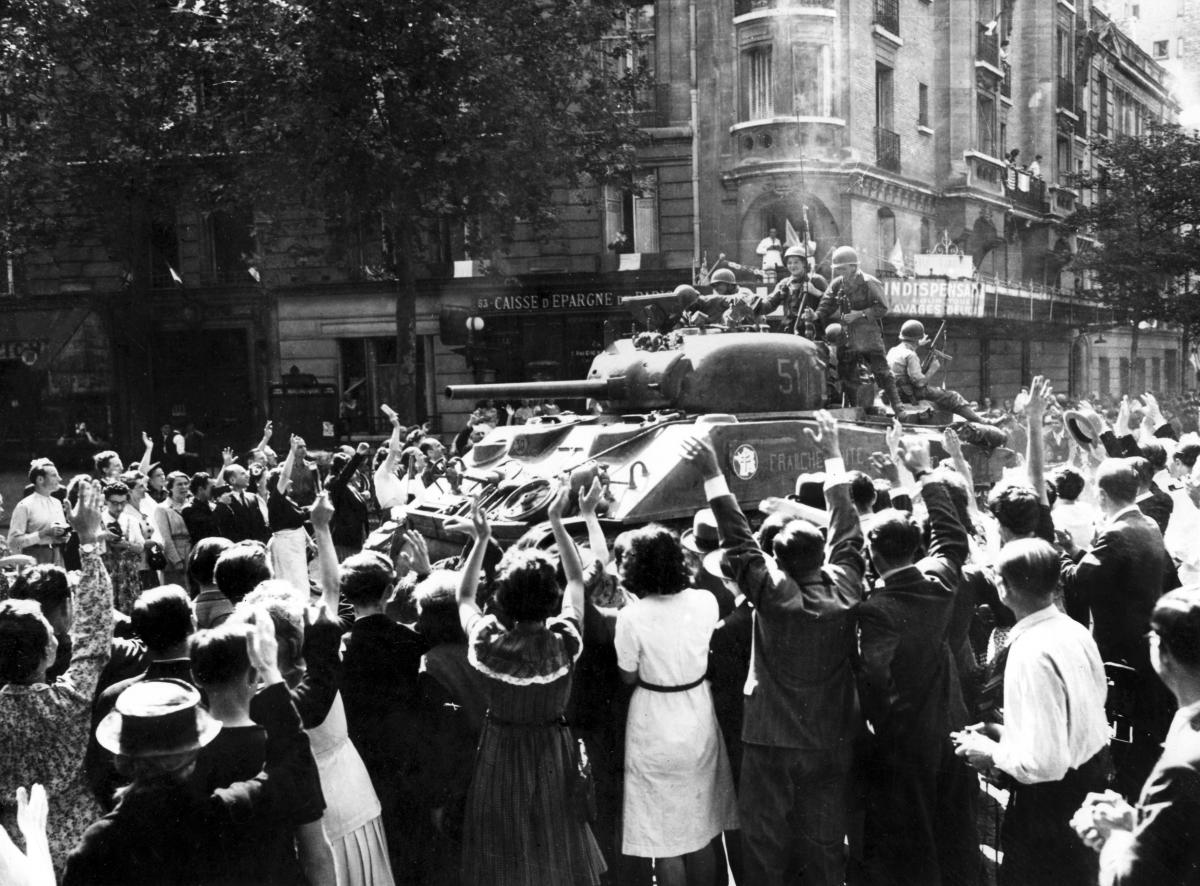
Des chars de la 2e division blindée du général Leclerc sont accueillis par la foule en liesse des Parisiens libérés, 25 août 1944.
© collection particulière
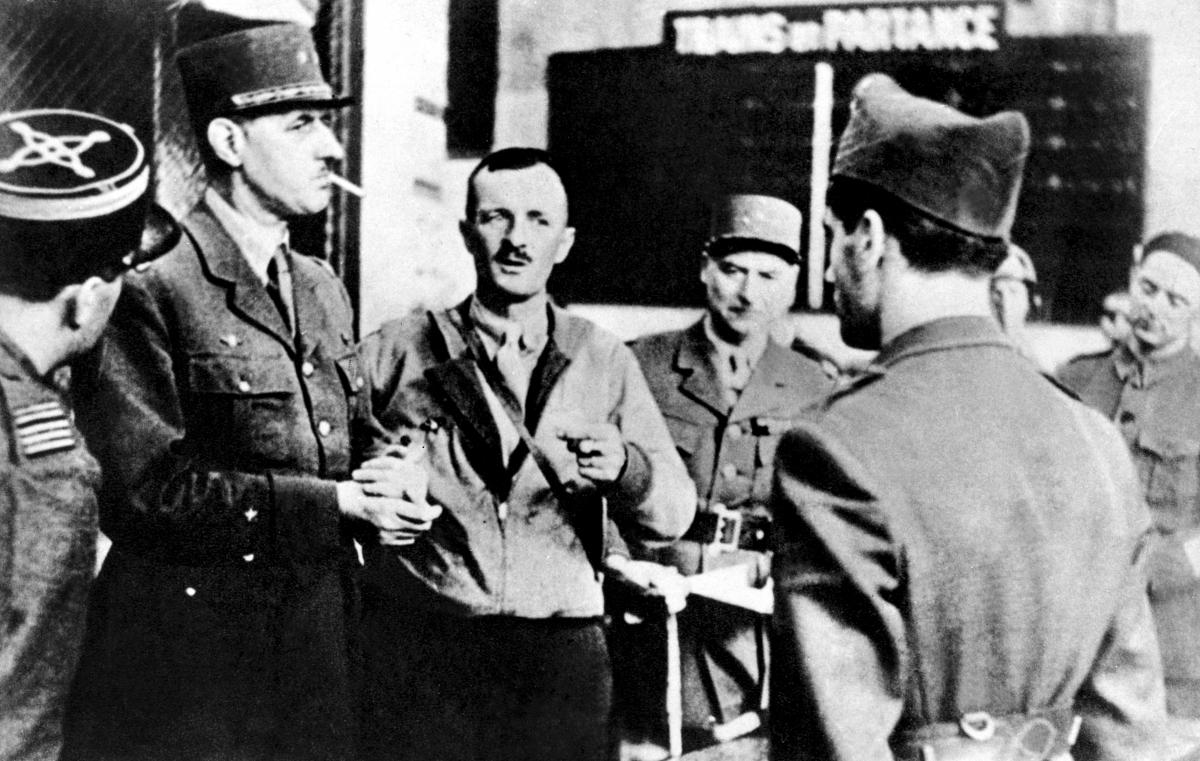
Paris, gare Montparnasse, le 25 août 1944. Le général Leclerc remet au général de Gaulle l'acte de capitulation des troupes d'occupation de la capitale signé une heure auparavant par le général von Choltitz.
© collection particulière
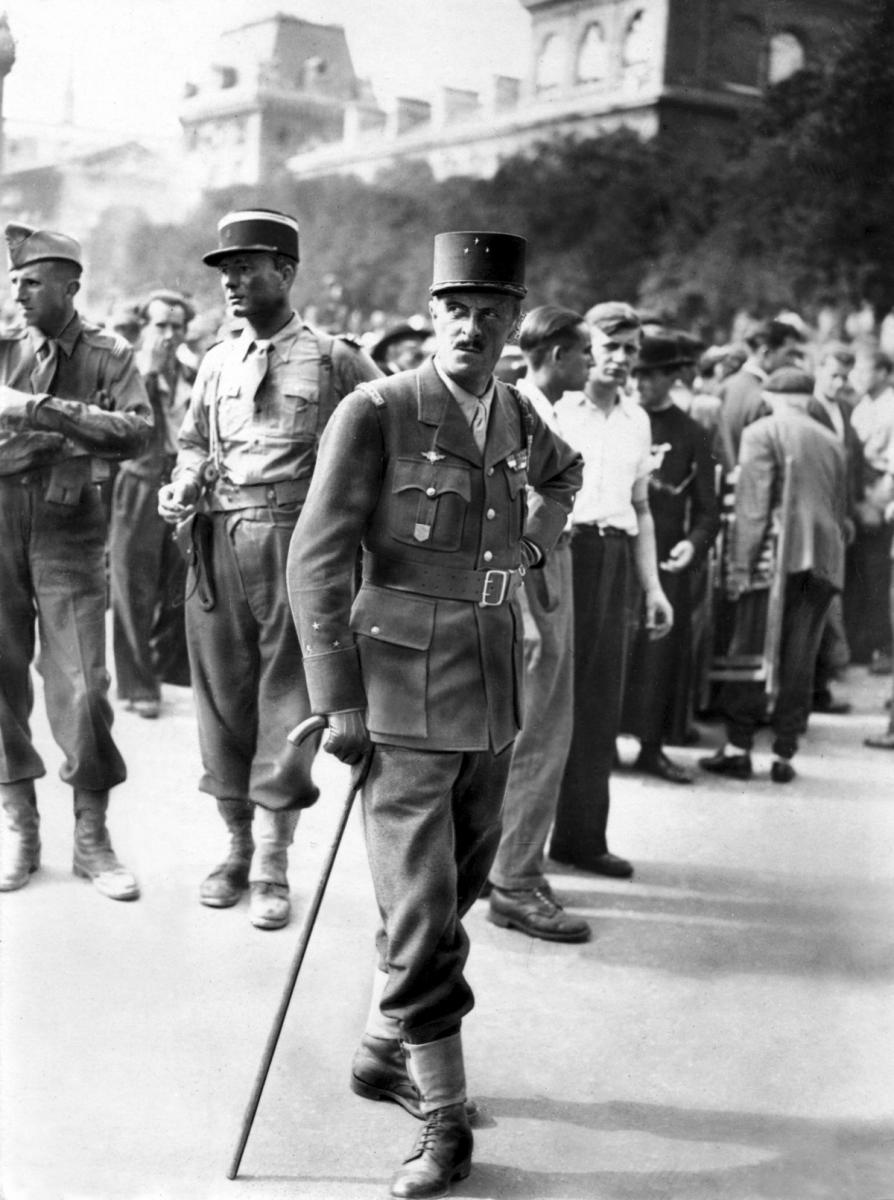
Le général Leclerc devant Notre-Dame de Paris, 25 août 1944.
© collection particulière
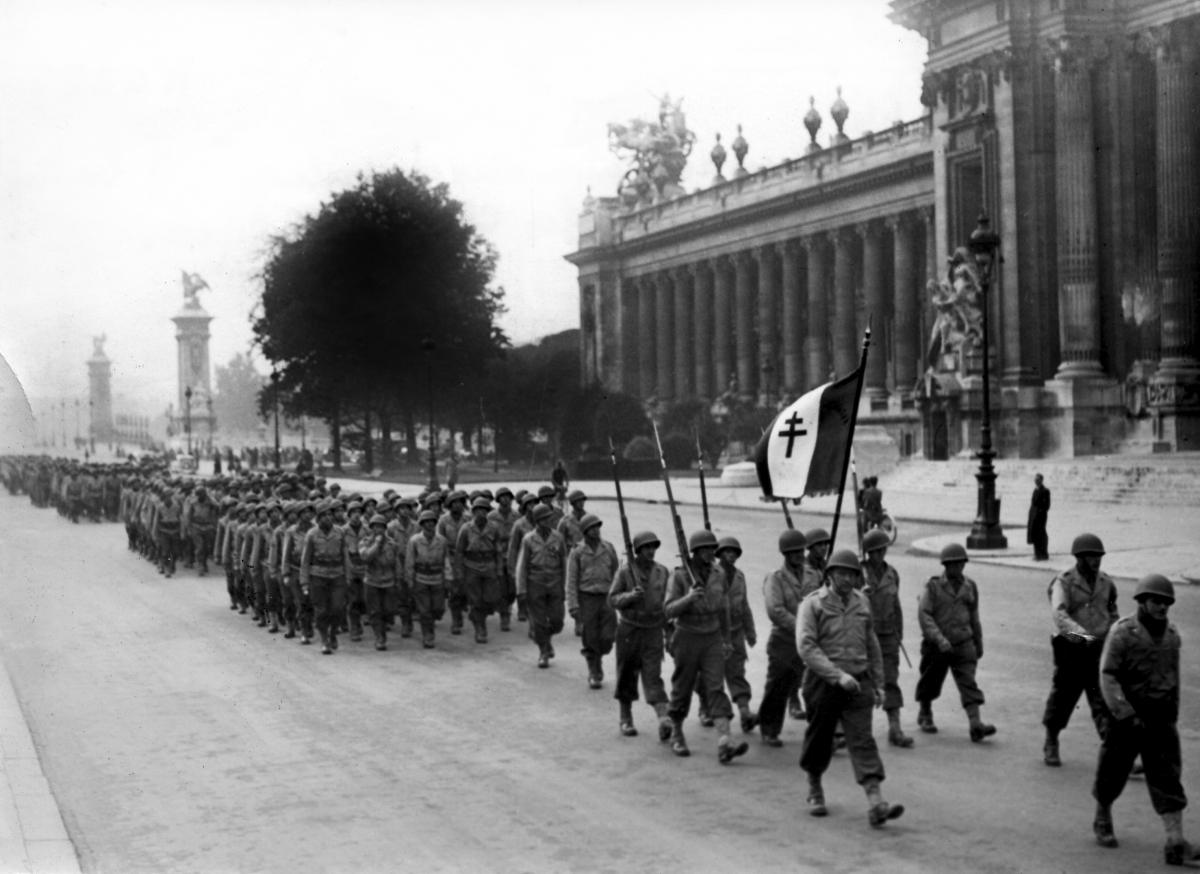
Après avoir été passés en revue aux Invalides, sept bataillons FFI ayant défilé sur les Champs Elysées passent devant le Grand Palais. Paris 6 octobre 1944.
© collection particulière
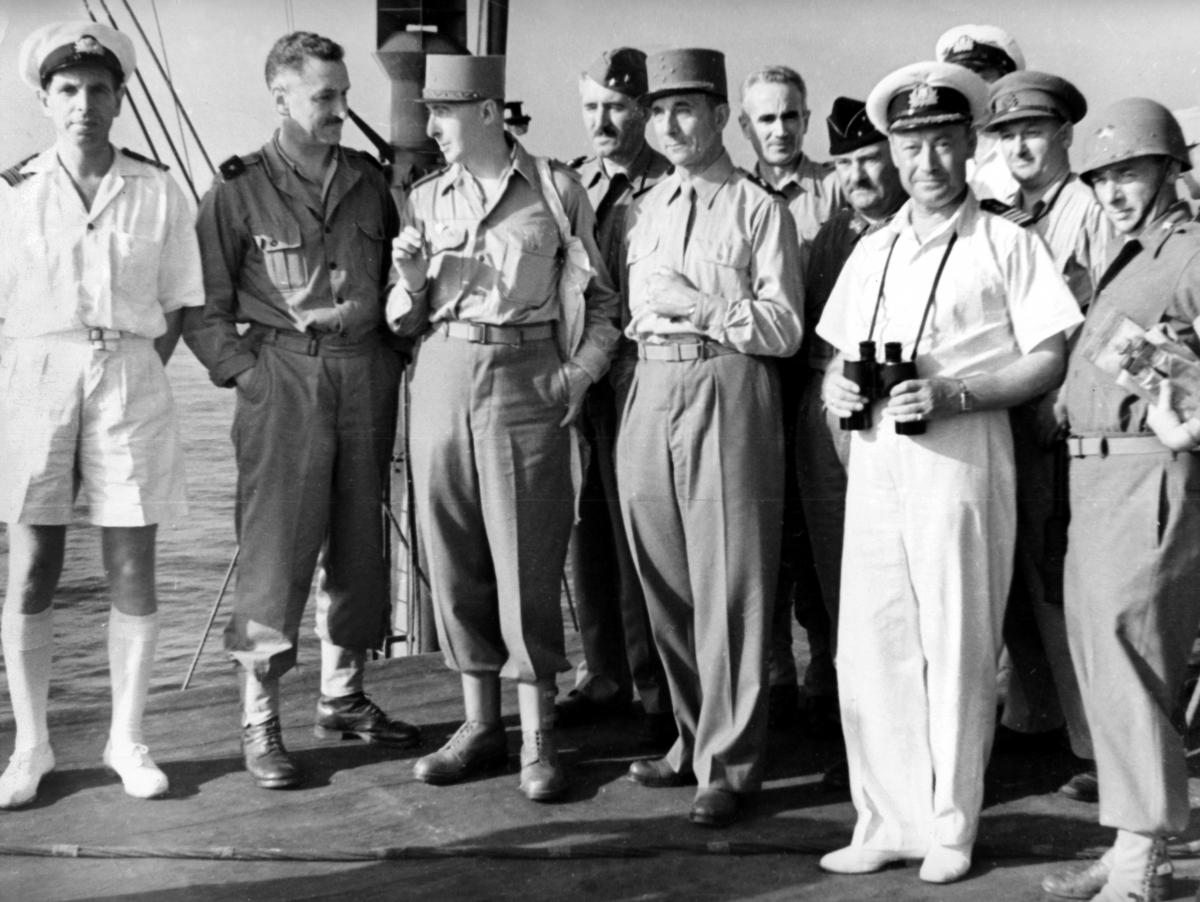
Membres de l'état-major de l'opération Anvil-Dragoon sur le pont du paquebot S.S. Batory qui se dirige vers les côtes de Provence, le 16 août 1944. Au centre, le général de Lattre de Tassigny.
© ECPAD, photographe inconnu. Réf. : TERRE 265-5932
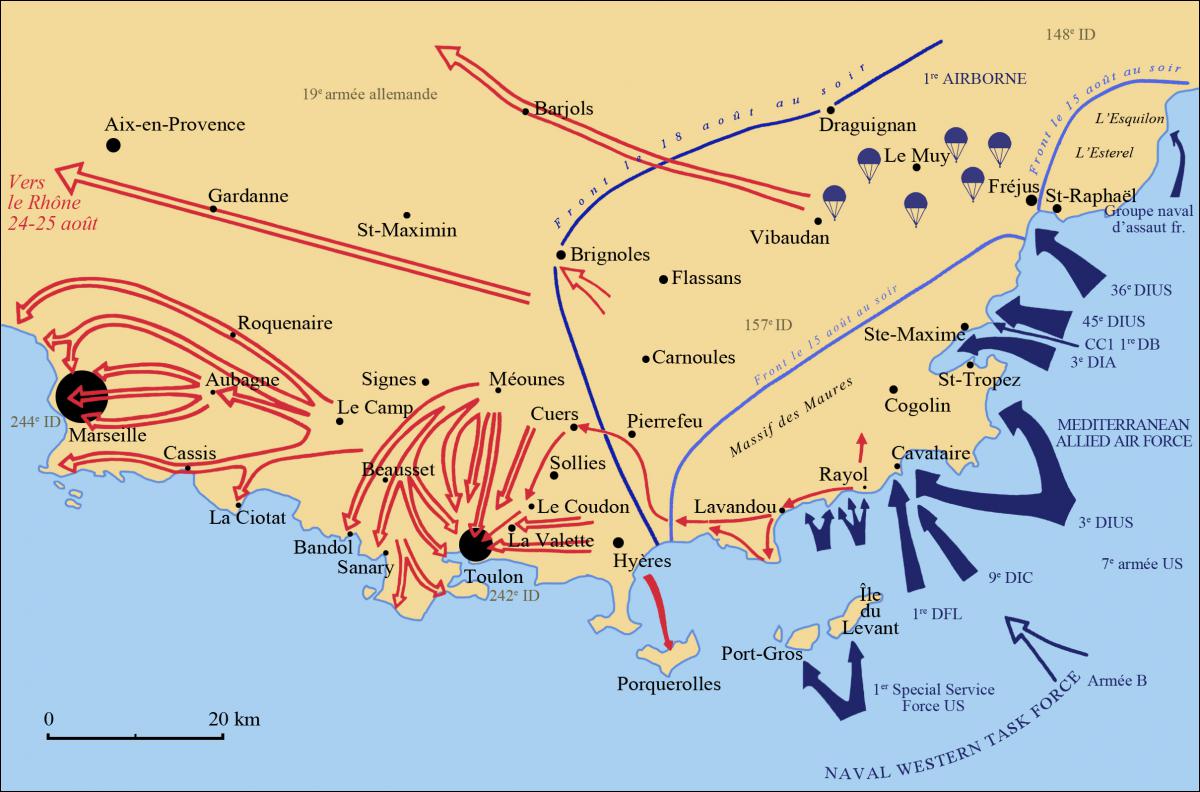
Le débarquement de Provence, 15 août 1944
© Ministère de la défense
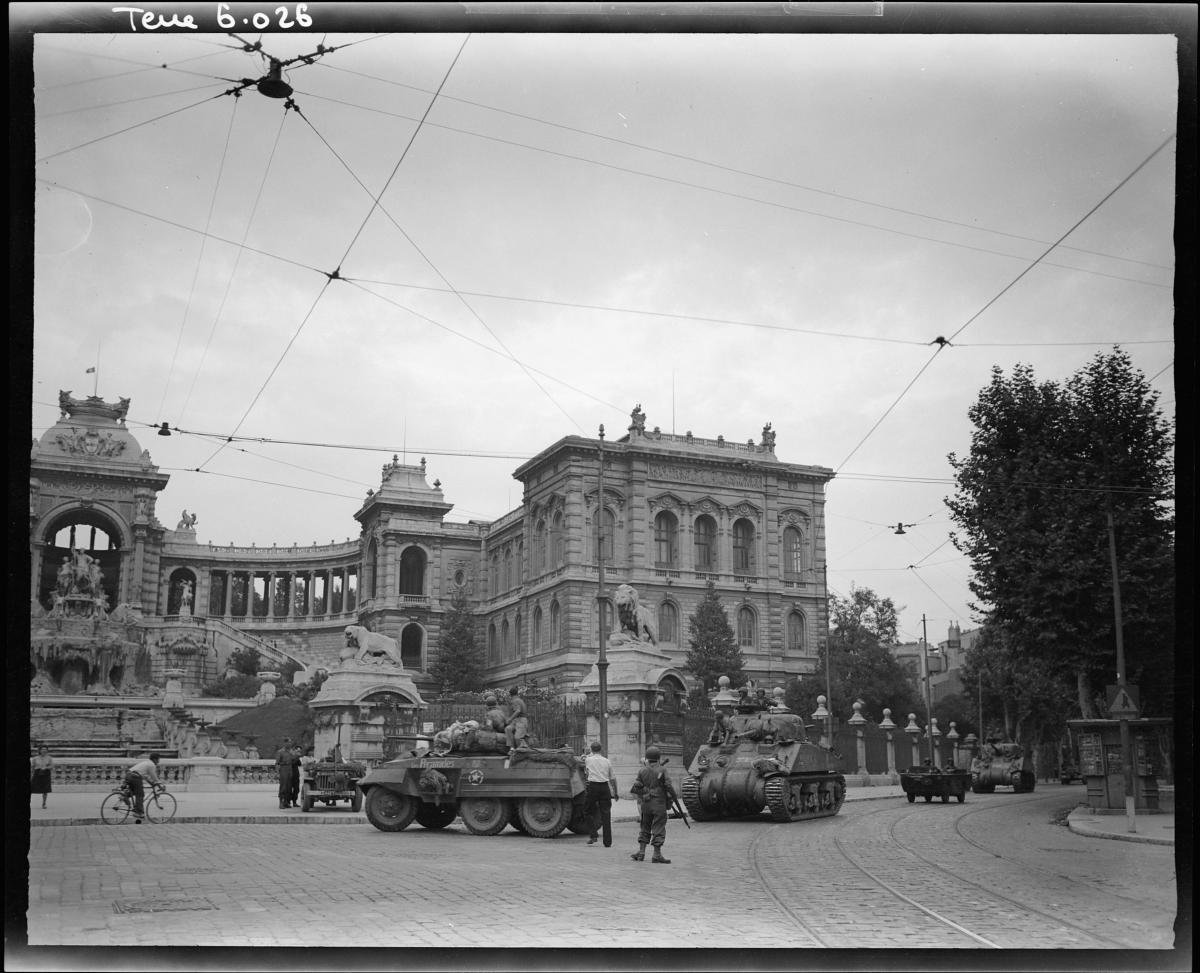
Les premiers chars Sherman et automitrailleuses M8 français du 2e régiment de Chasseurs d'Afrique de la 1ère division blindée arrivent dans Marseille (devant le palais Longchamp), 22-23 août 1944.
© ECPAD, photographe Jacques Belin. Réf. : TERRE 270-6026
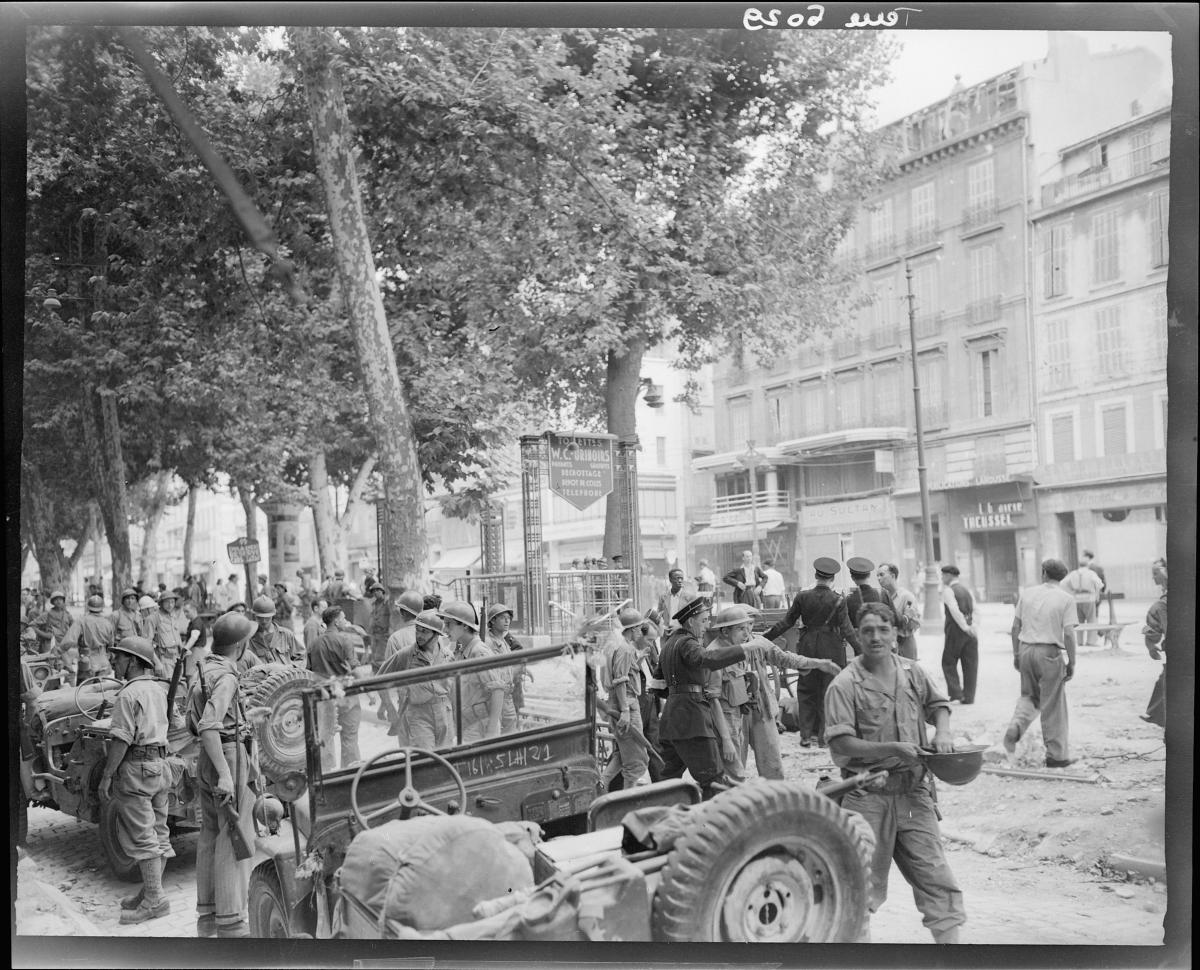
Allée de Meilhan à Marseille, entrée des premières jeeps françaises, 22-23 août 1944.
© ECPAD, photographe Jacques Belin. Réf. : TERRE 270-6029
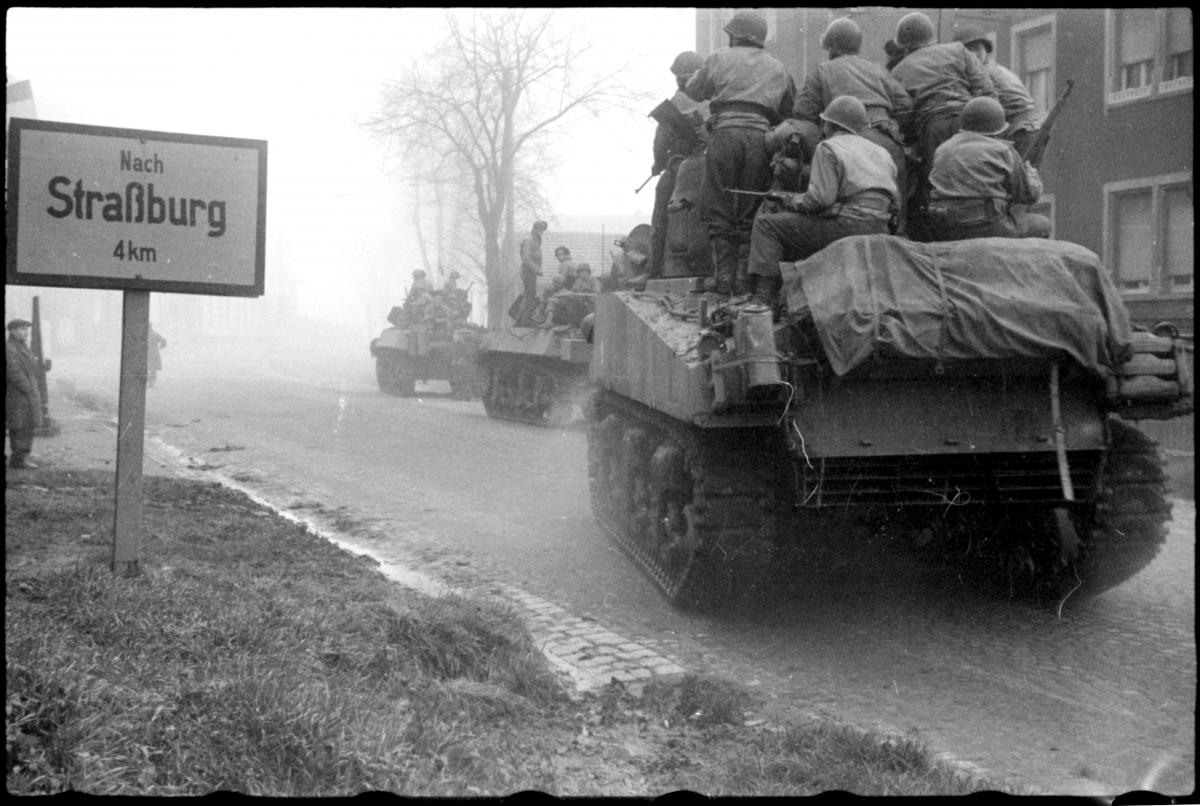
Progression des blindés Sherman M4 du 501e RCC (Régiment de Chars de Combat) dans les faubourgs de Strasbourg. Nov. 1944.
© ECPAD, photographe Raphel. Réf. : TERRE 364-8708
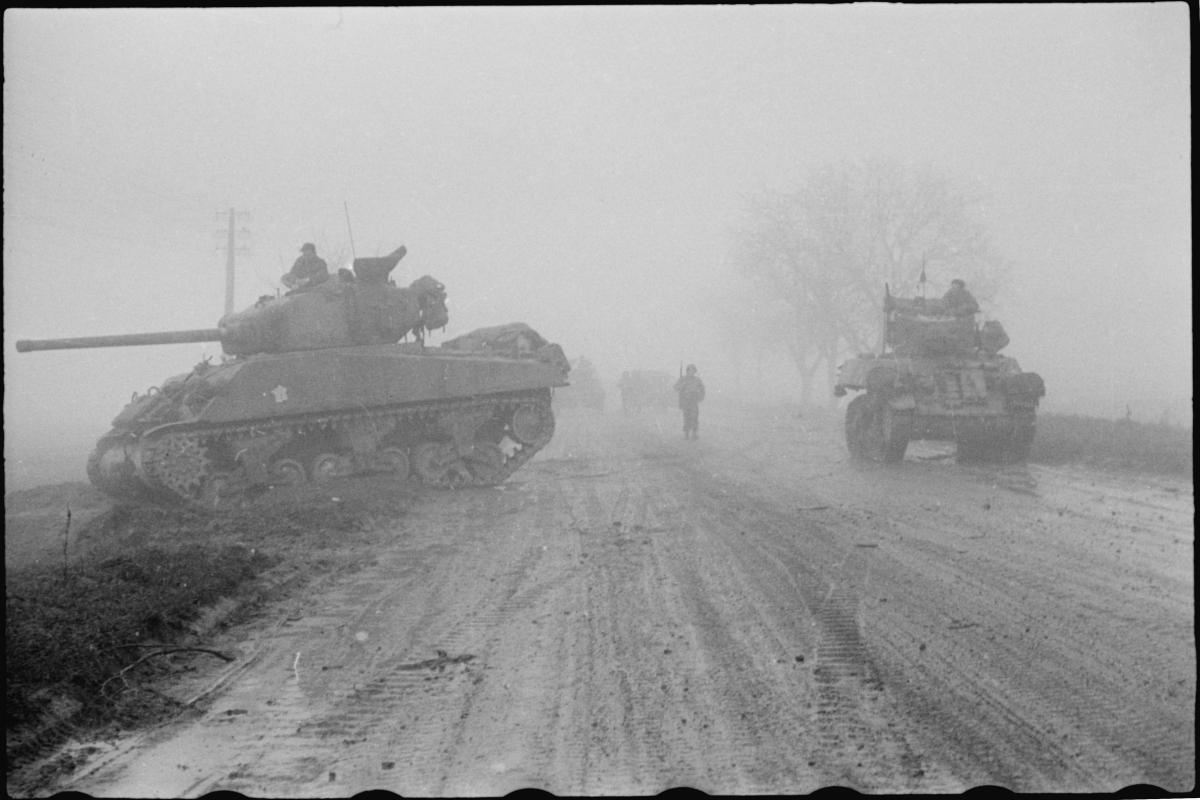
Dans le brouillard matinal, le Sherman M4 A3 "Médenine II" et le Stuart M3 A3 "Valmy" du 501e RCC (Régiment de Chars de Combat) sur la route qui mène à Starsbourg. Nov. 1944.
© ECPAD, photographe Raphel. Réf. : TERRE 364-8691
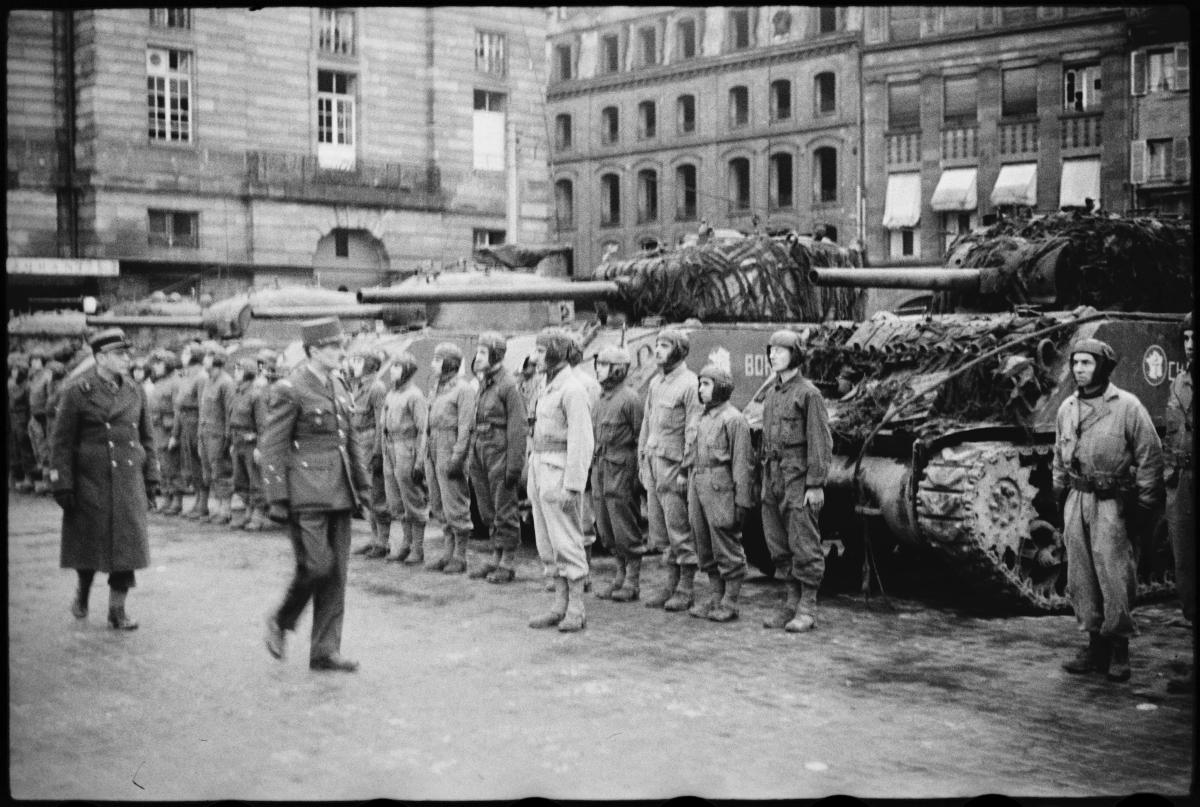
Le 26 novembre 1944, une prise d'armes a lieu place Kléber à Strasbourg pour célébrer sa libération. Le général Leclerc, à la tête de la 2e DB, passe en revue le 12e régiment de cuirassers.
© ECPAD, phot. Jacques Belin / Roland Lennad. Réf. : TERRE 339-L8192
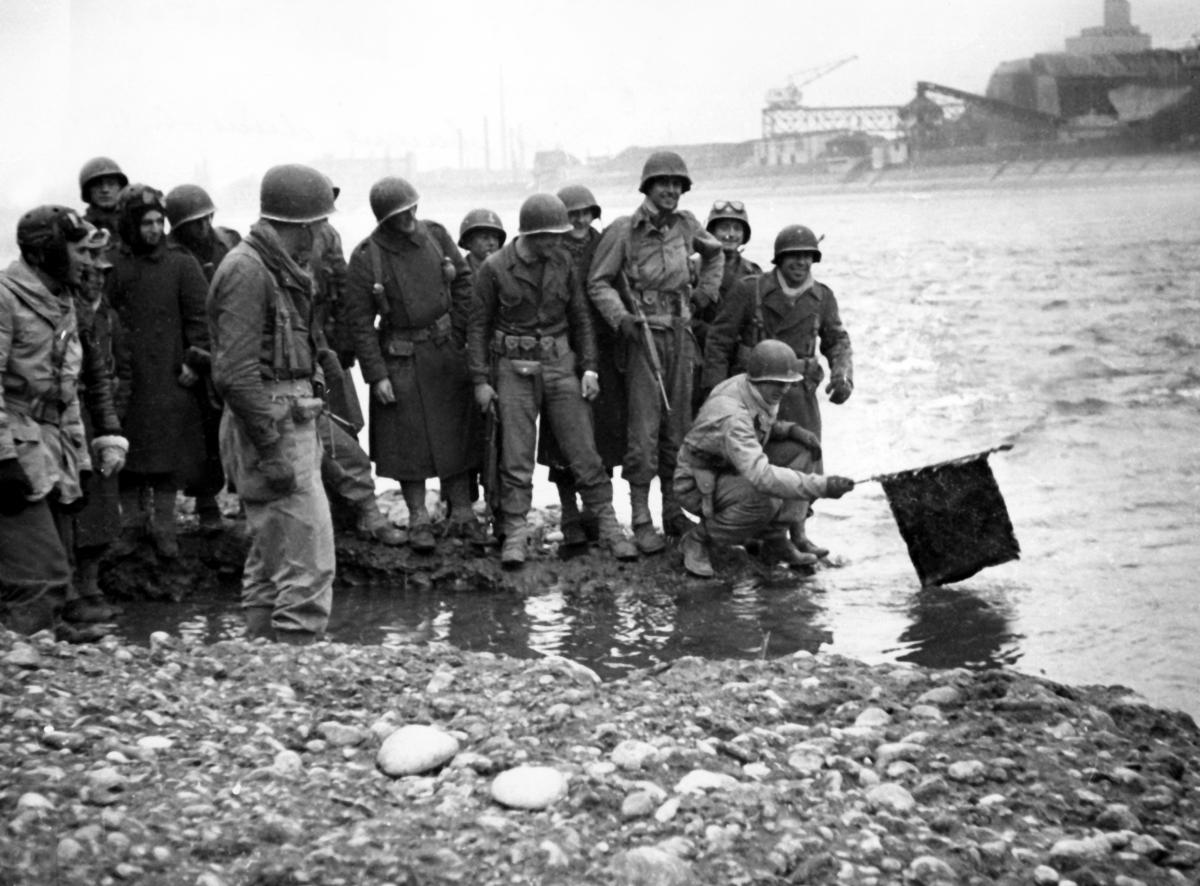
Campagne d'Allemagne. Des marsouins du peloton antichars du 3ème RCIM de la 9ème DIC trempent symboliquement le fanion du chef de peloton dans le Rhin à hauteur de Rosenau, 12-15 déc. 1944. Reconstitution d'une scène qui s'est déroulée le 20 nov. 1944.
© ECPAD, photographe Acerbi. Réf. TERRE 10035-L5
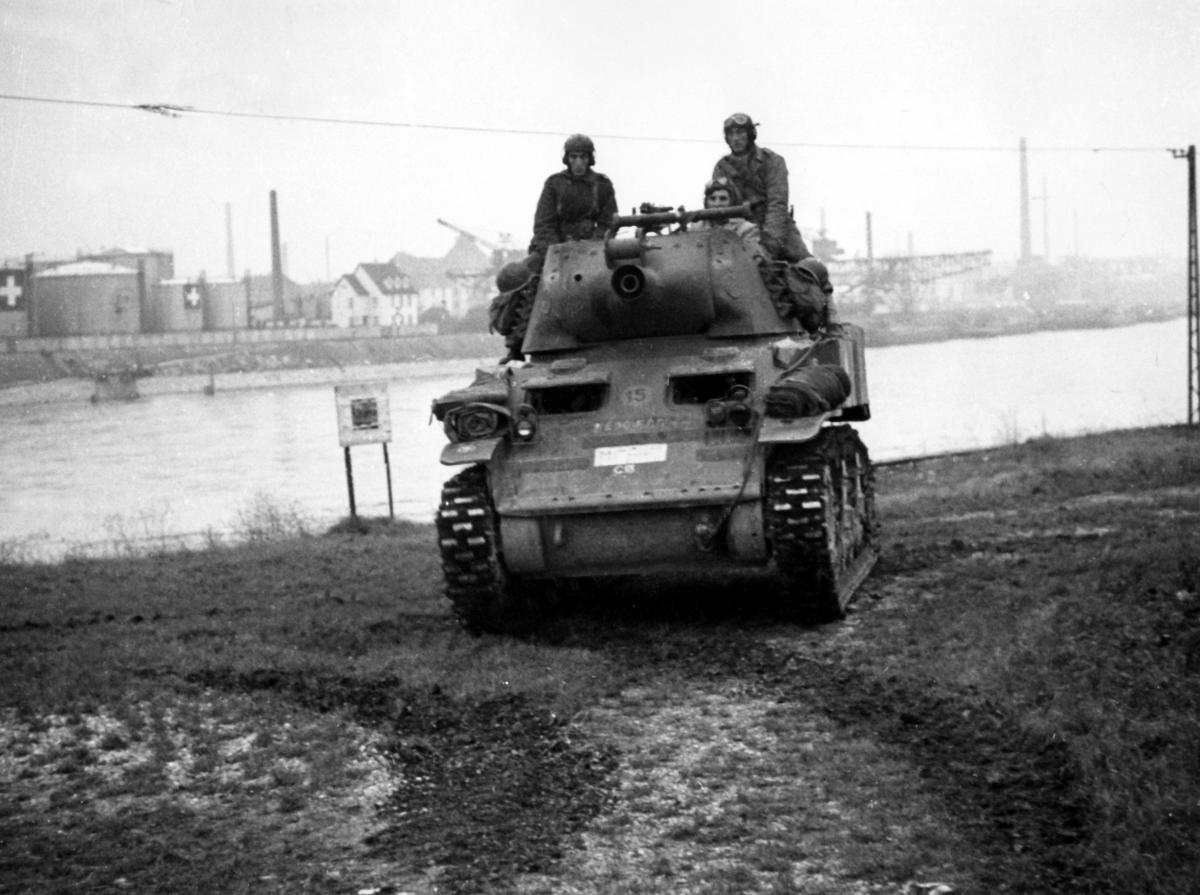
Campagne d'Allemagne, avril 1945. Des troupes françaises franchissent le Rhin. Le char Sherman est équipé d'un obusier de 105 mm à la place de son canon de 75 mm.
© Collection particulière
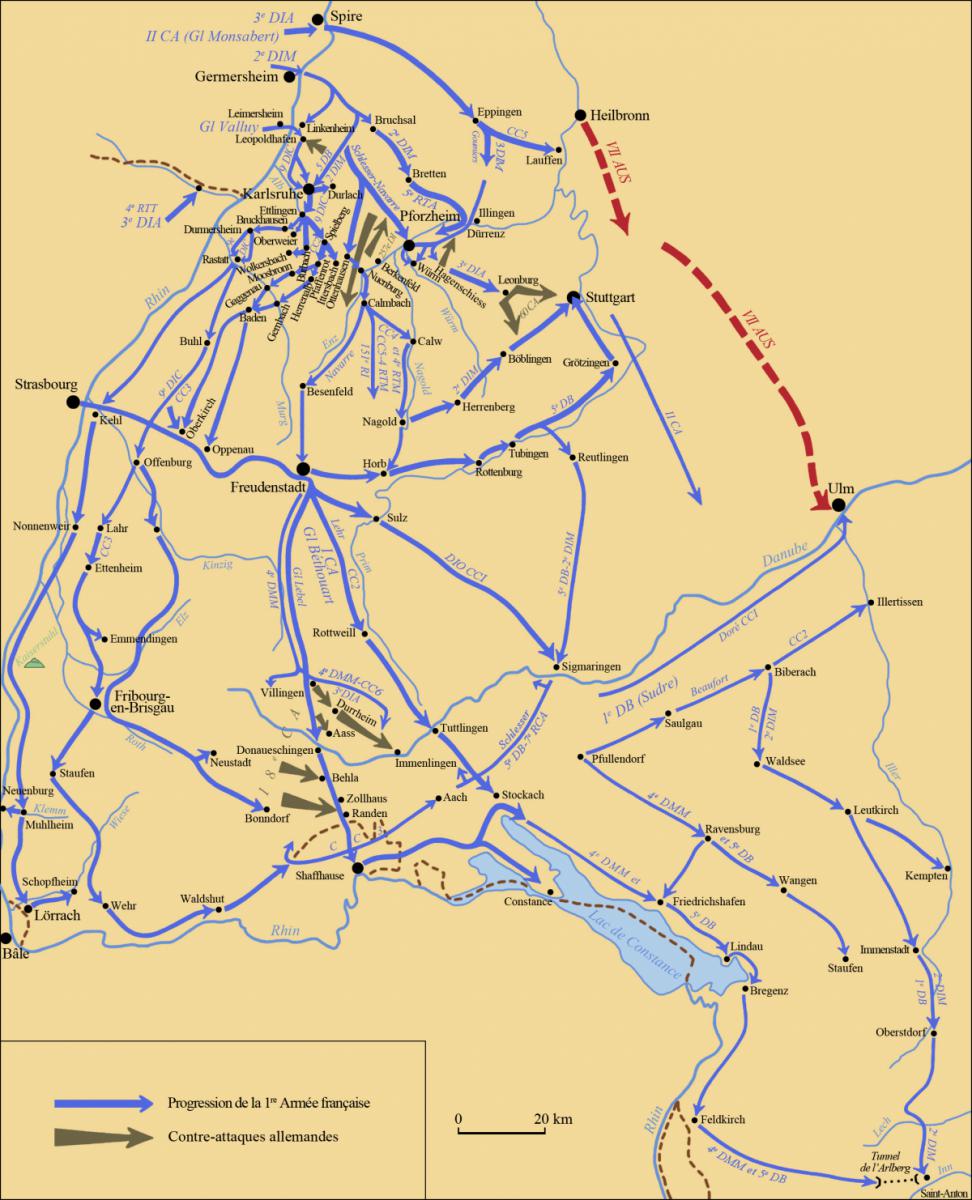
La 1ère Armée du général de Lattre de Tassigny dans la campagne d'Allemagne (mars - mai 1945).
© Ministère de la défense
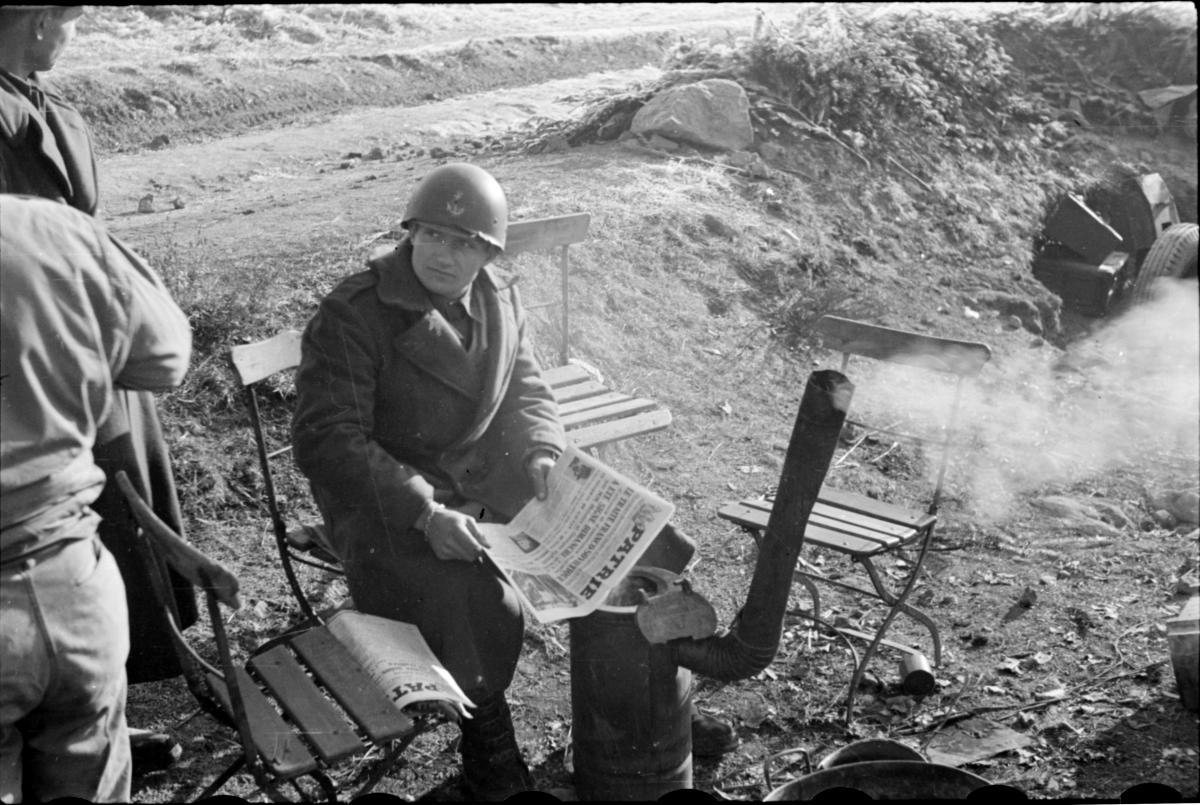
Un bigor (soldat de l'Artillerie de Marine) d'un groupe des Forces Terrestres Anti-Aériennes lit le numéro de "Patrie, journal des combattants français", annonçant la signature du traité d'alliance franco-soviétique. Déc. 1944.
© ECPAD, photographe P. R. Vignal. Réf. : TERRE 10013-L108
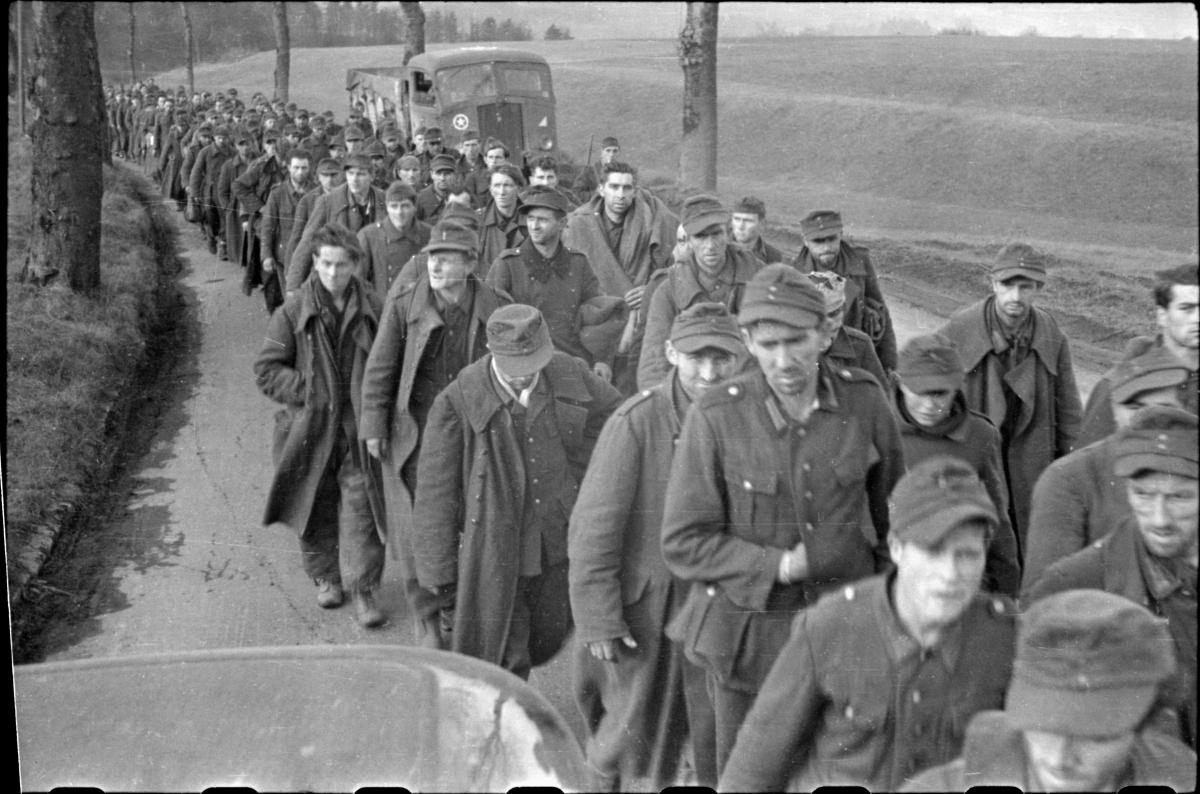
Après les combats pour la libération du village du Bonhomme, une colonne de prisonniers allemands gagne les lignes françaises. Déc. 1944.
© ECPAD, photographe Pierre Raoul Vignal. Réf. : TERRE 10013-L91
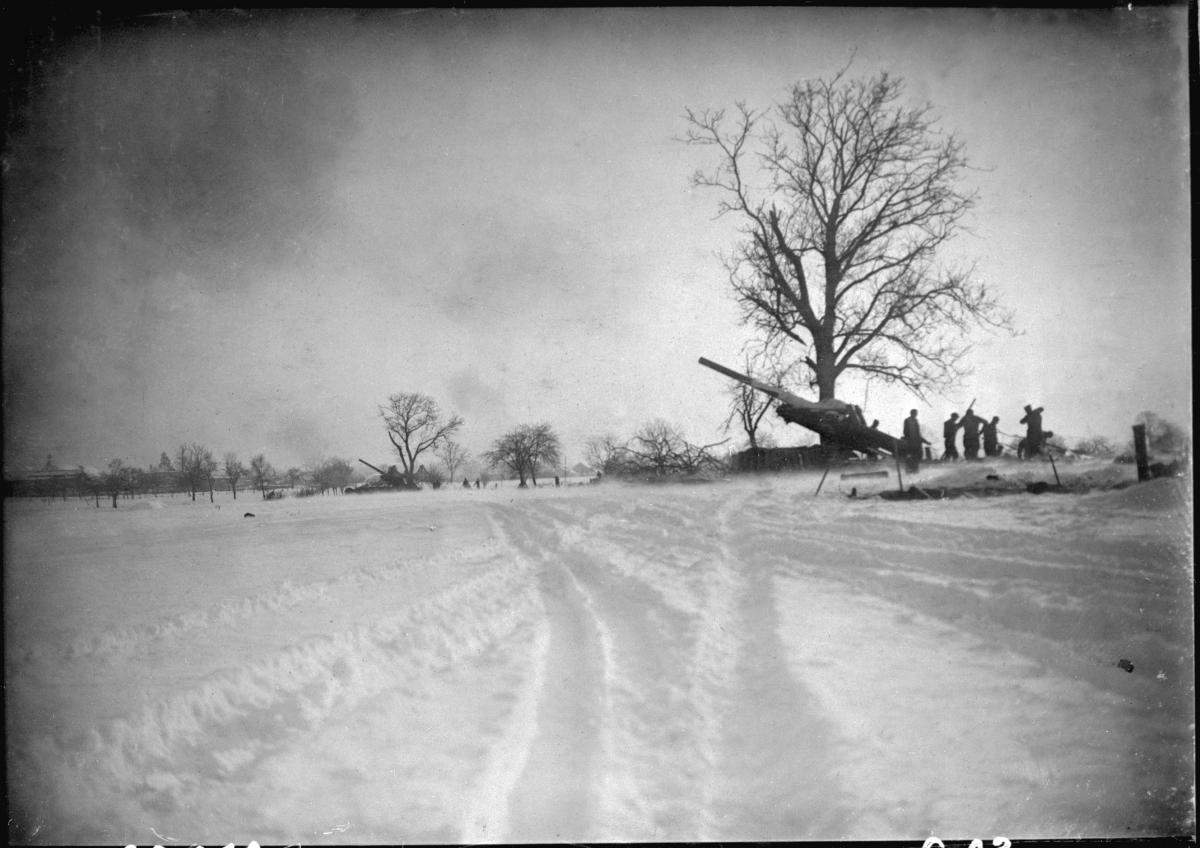
Batterie américaine de 203 mm en action entre Guémar et Ostheim. Janvier 1945.
© ECPAD, photographe Henri Malin. Réf. : TERRE 10114-G12
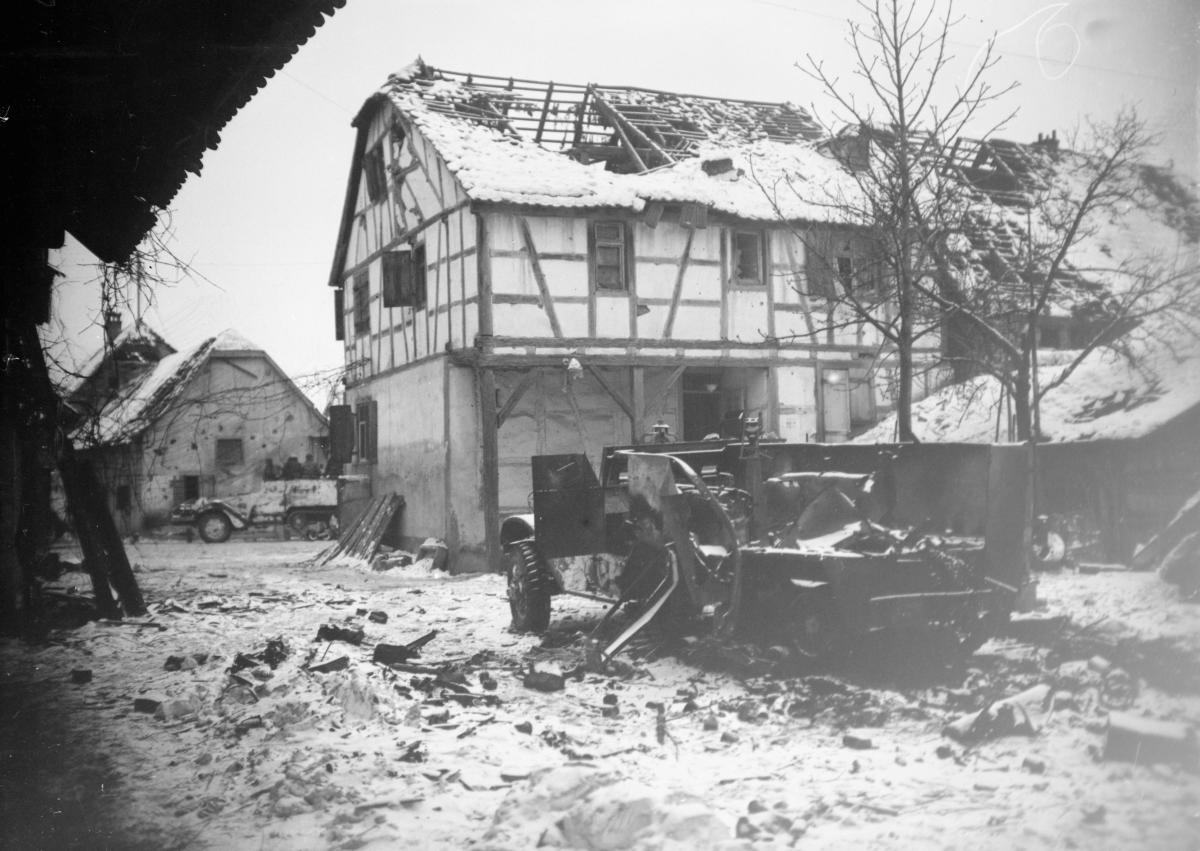
Un half-track de la 254e division d'infanterie américaine détruit dans une ferme entre Ostheim et Jebsheim. Janvier 1945.
© ECPAD, photographe Henri Malin. Réf. : TERRE 10114-G21
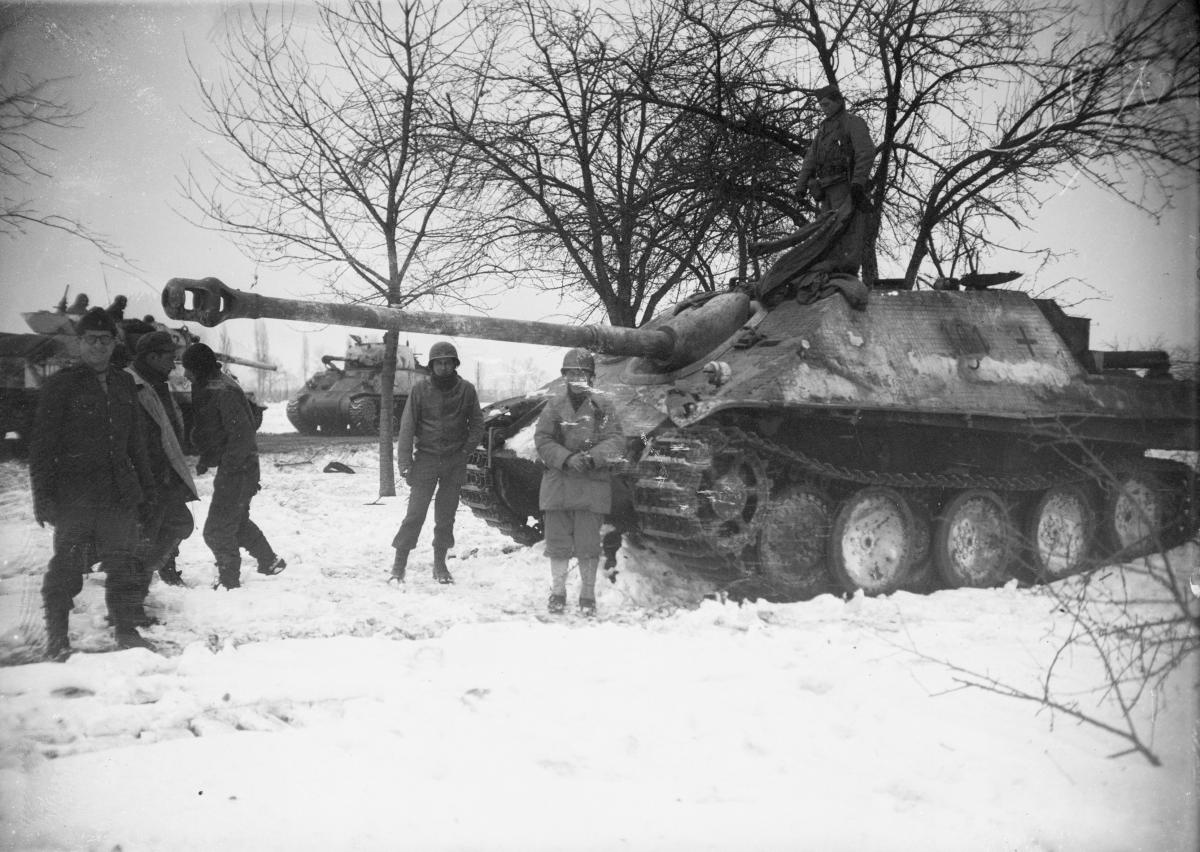
Le 30 janvier 1945, la Schwere.Panzer-Jäger-Abteilung.654 (Bataillon lourd de chasseur de chars ) a perdu cinq Jagdpanther lors de combats à l'est de Jebsheim.
© ECPAD, photographe Henri Malin. Réf. : TERRE 10114-G34
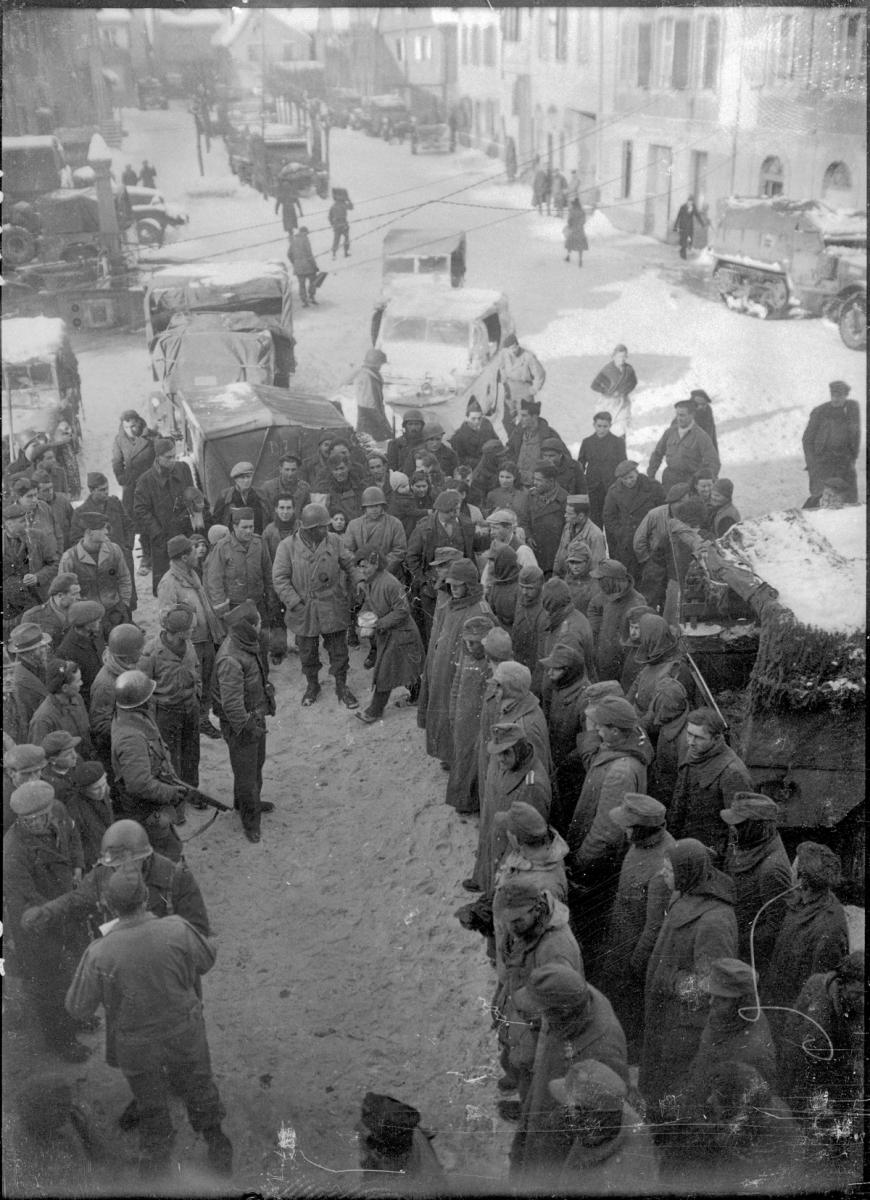
Premiers prisonniers allemands au début de l'offensive rassemblée devant le PC du CC 6 (Combat Command) installé dans la mairie de Bergheim. Janvier 1945.
© ECPAD, photographe Henri Malin. Réf. : TERRE 10114-G05
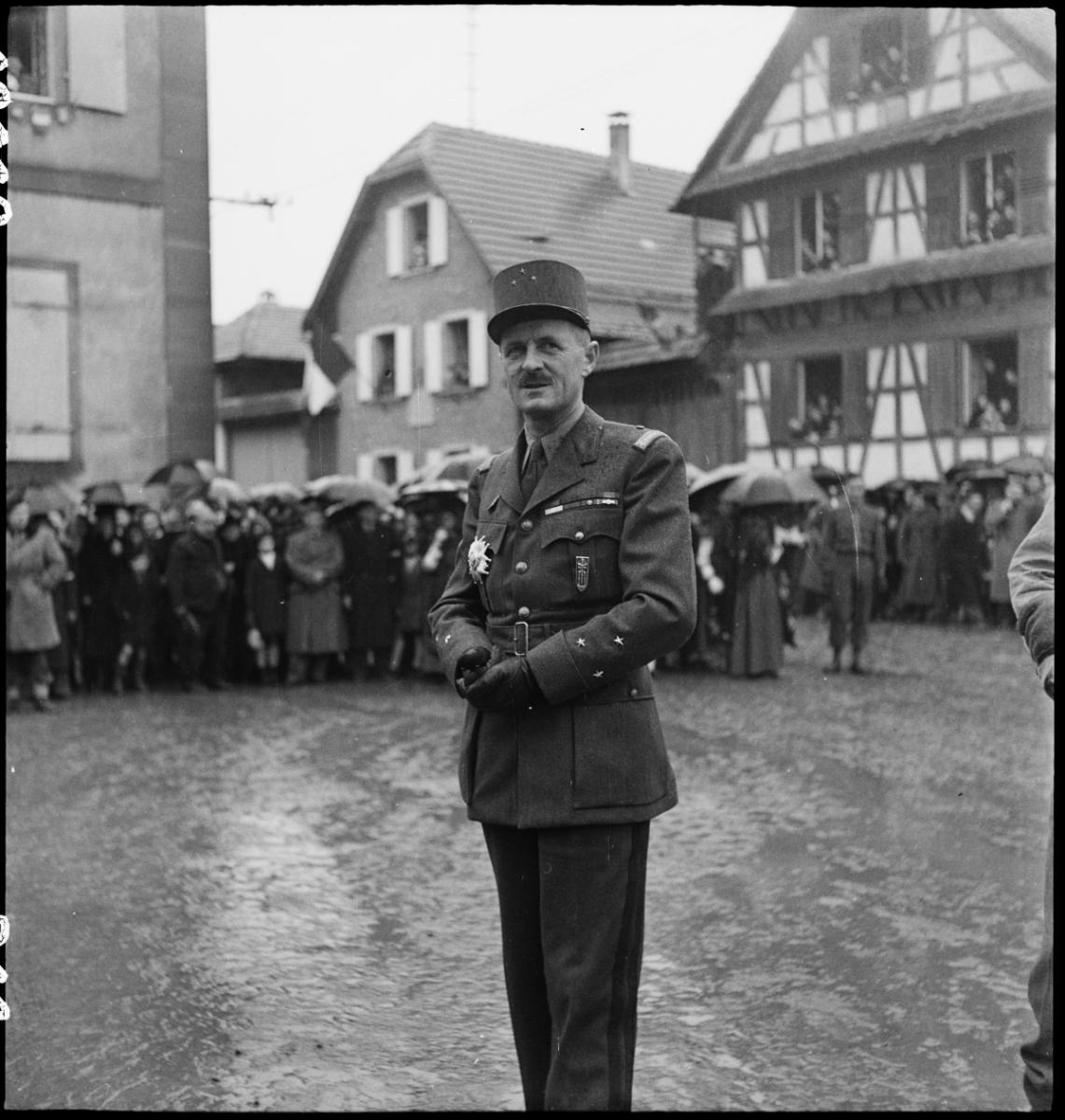
Le général de division Leclerc à Geispolsheim (Bas-Rhin), février 1945.
© ECPAD, photographe André Gandner. Réf. : TERRE 10110-R16
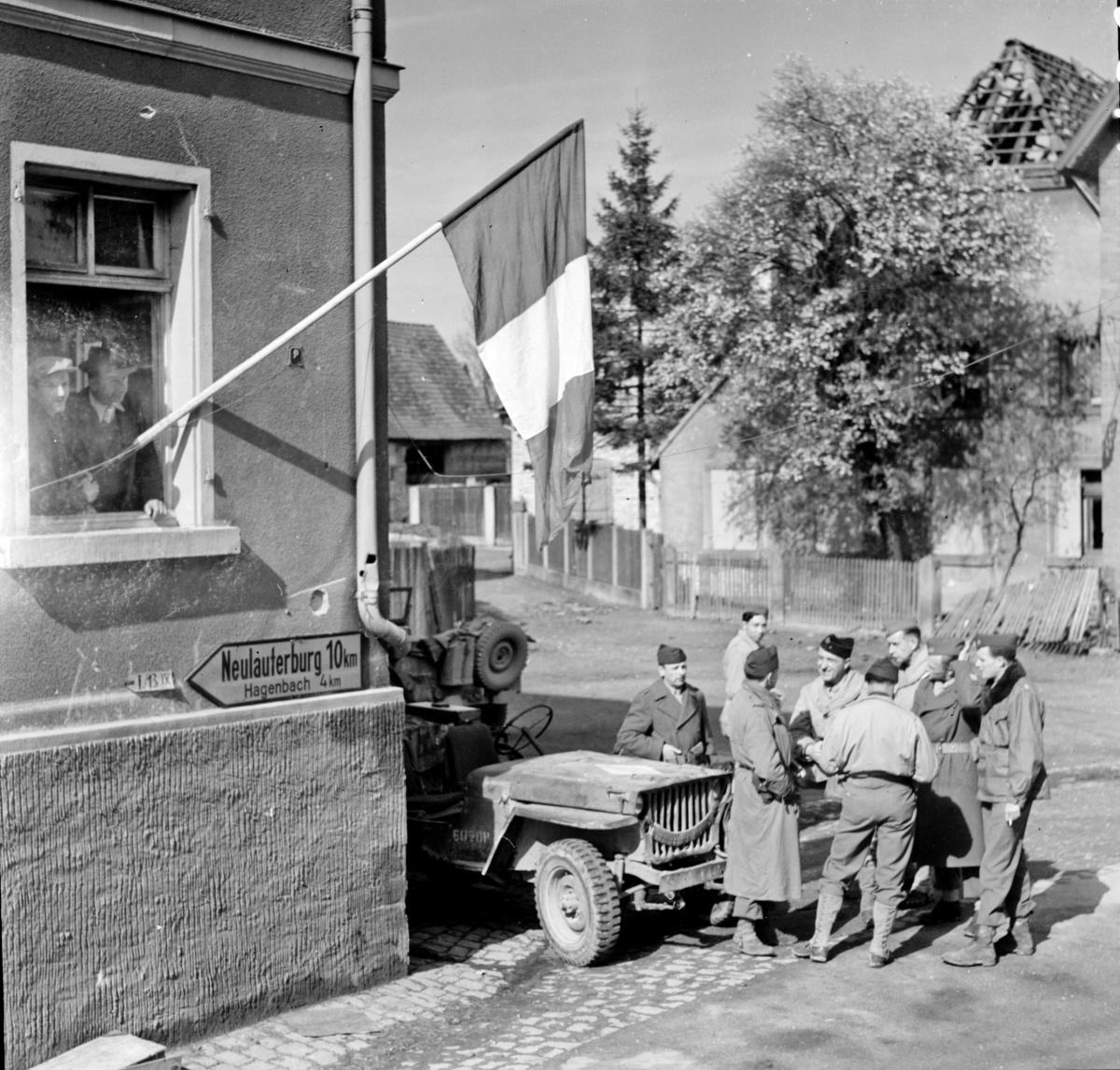
A Pfortz, près de Maximiliansau, le nouveau maire allemand hisse le drapeau tricolore à l'une des fenêtres de la mairie. Mars 1945.
© ECPAD, photographe Jacques Belin. Réf. : TERRE 10214-R47
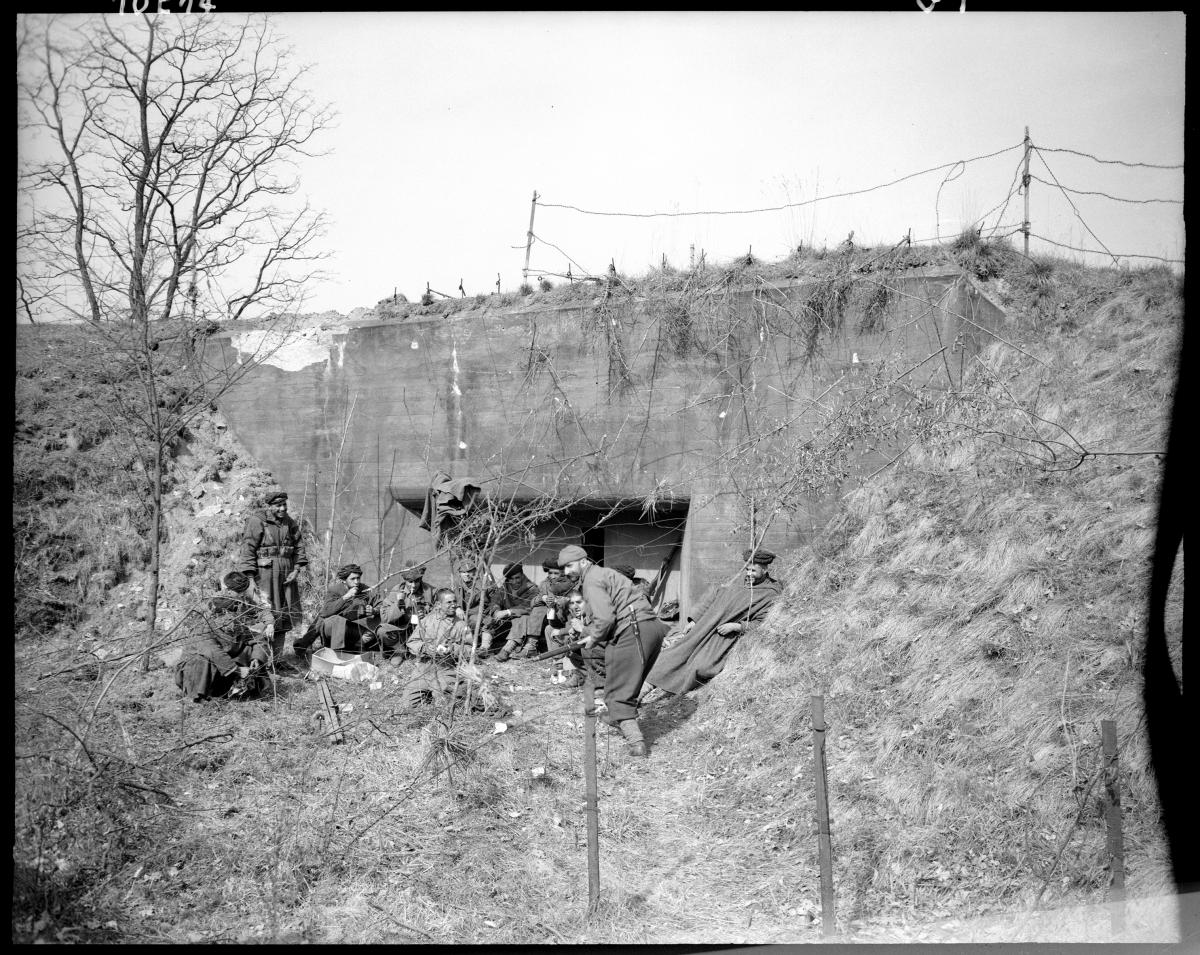
Une section du 49e Goum du 1er GTM (Groupement de Tabors Marocains) se repose devant un des blockhaus de la ligne Siegfried à Lanchelberg (nord-est de Büchelberg). Mars 1945.
© ECPAD, photographe Jacques Belin. Réf. : TERRE 10214-G1
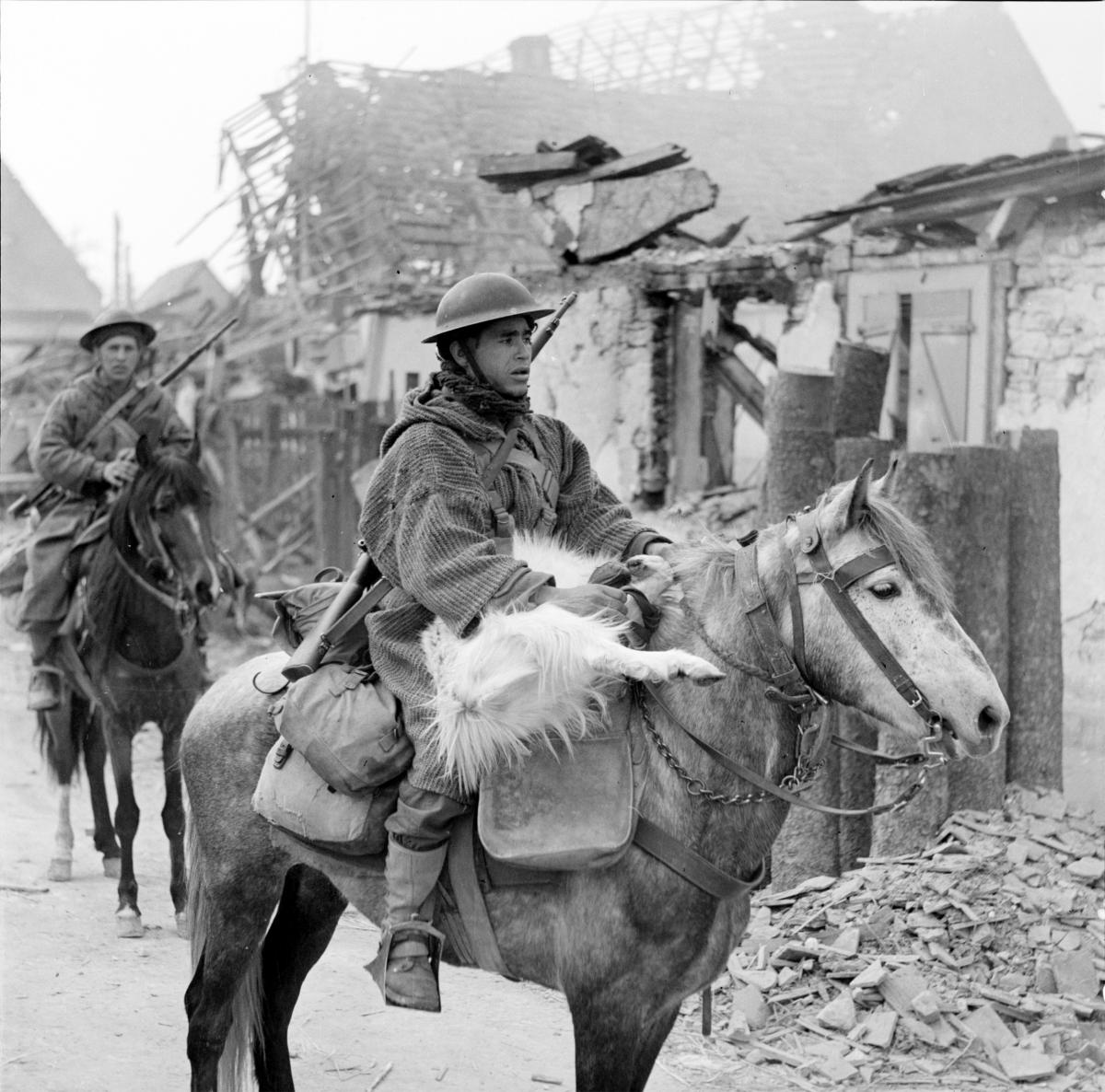
A Büchelberg au delà de la ligne Siegfried, un goumier du 39e Goum à cheval devant les ruines fumantes. Mars 1945.
© ECPAD, photographe Jacques Belin. Réf. : TERRE 10214-R29
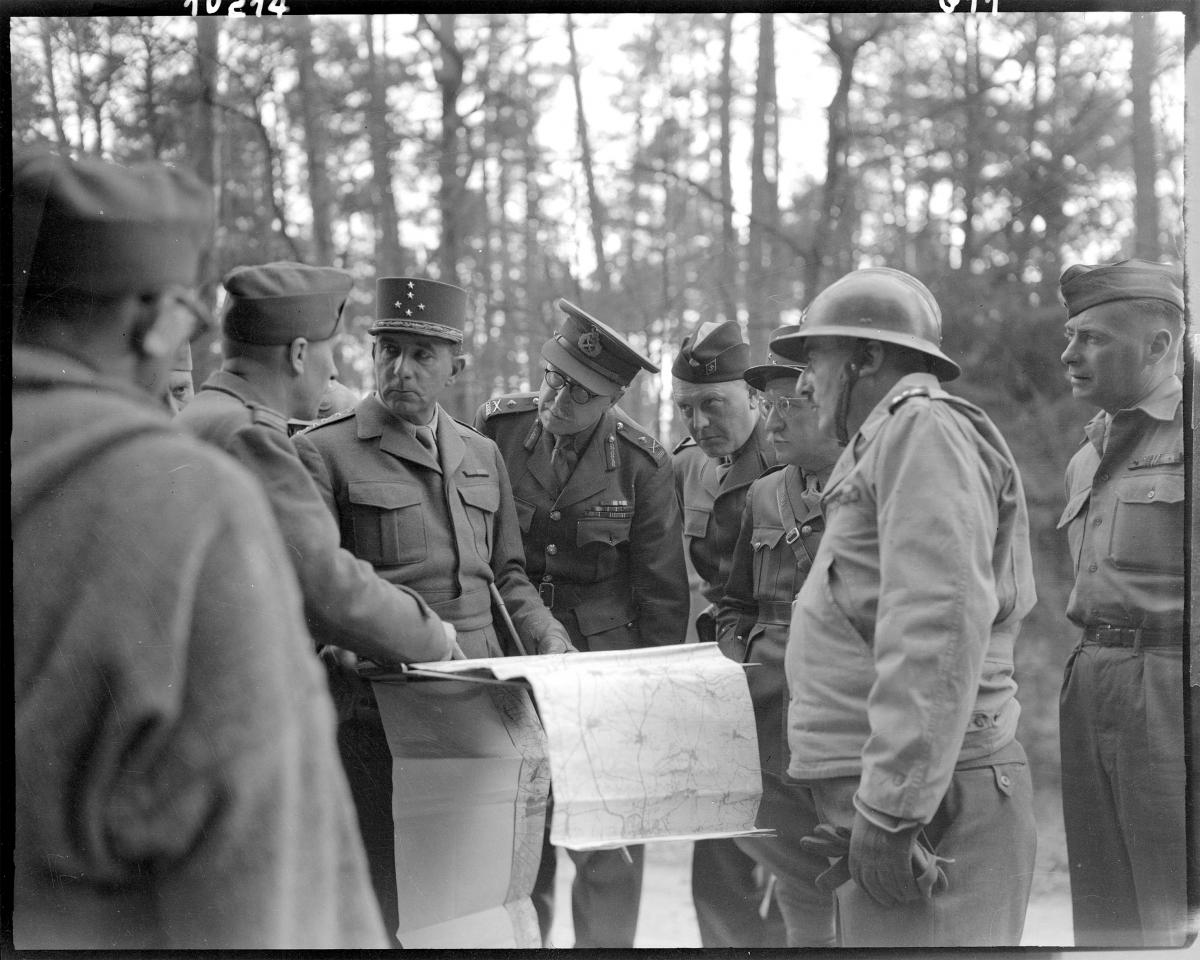
Depuis la cote 132 d'où partirent les goumiers à l'attaque de la ligne Siegfried, les généraux de Lattre, Monsabert et Guillaume se font expliquer par le commandant Henri les détails de la manoeuvre. Mars 1945.
© ECPAD, photographe J. Belin. Réf. : TERRE 10214-G11
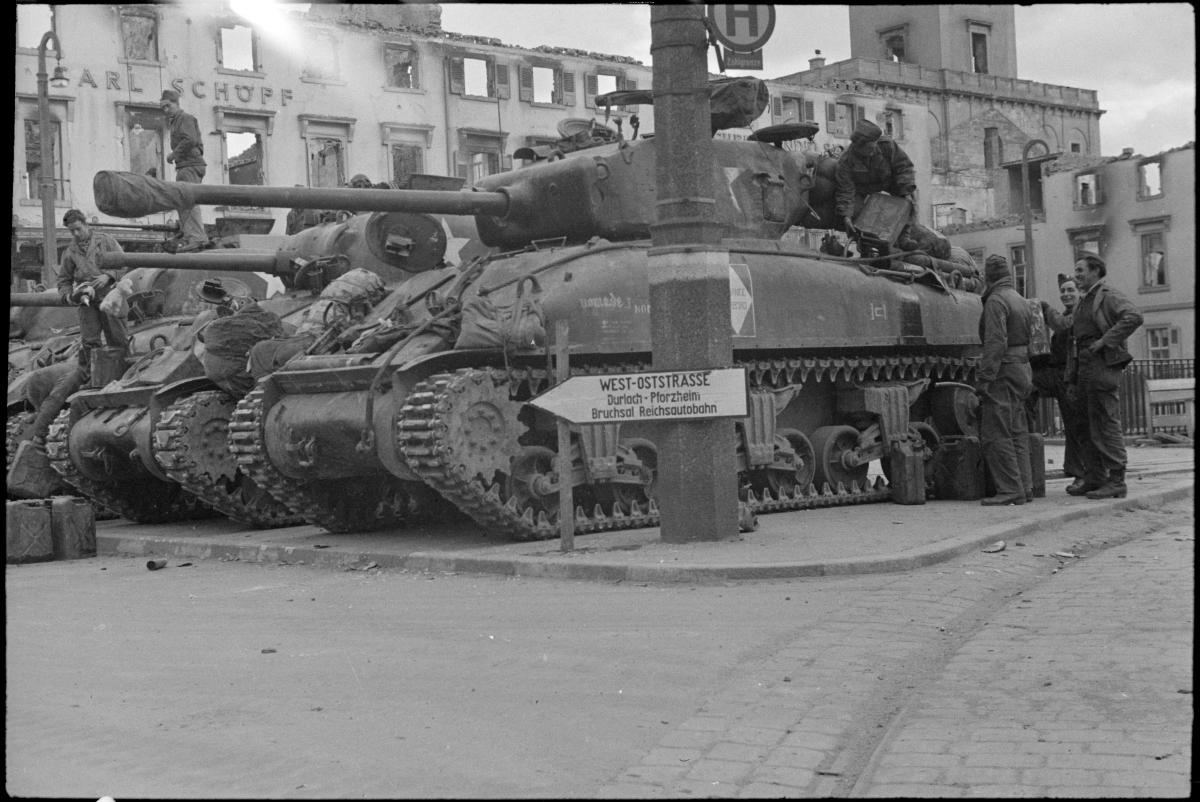
Un détachement du 4e escadron du 1er régiment de Chasseurs d'Afrique de la 5e division blindée dans Karlsruhe, le 4 avril 1945.
© ECPAD, photographe Louis Cadin. Réf. : TERRE 10256-L8
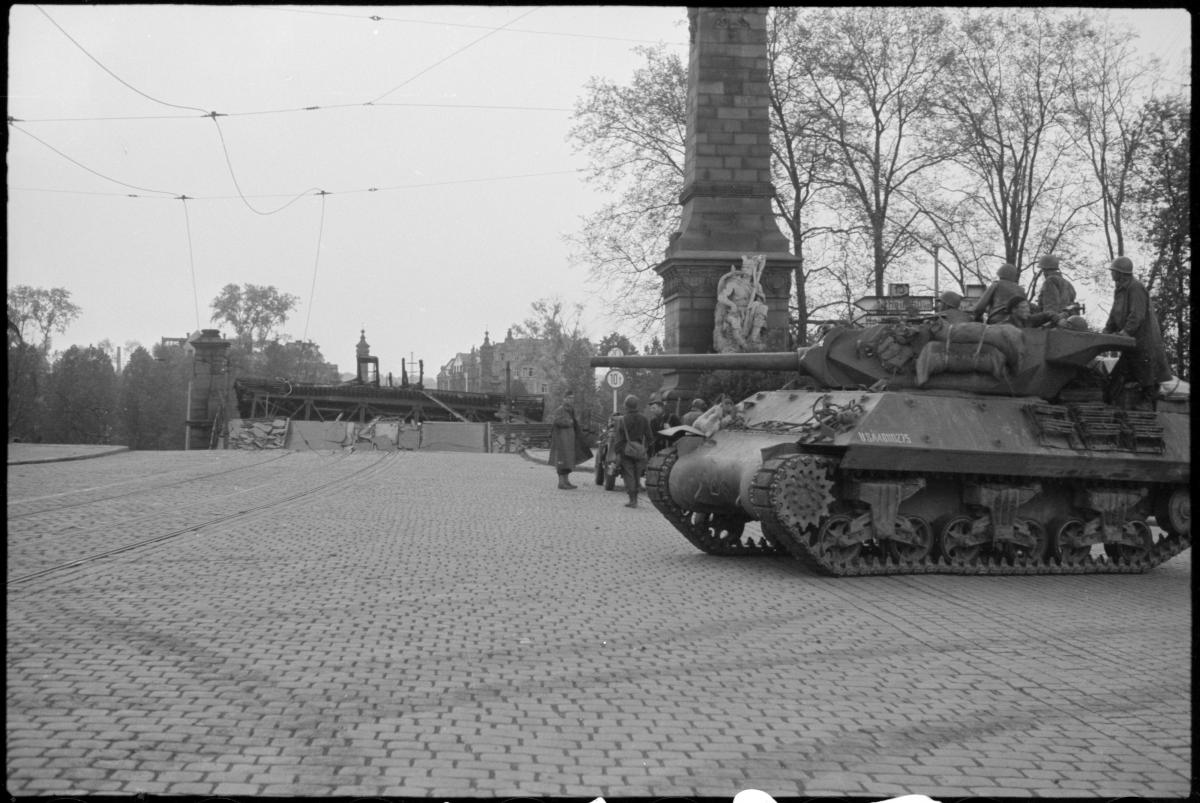
Eléments du Combat Command 6 de la 5e division blindée au pont de Cannstatt à Stuttgart, avril 1945.
© ECPAD, photographe Segal. Réf. : Terre 10323-L123
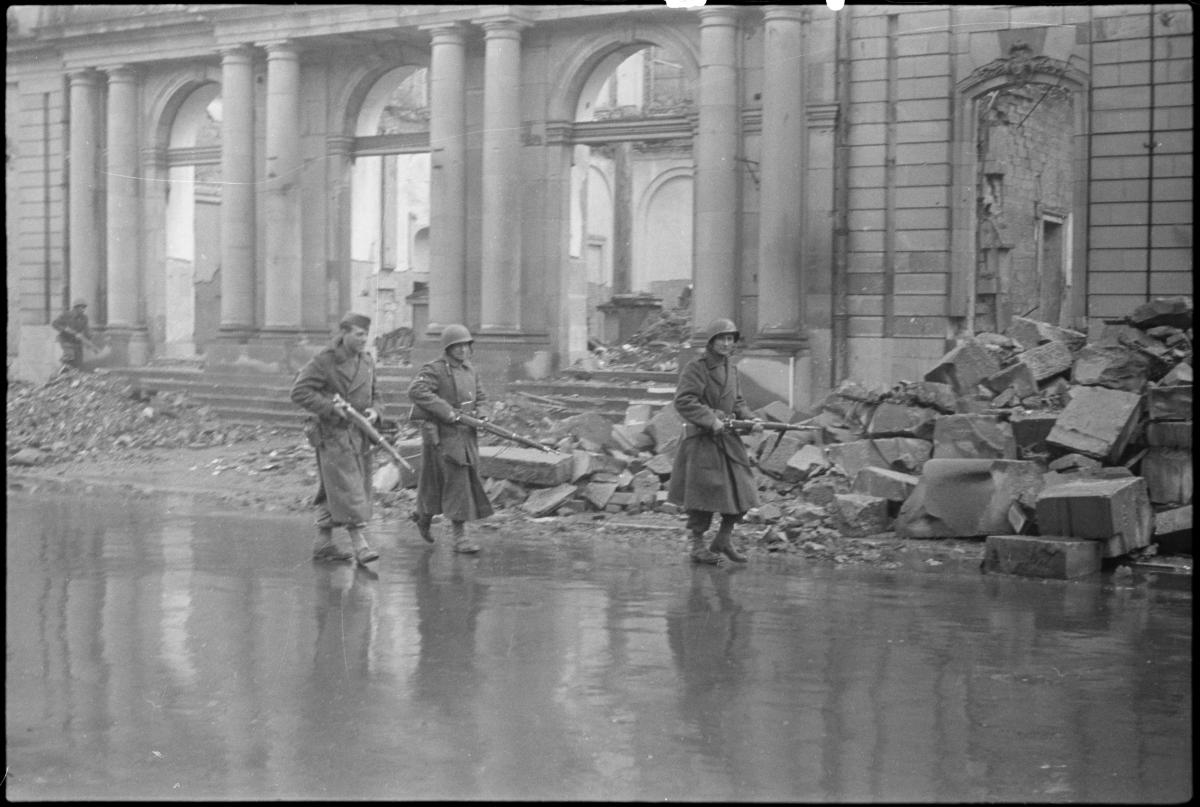
Une patrouille du Combat Command 6 de la 5e division blindée dans Stuttgart, 20-22 avril 1945.
© ECPAD, photographe Brigitte Schreiber. Réf. : TERRE 10325-L4
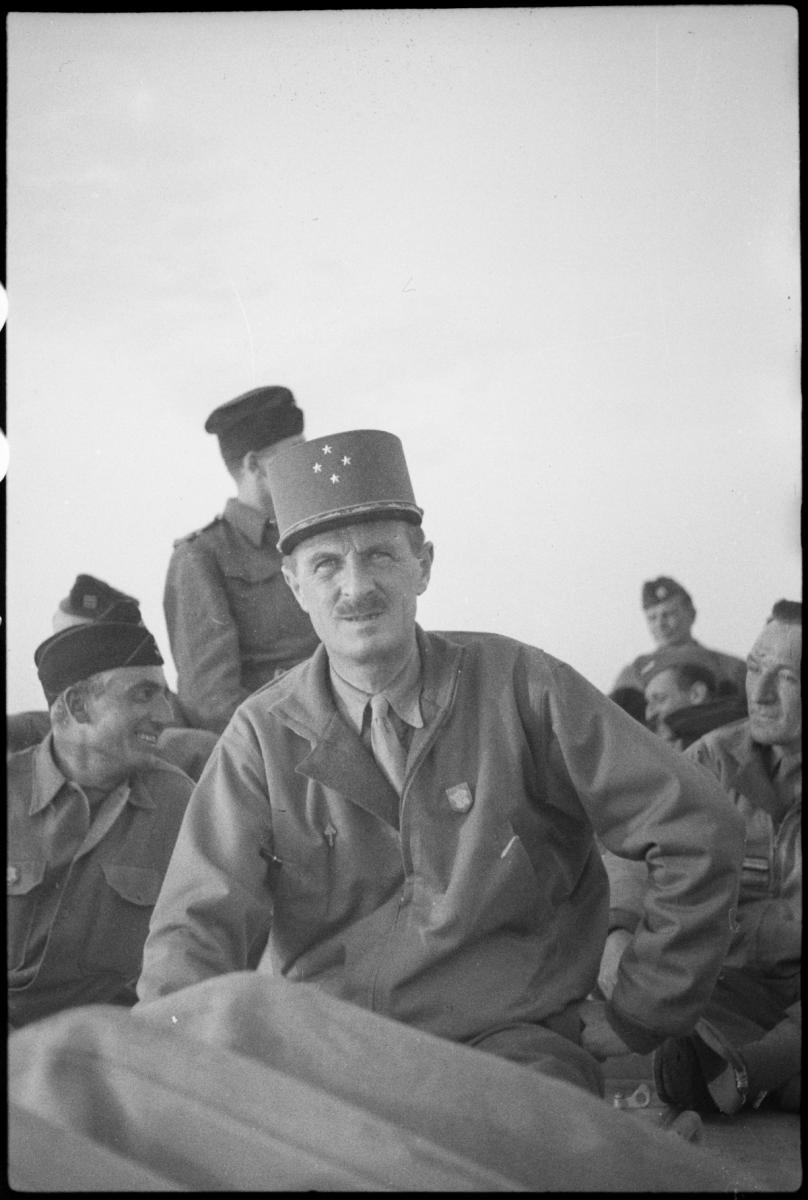
Le général de corps d'armée Leclerc sur le lac d'Ammersee en Bavière, mai 1945.
© ECPAD, photographe inconnu. Réf. : TERRE 10433-L33
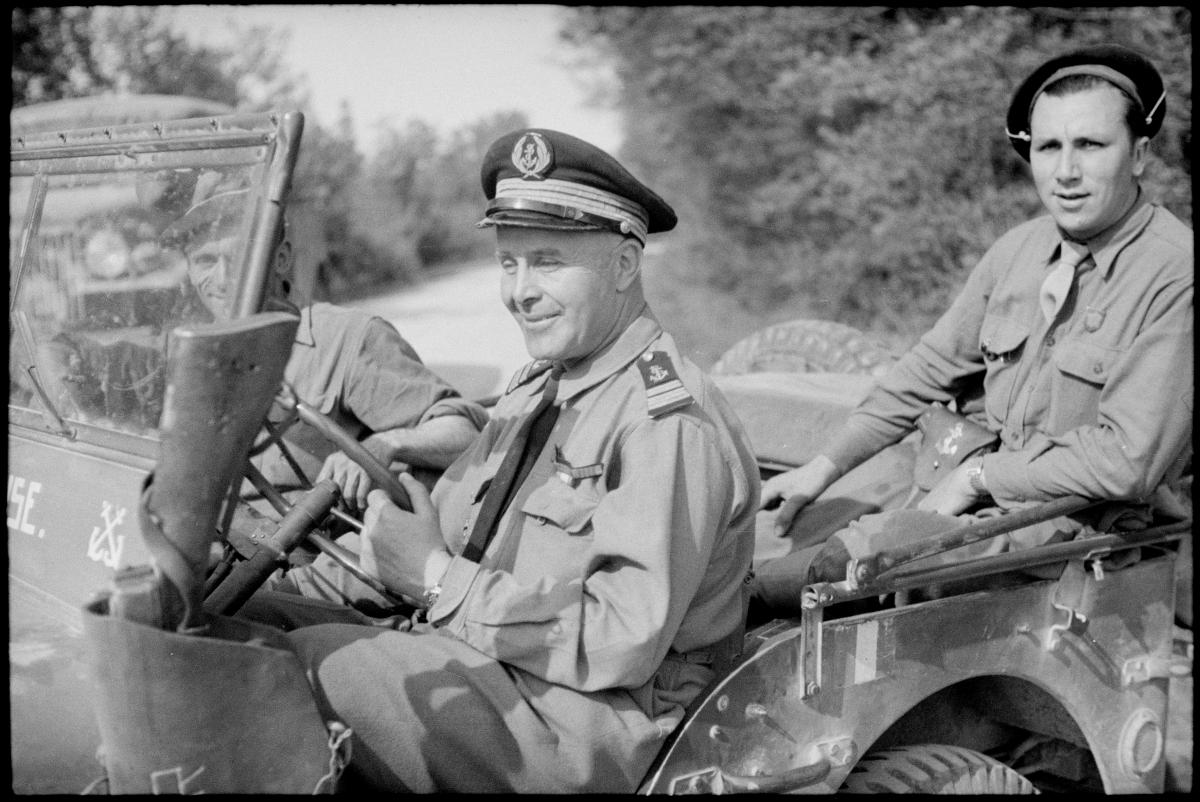
Le capitaine de vaisseau Robert Kilian et son chauffeur dans la jeep "La Curieuse" du RBFM (Régiment Blindé de Fusiliers Marins) lors de l'attaque de la poche de Royan. Avril 1945.
© ECPAD, photographe SCA. Réf. : MARINE 415-8323
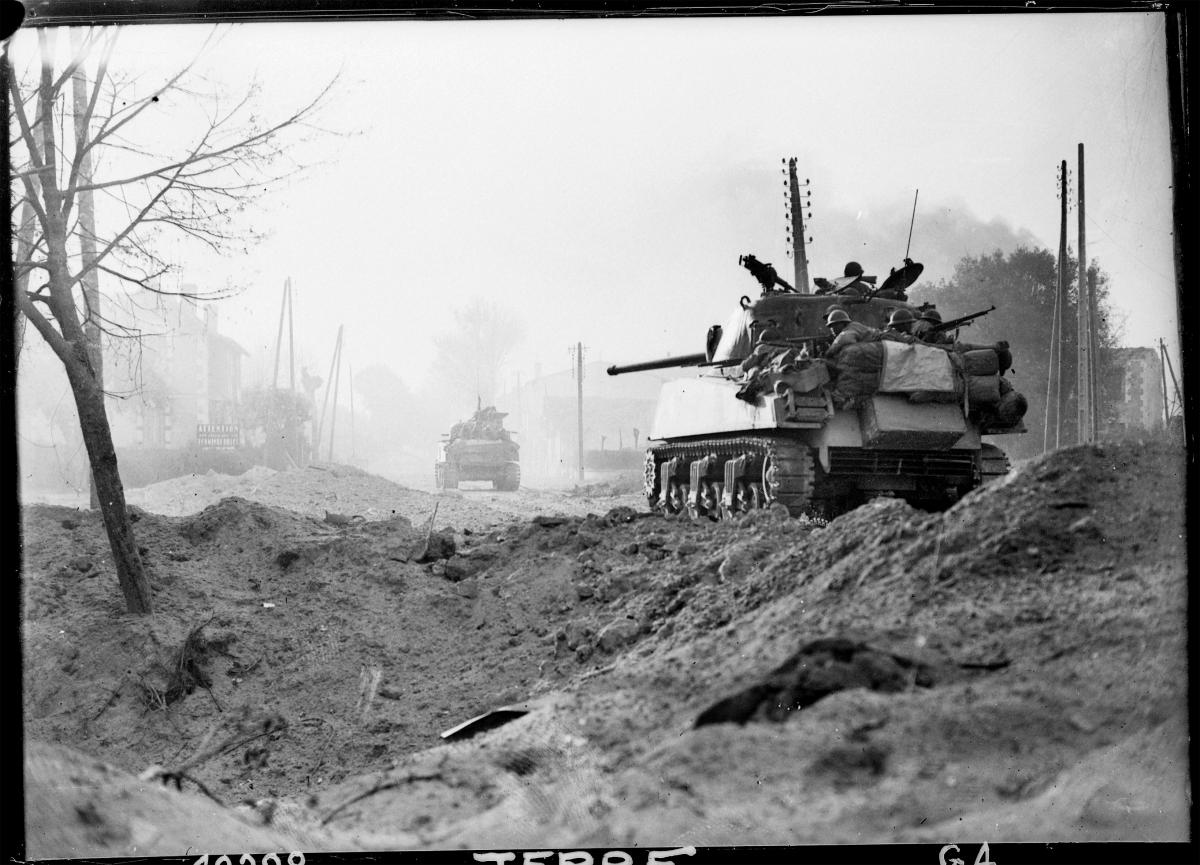
Un char Sherman avance dans Royan, très endommagée par les bombardements aériens et les tirs d'artillerie au moment de la reconquête de la ville par les troupes de la 2e DB (Division Blindée). Avril 1945.
© ECPAD, photographe Henri Malin. Réf. : TERRE 10298-G04
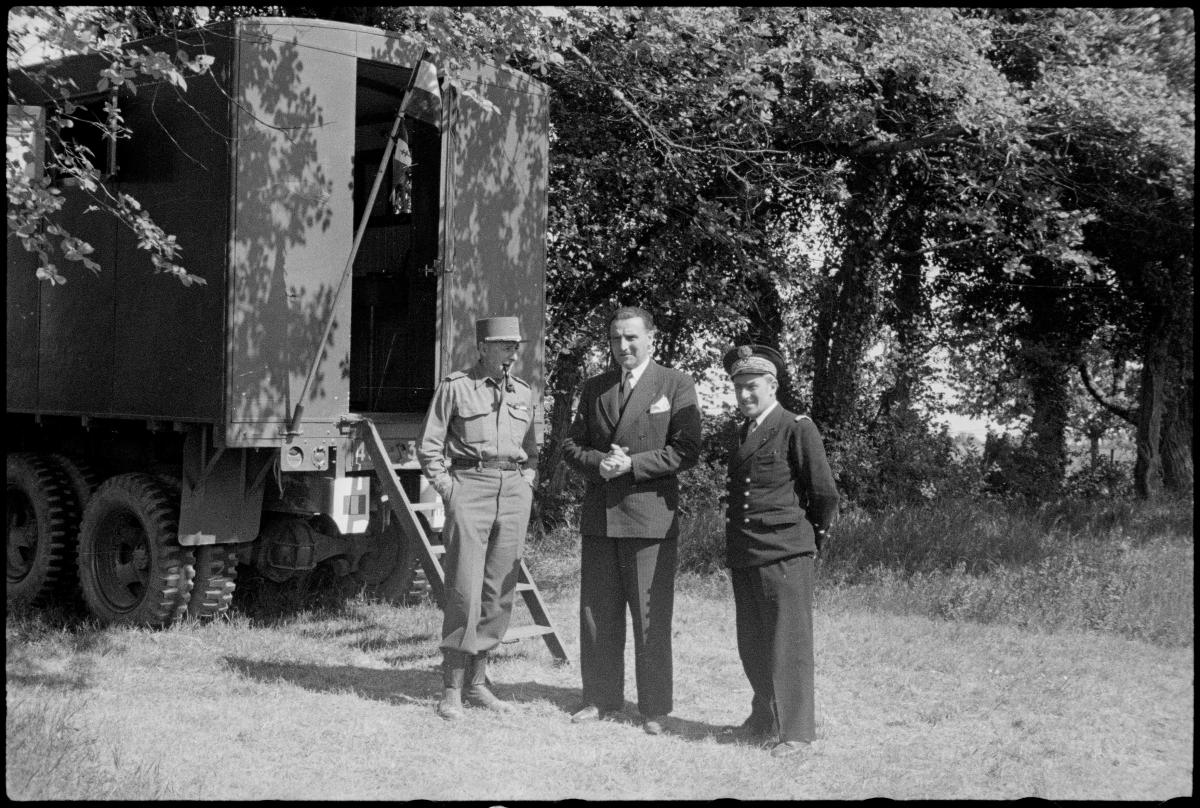
Lors d'une inspection sur le front de la poche de Royan, le ministre de la Marine, Louis Jacquinot et l'amiral Lemonnier rendent visite au général de Larminat à un PC (Poste de commandement) d'unité. Avril 1945.
© ECPAD, photographe SCA. Réf. : MARINE 415-8277
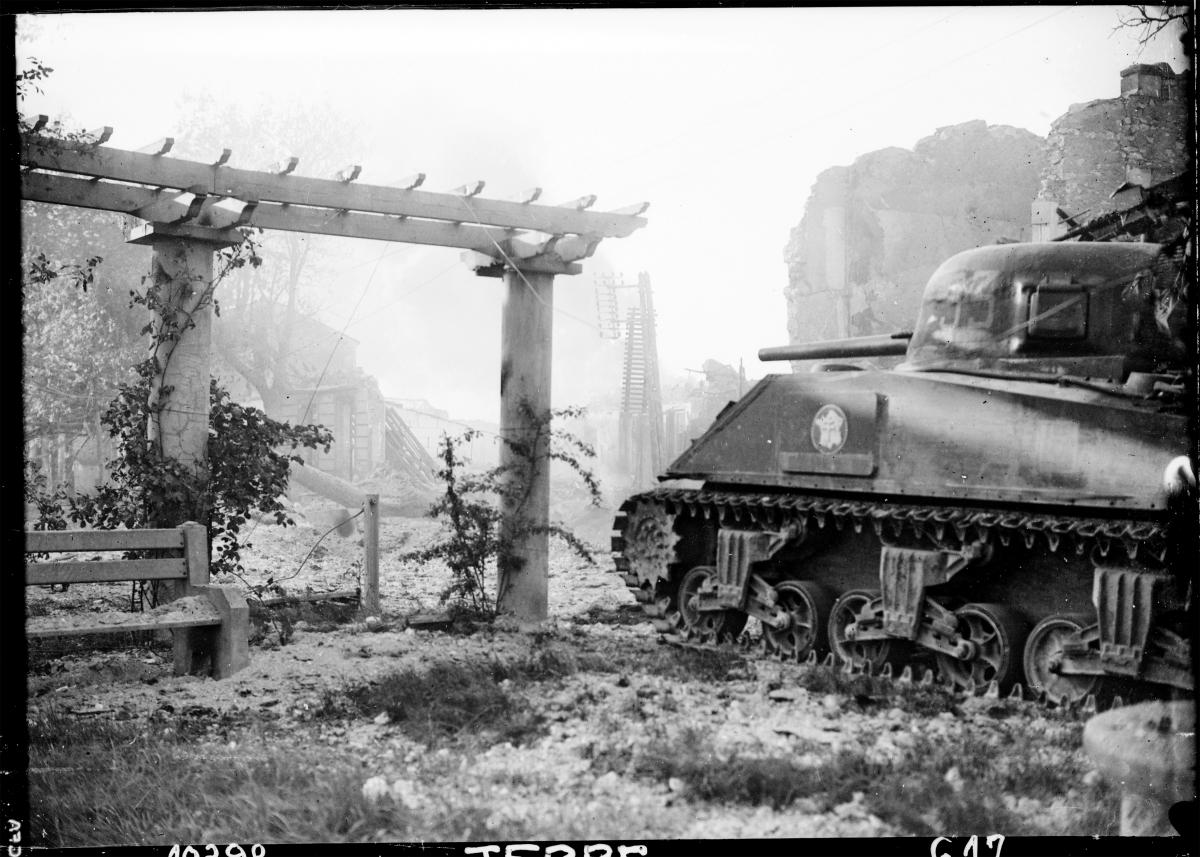
Un char Sherman, probablement du 12e Régiment de Cuirassiers, passe devant les ruines du casino de Royan, au moment de la reconquête de la ville par les troupes de la 2e division blindée. Avril 1945.
© ECPAD, photographe Henri Malin. Réf. : TERRE 10298-G17
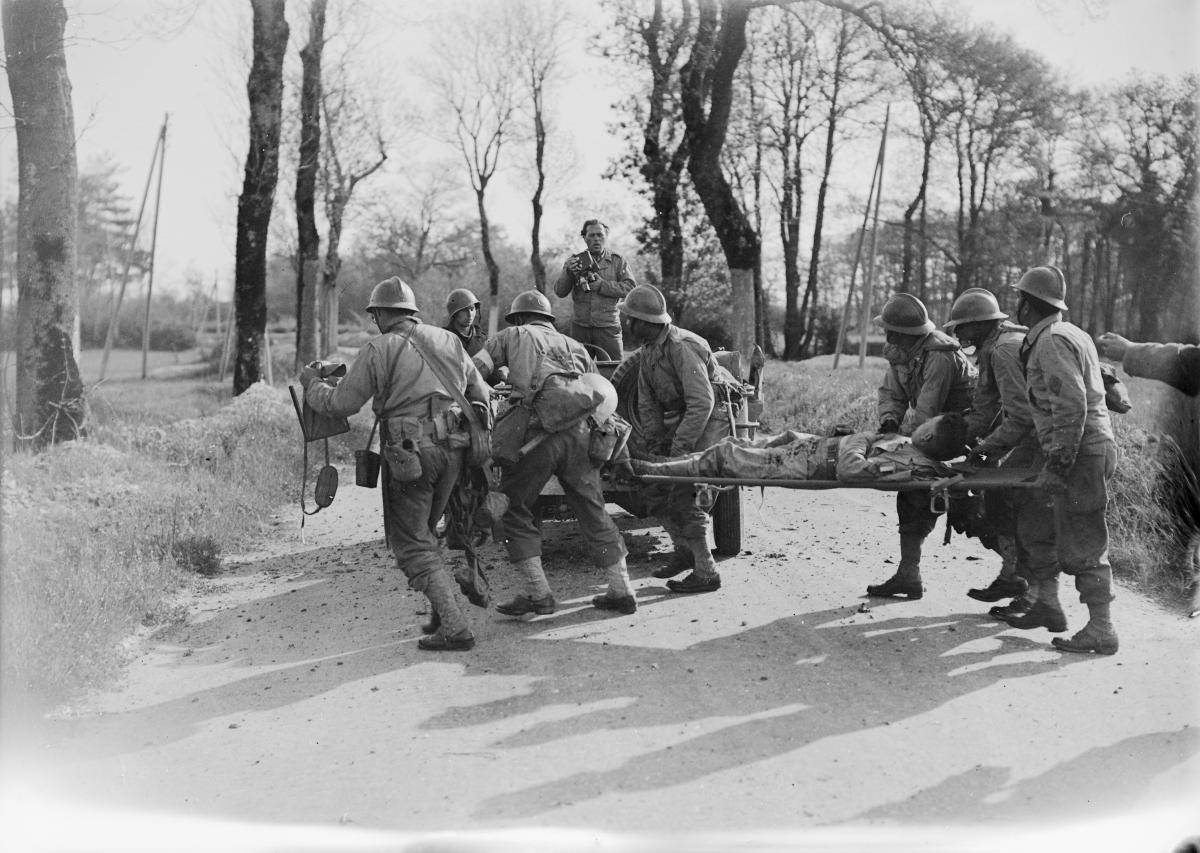
Un blessé est évacué lors de la reconquête de la poche de Royan par les troupes de la 2e DB (Division Blindée), ici les hommes du 4e RZ (Régiment de Zouaves) très probablement. Avril 1945.
© ECPAD, photographe Henri Malin. Réf. : TERRE 10298-G19
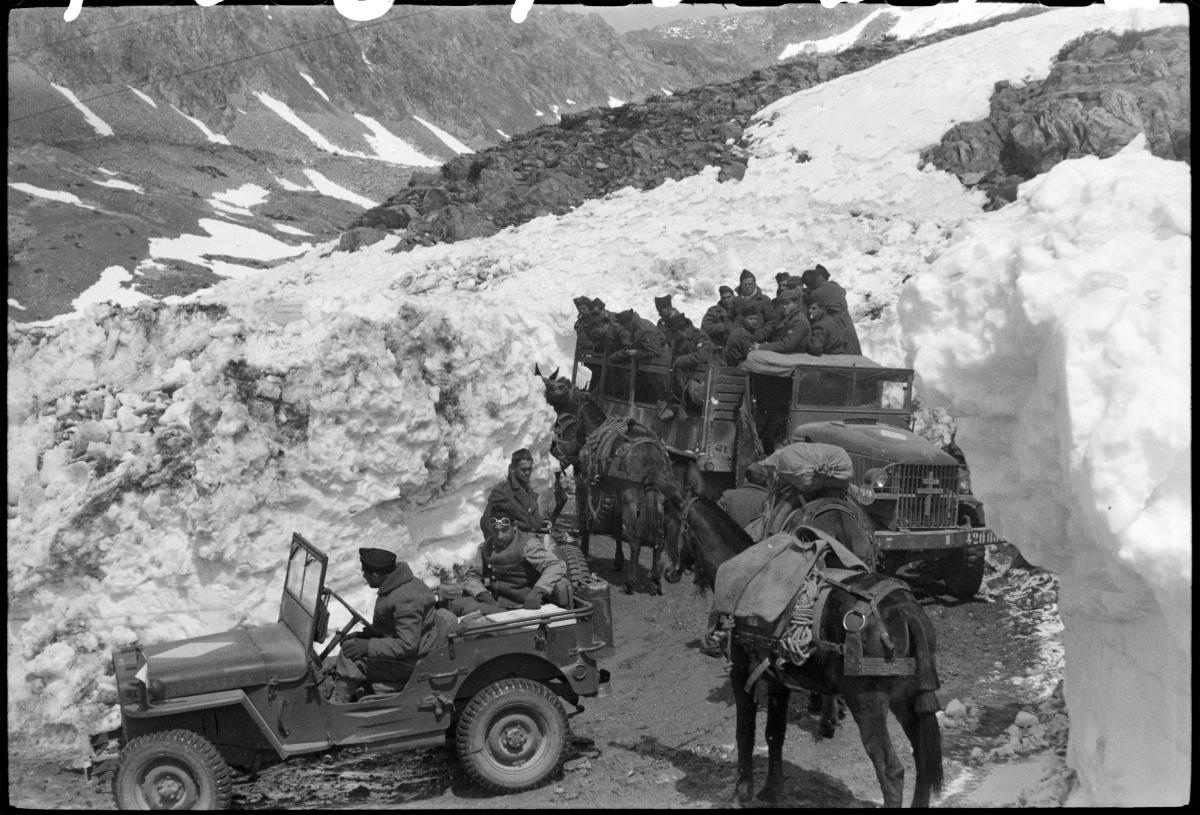
Un convoi auto, avec jeeps et camions GMC de la 1re DFL (Division Française Libre) croise une colonne muletière du Royal Brel Corps britannique sur la route Isola - Vinadio, en direction de l'Italie. Mars-mai 1945.
© ECPAD, photographe Jean-Jacques Tourand. Réf. : TERRE 10379-L72
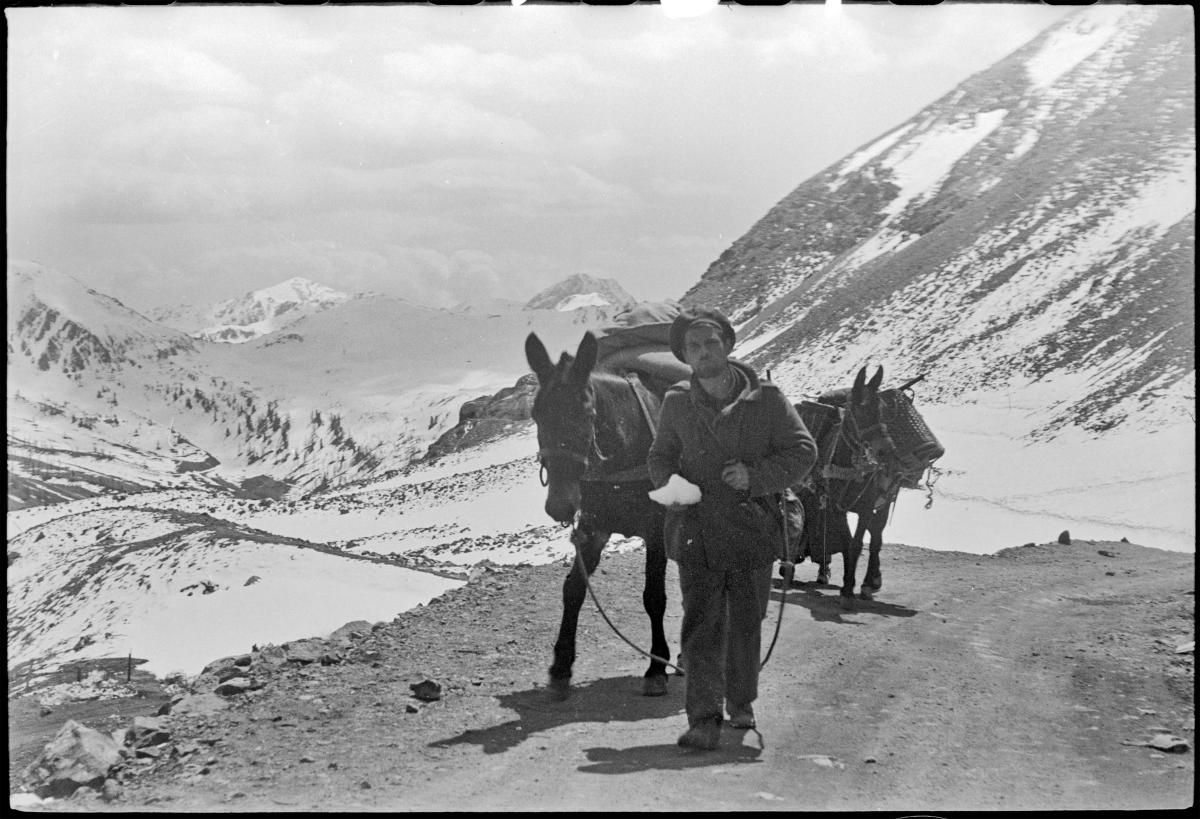
Un soldat de la 1re DFL (Division Française Libre) pénètre en Italie par le col de la Lombarde. Mars-mai 1945.
© ECPAD, photographe Jean-Jacques Tourand. Réf. : TERRE 10379-L61
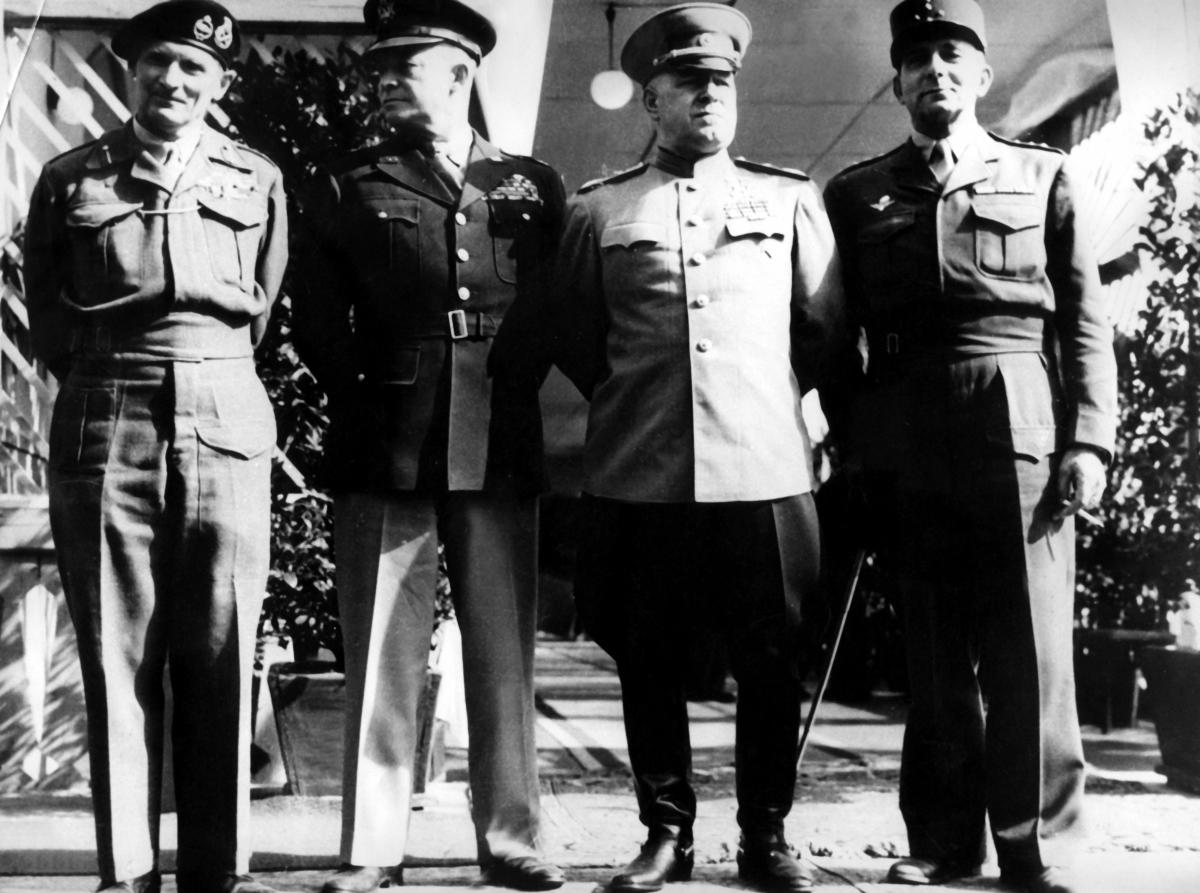
Le 5 juin 1945, le commandement allié à Berlin (de gauche à droite le général Montgommery, le général Eisenhower, le maréchal Joukov et le général de Lattre de Tassigny).
© ECPAD, photographe V. Verdu. Réf. TERRE 10570 G4 RET
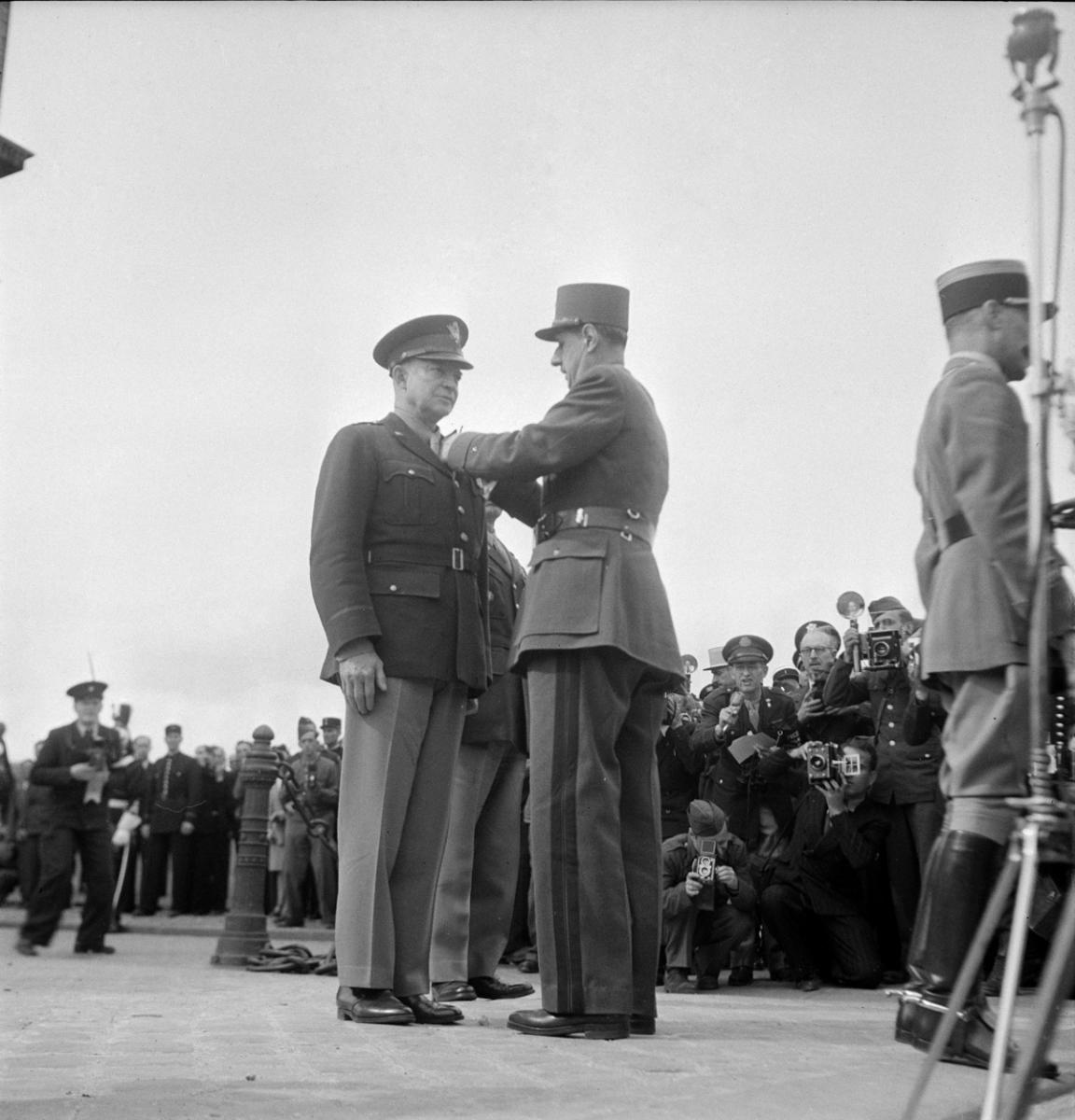
Lors d'une cérémonie à Paris le 14 juin 1945, le général de Gaulle remet la croix de la Libération et la croix de Guerre avec palme au général d'armée Dwight Eisenhower, chef d'état-major de l'armée américaine.
© ECPAD, photographe SCA. Réf. : TERRE 175-3758
Personalities
Related articles
- 1er décembre 1942 - 13 mai 1943. La campagne de Tunisie
- 1943 - 1944. Les Français dans la campagne d'Italie
- 3 septembre 1943 - 2 mai 1945. La campagne d'Italie
- Provence août 1944
- The liberation of Marseille
- Libération de la poche de La Rochelle
- Liberation of the Lorient Pocket
- Libération de la poche de la Pointe de Grave
- The Battle of Bir Hakeim
- Operation Anvil-Dragoon in detail
- 1941. Koufra, la première victoire de la France libre


